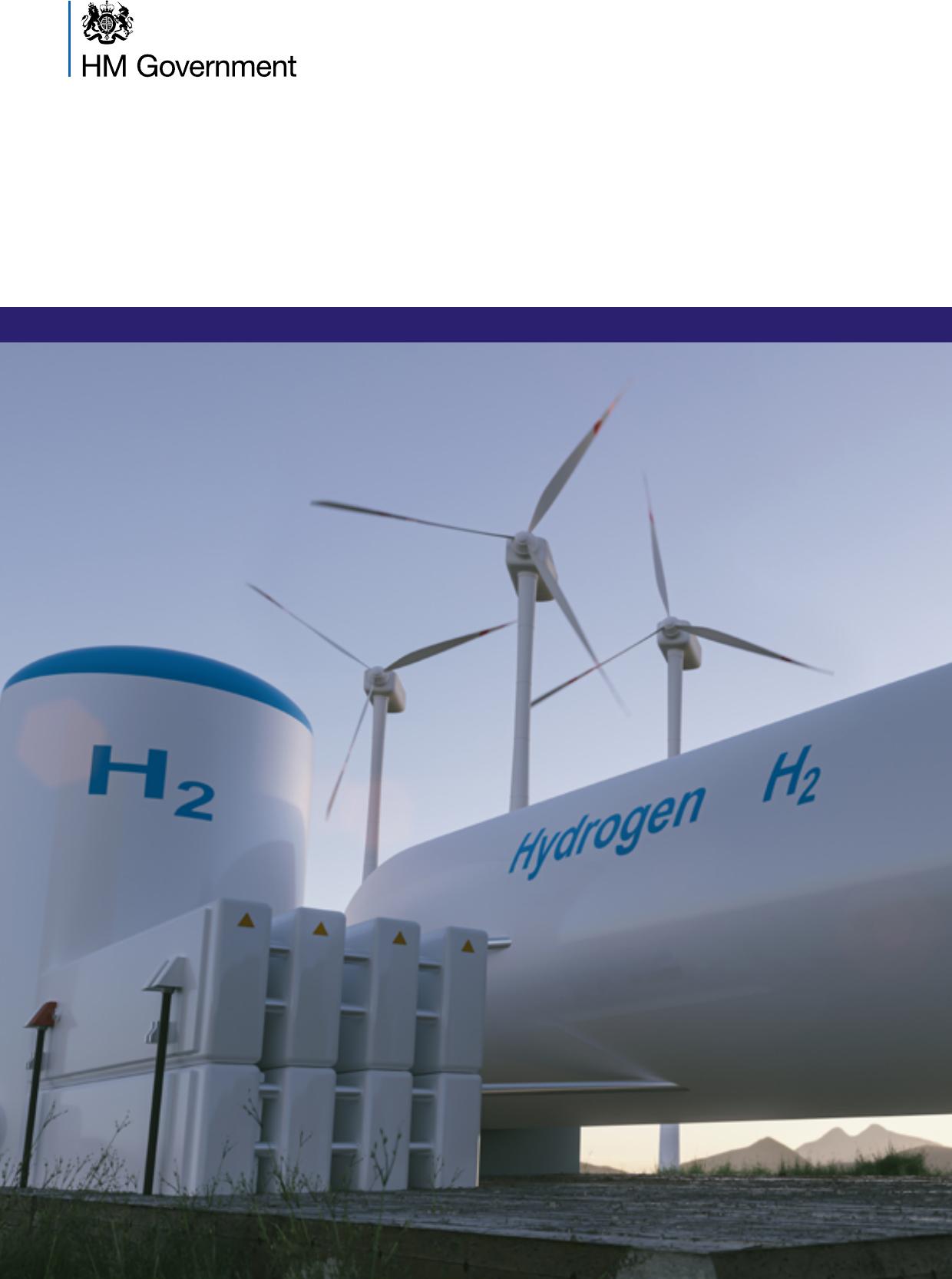UKHydrogenStrategyAugust2021CP475UKHydrogenStrategyPresentedtoParliamentbytheSecretaryofStateforBusiness,Energy&IndustrialStrategybyCommandofHerMajestyAugust2021CP475Wewouldliketoacknowledgethefollowingorganisationsforsupplyingimagesforthisstrategy:Onpage18,imagecreditedtoColinKeldie,providedcourtesyofOrkneyIslandsCouncil.Theimagesonpage35and93wereprovidedcourtesyofITMPower.Onpage36,imageprovidedcourtesyofPalePlueDotEnergy.Onpage61,imageprovidedcourtesyofBaxiHeatingUKLtd.Theimageonpage64isprovidedcourtesyofWrightbus;theimageonpage68isprovidedcourtesyofZeroAvia.©Crowncopyright2021ThispublicationislicensedunderthetermsoftheOpenGovernmentLicencev3.0exceptwhereotherwisestated.Toviewthislicence,visitnationalarchives.gov.uk/doc/open-government-licence/version/3Wherewehaveidentifiedanythirdpartycopyrightinformationyouwillneedtoobtainpermissionfromthecopyrightholdersconcerned.Thispublicationisavailableatwww.gov.uk/official-documentsAnyenquiriesregardingthispublicationshouldbesenttousatie.hydrogen@beis.gov.ukISBN978-1-5286-2670-5CCS062168716408/21Printedonpapercontaining75%recycledfibrecontentminimumPrintedintheUKbytheAPSGrouponbehalfoftheControllerofHerMajesty’sStationeryOffice1ContentsContentsMinisterialforeword2Executivesummary4Chapter1:Thecaseforlowcarbonhydrogen61.1HydrogenintheUKtoday81.2Theroleofhydrogeninmeetingnetzero91.3TheUK’shydrogenopportunity101.4Ourambitionforathrivinghydrogeneconomyby2030121.5AstrategicframeworkfortheUKHydrogenStrategy131.6HydrogeninScotland,WalesandNorthernIreland17Chapter2:Scalingupthehydrogeneconomy202.12020sRoadmap:awhole-systemapproachtodevelopingahydrogeneconomy232.2Hydrogenproduction302.3Hydrogennetworksandstorage392.3.1Networks–hydrogentransmissionanddistribution392.3.2Hydrogenstorage442.4Useofhydrogen502.4.1Useofhydrogeninindustry522.4.2Useofhydrogeninpower572.4.3Useofhydrogeninheatinbuildings612.4.4Useofhydrogenintransport642.5Creatingamarket702.5.1Developingthemarketframeworkforhydrogen73Creatingamarket:Gasblendingtofacilitateanearlyusecaseforhydrogen762.5.2Ensuringasupportiveregulatoryframework792.5.3Raisingawarenessandsecuringbuy-in81Chapter3:RealisingeconomicbenefitsfortheUK843.1Buildingaworldclasssupplychain863.2Creatingjobsandupskillingindustry893.3Maximisingourresearchandinnovationstrengths923.4Attractinginvestment953.5Realisingexportopportunities96Chapter4:Demonstratinginternationalleadership98Chapter5:Trackingourprogress104Fulllistofcommitments110Endnotes1162UKHydrogenStrategyMinisterialforewordAsthePrimeMinistermadeclearwhenhelaunchedhisTenPointPlanforaGreenIndustrialRevolutionlastyear,developingathrivinglowcarbonhydrogensectorintheUKisakeyplankofthegovernment’splantobuildbackbetterwithacleaner,greenerenergysystem.Withthepotentialtoovercomesomeofthetrickiestdecarbonisationchallengesfacingoureconomy–includingourvitalindustrialsectors–andsecureeconomicopportunitiesacrosstheUK,lowcarbonhydrogenhasacriticalroletoplayinourtransitiontonetzero.Workingwithindustry,ourambitionisfor5GWoflowcarbonhydrogenproductioncapacityby2030foruseacrosstheeconomy.Thiscouldproducehydrogenequivalenttotheamountofgasconsumedbyover3millionhouseholdsintheUKeachyear.Thisnew,lowcarbonhydrogencouldhelpprovidecleanerenergytopoweroureconomyandoureverydaylives–fromcookerstodistilleries,filmshootstopowerplants,wastetruckstosteelproduction,and40tonnediggerstotheheatinourhomes.Meetingourambitionmeansrapidrampupofproductionanduseofhydrogenoverthecomingdecade.IneverycountryoftheUK,thereareambitious,world-leadingprojectsreadytodeployatscale,savingcarbonandcreatingjobs.Thesetrailblazerswillhelpusfullyunderstandthecostsaroundhydrogen,itssafetywherehydrogenisbeingusedinnewways,andjusthowfaritcancontributetoreducingouremissions.Thetimeforrealworldactionisnow.WehavedevelopedthefirsteverUKHydrogenStrategytosetoutclearlythekeystepsweneedtotakeinthecomingmonthsandyearstodeliveragainstthepromisethathydrogenpresents–anexcitingmomentfortechnologyproviders,energycompanieslargeandsmall,investors,innovators,andgovernmentatalllevels.Ourambitionforhydrogengoesbeyonddecarbonisation.Italsomeansafocusonsupportingindustrytodevelopsustainable,home-grownsupplychains,createhighqualityjobs,andcapitaliseonBritishinnovationandexpertise.Itmeansincentivisingprivateinvestmentandlookingtoincreaseexportopportunities.Itmeansstrengtheningourindustrialheartlands,boostingoureconomyanddrivingnationalgrowth.3ForewordTheHydrogenStrategybuildsonournationalstrengths.UKcompaniesarealreadyattheforefrontofglobalhydrogentechnologydevelopment.Ourgeology,infrastructureandtechnicalknow-howmakeusideallypositionedtobeagloballeaderinhydrogen.Wehaveastronghistoryofcollaborationbetweengovernment,industryandinnovatorstotackleclimatechangeandgrowoureconomy.AlongsidethisStrategywearealsopublishinganumberofconsultations–seekingviewsonourpreferredHydrogenBusinessModel,thedesignofourflagship£240mNetZeroHydrogenFund,andaUKLowCarbonHydrogenStandard.Thesearepoliciesthatindustry,includingmembersoftheHydrogenAdvisoryCouncilwhichIco-Chair,havetoldusarekeytodriveearlyexpansionoftheUKhydrogeneconomy.ThissubstantialsuiteofdocumentsissupportedbyadetailedAnalyticalAnnexandareportonHydrogenProductionCosts.Takentogether,theUKHydrogenStrategyandsupportingpolicypackagelaythefoundationsforathrivinghydrogeneconomy,onethatcansupportourtrajectorytoachievingourworld-leadingSixthCarbonBudgetandnetzerocommitments.Ilookforwardtocontinuingtoworkcloselywithindustry,innovatorsandinvestorstodeliverrealactiononhydrogen,withrealbenefitsforUKbusinessesandcommunities.TheRtHonKwasiKwartengMPSecretaryofStateforBusiness,Energy&IndustrialStrategy4UKHydrogenStrategyExecutivesummaryHydrogenisoneofahandfulofnew,lowcarbonsolutionsthatwillbecriticalfortheUK’stransitiontonetzero.Aspartofadeeplydecarbonised,deeplyrenewableenergysystem,lowcarbonhydrogencouldbeaversatilereplacementforhigh-carbonfuelsusedtoday–helpingtobringdownemissionsinvitalUKindustrialsectorsandprovidingflexibleenergyforpower,heatandtransport.TheUK’svision,resourcesandknow-howareideallysuitedtorapidlydevelopingathrivinghydrogeneconomy.Ourworld-classinnovationandexpertiseofferopportunitiesforUKcompaniesingrowingdomesticandglobalmarkets.TheUKHydrogenStrategysetsouthowwewilldriveprogressinthe2020s,todeliverour5GWproductionambitionby2030andpositionhydrogentohelpmeetourSixthCarbonBudgetandnetzerocommitments.Thescaleofthechallengeisclear:withalmostnolowcarbonproductionofhydrogenintheUKorgloballytoday,meetingour2030ambitionanddeliveringdecarbonisationandeconomicbenefitsfromhydrogenwillrequirerapidandsignificantscaleupovercomingyears.Theworkstartsnow.TheUKHydrogenStrategytakesaholisticapproachtodevelopingathrivingUKhydrogensector.Itsetsoutwhatneedstohappentoenabletheproduction,distribution,storageanduseofhydrogenandtosecureeconomicopportunitiesforourindustrialheartlandsandacrosstheUK.Guidedbycleargoalsandprinciples,andaroadmapshowinghowweexpectthehydrogeneconomytoevolveandscaleupoverthecomingdecade,theStrategycombinesneartermpaceandactionwithclear,longtermdirectiontounlocktheinnovationandinvestmentcriticaltomeetingourambitions.Chapter1oftheStrategysetsoutthecaseforlowcarbonhydrogen,brieflyoutlininghowitisproducedandusedtodaybeforeexplainingitspotentialroleinmeetingnetzeroandinprovidingopportunitiesforUKfirmsandcitizenstobeattheforefrontoftheglobaltransitiontonetzero.Itexplainshowour2030ambitioncandeliveremissionssavingstohelpmeetourcarbonbudgets,aswellasjobsandeconomicgrowth,helpingtolevelupacrosstheUK.Itsetsoutourstrategicframework,includingourvisionfor2030,theprinciplesguidingouraction,challengestoovercomeandourkeyoutcomesby2030.Finally,itoutlinestheimportantroleofthedevolvednationsintheUK’shydrogenstory,andhowgovernmentisworkingcloselywiththedevolvedadministrationstohelphydrogencontributetoemissionsreductionsanddeliverlocaleconomicbenefitsacrosstheUK.Chapter2formsthecoreoftheStrategy,settingoutourwhole-systemsapproachtodevelopingtheUKhydrogeneconomy.Itopenswithour2020sroadmap,whichsetsoutasharedunderstanding,developedinpartnershipwithindustry,ofhowthehydrogeneconomyneedstoevolveoverthecourseofthedecadeandintothe2030s–andwhatneedstobeinplacetoenablethis.Thechapterthenconsiderseachpartofthehydrogenvaluechaininturn–fromproduction,tonetworksandstorage,touseacrossindustry,5Executivesummarypower,buildingsandtransport–andoutlinestheactionswewilltaketodeliverour2030ambitionandpositionhydrogenforfurtherscaleuponapathwaytoCarbonBudgetSixandnetzero.Finally,itconsidershowwewilldevelopathrivinghydrogenmarketby2030–includingthemarketandregulatoryframeworksunderpinningitandtheirinteractionwiththewiderenergysystem,andtheneedtoimproveawarenessandsecurebuy-infrompotentialusersofhydrogen.Chapter3explainshowwewillworktosecureeconomicopportunitiesacrosstheUKthatcancomefromathrivinghydrogeneconomy–learningfromthedevelopmentofotherlow-carbontechnologiesandbuildingthisintoourapproachfromtheoutset.Itsetsouthowwewill:buildworldclass,sustainablesupplychainsacrossthefullhydrogenvaluechain;creategoodqualityjobsandupskillindustrytodriveregionalgrowthandensurethatwehavetherightskillsintherightplaceattherighttime;maximiseourresearchandinnovationstrengthstoacceleratecostreductionandtechnologydeployment,andtocapitaliseontheUK’sworld-leadingexpertise;andcreateanattractiveenvironmenttosecuretherightinvestmentinUKprojectswhilemaximisingthefutureexportopportunitiespresentedbyalow-carbonhydrogeneconomy.Chapter4buildsonthistoshowhowtheUKisworkingwithotherleadinghydrogennationstodrivegloballeadershiponthedevelopmentoflowcarbonhydrogentosupporttheworld’stransitiontonetzero.ItsetsouttheUK’sactiveroleinmanyofthekeyinstitutionsdrivingmultilateralcollaborationonhydrogeninnovationandpolicy,andourambitiontoactivelyseekopportunitiesforfurthercollaborationwithkeypartnercountriestospurthedevelopmentofthrivingdomestic,regionalandultimatelyinternationalhydrogenmarkets.Chapter5concludestheStrategy,settingouthowwewilltrackourprogresstoensurewearedevelopingaUKhydrogeneconomyinlinewiththeprinciplesandoutcomessetoutinChapter1andourroadmapinChapter2.Thischapterexplainsourapproach–howwewillbeflexible,transparent,efficientandforward-lookinginmonitoringprogress–andsetsoutthepotentialindicatorsandmetricswewillusetotrackhowwearedeliveringagainstouroutcomes.Thiswillhelpensurethatwecandeliverour2030ambitionandrealiseourvisionforalowcarbonhydrogeneconomythatdrivesustowardsCarbonBudgetSixandnetzero,whilemakingthemostoftheopportunitiesthathydrogenholdsfortheUK.Chapter1:Thecaseforlowcarbonhydrogen7Chapter1:ThecaseforlowcarbonhydrogenLowcarbonhydrogenwillbecriticalformeetingtheUK’slegallybindingcommitmenttoachievenetzeroby2050,andCarbonBudgetSixinthemid-2030sonthewaytothis.HydrogencansupportthedeepdecarbonisationoftheUKeconomy,particularlyin‘hardtoelectrify’UKindustrialsectors,andcanprovidegreener,flexibleenergyacrosspower,heatandtransport.Moreover,theUK’sgeography,geology,infrastructureandexpertisemakeitparticularlysuitedtorapidlydevelopingalowcarbonhydrogeneconomy,withthepotentialtobecomeagloballeaderonhydrogenandsecureeconomicopportunitiesacrosstheUK.HydrogenisoneofahandfulofnewlowcarbonsolutionswhichcanhelptheUKtoachieveitsworld-leadingemissionsreductionstargetforCarbonBudgetSix(CB6),andnetzeroby2050.AssetoutinthePrimeMinister’sTenPointPlanforaGreenIndustrialRevolution,workingwithindustry,governmentisaimingfor5GWoflowcarbonhydrogenproductioncapacityby2030foruseacrosstheeconomy.Withvirtuallynolowcarbonhydrogenproducedorusedcurrently,particularlytosupplyenergy,thiswillrequirerapidandsignificantscaleupfromwherewearetoday.TheTenPointPlanannouncednewfundsandpoliciesthatwillsetusonthepathwaytomeetthisambition,including£240millionforgovernmentco-investmentinproductioncapacitythroughtheNetZeroHydrogenFund(NZHF),ahydrogenbusinessmodeltobringthroughprivatesectorinvestment,andplansforarevenuemechanismtoprovidefundingforthebusinessmodel.Continuedimprovementsinhydrogentechnologies,enabledbypioneeringUKresearchandinnovationandinternationalcollaboration,willalsobecritical.TheTenPointPlandesignatedhydrogenasakeypriorityareaintheNetZeroInnovationPortfolio,a£1billionfundtoacceleratecommercialisationoflow-carbontechnologiesandsystemsfornetzero.The2020swillbecriticalforsupportingenergyusersbestsuitedtohydrogenasalowcarbonsolutiontogetreadytouseit.Weareacceleratingworkinthisarea.Wearesupportingfuelswitchingtohydrogeninindustrythroughthe£315millionIndustrialEnergyTransformationFundand£20millionIndustrialFuelSwitchingCompetition;establishingtheevidencebaseforhydrogenuseandstorageinthepowersector;rollingoutdemonstrationcompetitionsandtrials(subjecttofunding)fortheuseofhydrogeninroadfreight,shippingandaviation;andpioneeringtrialsofhydrogenheating–beginningwithahydrogenneighbourhoodtrialby2023,followedbyalargehydrogenvillagetrialby2025,andpotentiallyahydrogentownpilotbeforetheendofthedecade.WeareworkingwiththeHealthandSafetyExecutive(HSE)andindustrytoassessthepotentialfor20percenthydrogenblendingintothegasnetwork,andsupportingthedevelopmentofprototype‘hydrogen-ready’appliancessuchasboilersandcookers.TheEnergyWhitePaper,IndustrialDecarbonisationStrategyandtherecentlypublishedTransportDecarbonisationPlansetoutfurtheractionswearetakingtobringforwardhydrogendemandacrossindustry,power,heatandtransport.ThisStrategygoesfurther,settingoutaseriesofadditionalcommitmentsandactionswhichshowhowgovernment,inpartnershipwithindustry,theresearchandinnovationcommunityandwidercivilsociety,willdeliverourvisionforaUKhydrogeneconomy.8UKHydrogenStrategyByactingnowwewillbebetterpositionedtostimulatedomesticsupplychains,enablingUKbusinessestoserveincreasinginternationaldemandforhydrogengoodsandservices.CurrentevidencesuggestthatdevelopingaUKhydrogeneconomycouldalsosupportover9,000jobsby2030–andupto100,000jobsby2050–acrossourindustrialheartlandsandacrosstheUK.11.1HydrogenintheUKtodayTheUKhasalongstandinghistorywithhydrogen.Sincethediscoveryof‘inflammableair’byHenryCavendishinthemid-18thcentury,hydrogenhasplayedaroleinoureverydaylives,fromhelpingtofertiliseourfieldstoprovidingpartofthe‘towngas’thatlitourstreetsandheatedourhomesuntilthelate20thcentury.Therearealmostnoabundantnaturalsourcesofpurehydrogen,whichmeansthatithastobemanufactured.Themostcommonproductionrouteissteammethanereformation,wherenaturalgasisreactedwithsteamtoformhydrogen.Thisisacarbon-intensiveprocess,butonewhichcanbemadelowcarbonthroughtheadditionofcarboncapture,usageandstorage(CCUS)–toproduceagasoftencalled‘bluehydrogen’.Hydrogencanalsobeproducedthroughelectrolysis,whereelectricityisusedtosplitwaterintohydrogenandoxygen–gasfromthisprocessisoftenreferredtoas‘greenhydrogen’orzerocarbonhydrogenwhentheelectricitycomesfromrenewablesources.TodaymosthydrogenproducedandusedintheUKandgloballyishighcarbon,comingfromfossilfuelswithnocarboncapture;onlyasmallfractioncanbecalledlowcarbon.2Forhydrogentoplayapartinourjourneytonetzero,allcurrentandfutureproductionwillneedtobelowcarbon.CurrentUKhydrogenproductionanduseisheavilyconcentratedinchemicalsandrefineries.3Thishydrogen,largelyproducedfromnaturalgas(withoutcarboncapture),isusedasafeedstock,orinput,intomakingotherchemicalsandplaysavarietyofrolesinrefineriestoconvertcrudeoilintodifferentendproducts.Inthesetwosectors,productionanduseofhydrogenusuallyhappenonthesamesite,oftenintegratedintoasingleindustrialfacility.Hydrogenisalsousedasafuel,infarsmallervolumes,acrosstheUK.Hydrogencars,trucks,busesandmarinevesselsarealreadyoperatingandsupportedbyanetworkofrefuellingstations,withplansforhydrogentrainsandaircraftunderway.Hydrogenwillsoonbeblendedwithnaturalgasandsuppliedsafelytoover650homesaspartofatrialinWinlatoninthenorth-eastofEngland.BritishcompaniessuchasITMPower,JohnsonMattheyandCeresPowerarealreadyproducingthetechnologyforlowandzerocarbonhydrogen,andtheyandmanyothersarepushingnewinnovationsallthetime.TheOrkneyIslandsinScotlandhavegeneratedglobalinterestinarangeofprojectsthatshowhowchallengesinalocalenergysystemcansometimesbeovercomewithhydrogen;hereproducinghydrogenfromexcessrenewableelectricitythatwouldotherwisehasgonetowaste,andusingittosupportdecarbonisationofroadtransport,heatandferryrelatedactivities.AcrosstheUK,pioneeringproductionanduseprojectshaveprovidedlessons,stimulatedfurtherresearchandinnovation,andpointedthewaytowhatisneededtodeployproductioncapacityatpaceandscale,andtounlockhydrogenasalowcarbonfuelfornewapplicationsacrosstheenergysystem.9Chapter1:Thecaseforlowcarbonhydrogen1.2TheroleofhydrogeninmeetingnetzeroLowcarbonhydrogenwillbeessentialforachievingnetzero,andaheadofthat,meetingourworld-leadingCB6targettoreduceemissions78percenton1990levelsby2035.AnalysisbyBEISforCB6suggests250-460TWhofhydrogencouldbeneededin2050,4makingup20-35percentofUKfinalenergyconsumption(seeFigure1.2below).5Thesizeofthehydrogeneconomyin2050willdependonanumberoffactors–includingthecostandavailabilityofhydrogenandhydrogen-usingtechnologyrelativetoalternatives,suchaselectrification,biomassanduseofCCUS.Nonetheless,thereisconsensus,fromtheClimateChangeCommittee(CCC)andothers,thatwewillneedsignificantamountsoflowcarbonhydrogenonthesystemby2050.Figure1.2:Hydrogendemandandproportionoffinalenergyconsumptionin2050010020030040050060035%2030203520402045205020%TWh%=hydrogenasproportionoftotalenergyconsumptionin2050Source:Centralrange–illustrativenetzeroconsistentscenariosinCB6ImpactAssessment.Fullrange–basedonwholerangefromUKHydrogenStrategyAnalyticalAnnex.FinalenergyconsumptionfromECUK(2019).Asagas,hydrogenhasadistinctsetofcharacteristics.Itcanbeusedinafuelcellorcombustedinaboiler,turbineorenginetogenerateheatorelectricity.Itcanalsobestoredinvariousways,includingatverylargescales,andcanbetransportedtodifferentendusers,inmuchthesamewayasnaturalgasorliquidfuelstoday.Hydrogenisalsoanessentialinputtoarangeofchemicalprocessesandinindustrialproduction.Lowcarbonhydrogenwillplayanimportantcomplementaryandenablingrolealongsidecleanelectricityindecarbonisingourenergysystem.Itissuitedtouseinanumberofsectorswhereelectrificationisnotfeasibleoristoocostly,andotherdecarbonisationoptionsarelimited.Thismayincludegenerationofhightemperatureheat,asinindustrialfurnaces,andlong-distanceandheavy-dutytransport.Similarlyitisusefulinareaswhere10UKHydrogenStrategytheflexibilityandstabilityofagasisvalued,forexamplelargescaleorlongdurationenergystorageandflexiblepowergeneration.However,hydrogencanonlybeconsideredasadecarbonisationoptionifitisreadilyavailable,attherightprice,therightvolumeandwithsufficientconfidenceitislowcarbon.Inaddition,potentialusersmustbeabletopurchasehydrogen-usingequipment,withproperassurancesaboutsafetyandreliability.Thiswillbeourfocusforthe2020s,inordertodeliverour2030ambitionandsetusonthepathwaytoCB6andnetzero.1.3TheUK’shydrogenopportunityAsaresultofitsgeography,geology,infrastructureandcapabilities,theUKhasanimportantopportunitytodemonstrategloballeadershipinlowcarbonhydrogenandtosecurecompetitiveadvantage.Buildinghydrogenproductionandenablinguseacrossmultiplesectorswillbecriticalfordevelopingdomesticcapacityandcapabilities,andsecuringgreenjobsacrosstheUK.Developingahydrogeneconomyrequirestacklingthe‘chickenandegg’problemofgrowingsupplyanddemandintandem,andtheUKoffersfavourableconditionsforbothtoreadilyexpand.Whenitcomestoproduction,our‘twintrack’approachcapitalisesontheUK’spotentialtoproducelargequantitiesofbothelectrolytic‘green’andCCUS-enabled‘blue’hydrogen.TheUKreduceditspowersectoremissionsbyover70percentbetween1990and2019,6andgeneratesmoreelectricityfromoffshorewindthananyothercountry.7TheEnergyWhitePaper,publishedinDecember2020,setsouthowwewillexpandrenewablegenerationwhiledecarbonisingpowersectoremissionsfurther,includingthroughourambitiontoquadrupleoffshorewindcapacityto40GWby2030,andpursuenewlarge-scalenuclearwhileinvestinginsmall-scalenucleartechnologies.Thislowcarbonelectricitywillbetheprimaryroutetodecarbonisationformanypartstheenergysystem,andwillalsosupportelectrolyticproductionofhydrogen.TheEnergyWhitePaperalsosetsouthowtheUKwilldeployandsupportCCUStechnologyandinfrastructure,with£1billionofsupportallocatedupto2025andacommitmenttosetoutdetailsofarevenuemechanismtobringthroughearly-stageprivateinvestmentinindustrialcarboncaptureandhydrogenprojects.TheUKhasthetechnology,know-howandstoragepotentialtoscaleupCCUSacrossthecountry,unlockingnewroutestoCCUS-enabledhydrogenproduction.EarlydeploymentofCCUStechnologyandinfrastructurewilllikelybelocatedinindustrialclusters.Manyoftheseareincoastallocations,withimportantlinkstoCO2storagesitessuchasdisusedoilandgasfields.GovernmentaimstoestablishCCUSinfourindustrialclustersby2030atthelatest,supportingourambitiontocapture10Mt/CO2perannum.Inturn,industrialclustersandwiderindustryaresignificantpotentialdemandcentresforlowcarbonhydrogen.Today,numerousindustrialsectorsfromchemicalstofoodanddrinkareexploringtherolethathydrogencanplayintheirjourneytonetzero.UKResearchandInnovation’s(UKRI’s)IndustrialDecarbonisationChallengeprovidesupto£170million–matchedby£261millionfromindustry–toinvestindevelopingindustrialdecarbonisationinfrastructureincludingCCUSandlowcarbonhydrogen.11Chapter1:ThecaseforlowcarbonhydrogenTheUKalsohasdecadesofexperienceinproduction,distribution,storage,useandregulationofgas.Ourwidespreaduseofnaturalgasforpowergenerationandforheatinindustryandhomesmeansthatwehavepotentialsupplyroutesandnumerouspotentialusecasesforhydrogengas.TheUKalsohasfavourablegeologyforlarge-scalestorageofhydrogen,andisalreadystoringhydrogeninsaltcavernsandexploringstorageindisusedoilandgasfieldsundertheNorthSea.Inaddition,ourwell-developedNorthSeaoilandgassectorsandexperienceinrenewablesmeanthattheUKhasdevelopedsupplychainstrengthsandinnovativecompaniesacrossthevaluechainpoisedtotakeadvantageoftheeconomicopportunitiesfromdevelopinglowcarbonhydrogentechnologies.UKcompaniessuchasITMPower,JohnsonMattheyandCeresPowerarealreadyrecognisedasbeingattheforefrontofhydrogentechnologydevelopmentworldwide.Buildingonthisstrongbase,wewilldrawonlessonsfromoffshorewindandotherlowcarbontechnologiesandaimtocapitaliseonourworld-leadingexpertiseinresearchandinnovationanddecarbonisationtoputtheUKattheforefrontofemergingglobalhydrogenmarketsandopportunities.Figure1.3:ProposedUKelectrolyticandCCUS-enabledhydrogenproductionprojectsKeyElectrolyticproductionproject(over5MW)CCUSenabledproductionproject(100MW+)OffshorewindCO2storagepotentialElectrolyticproductionproject(under5MW)Note:Includesplansandproposalsforknownprojectsthatareinthepublicdomain.ManymoreprojectsareunderdevelopmentinallpartsoftheUK.BEISarecontinuingtogatherintelligenceonnewprojectsastheyemerge.12UKHydrogenStrategyTheUKiswellpositionedtobeaworldleaderinlowcarbonhydrogenproductionanduse,deliveringgreenjobsandgrowthtosupportlevellingupacrossourindustrialheartlandsandacrosstheUK.Butwecanonlyrealisetheseeconomicopportunitiesifweactnowtoputinplacethenecessaryenvironmentandsupporttodeveloprobustsupplychains,upskillourpeopleandsecurehigh-qualityjobs,andlaythegroundworktounlockinvestmentandexportopportunities.OurstrategyseekstomaximisetheeconomicbenefitsfromaUKhydrogeneconomyandseizethepotentialofbothdomesticandinternationalmarkets.1.4Ourambitionforathrivinghydrogeneconomyby2030Werecognisetheimportanceofacleargoalalongsidelongtermpolicyframeworksinbringingforwardlowcarbontechnologies.Ourambitionfor5GWoflowcarbonhydrogenproductioncapacityby2030isasignalofthegovernment’sfirmcommitmenttoworkwithindustrytodevelopastrongandenduringUKhydrogeneconomy.Thisambitionisameanstoanend,ratherthananendinitself–positioningtheUKhydrogeneconomyforthescaleupneededtosupportCB6inthemid-2030sandnetzeroby2050,andtodelivercleangrowthopportunitiesacrosstheUK.Weuse“our2030ambition”inplacesthroughoutthisstrategyasshorthandforthiswidervisionfortheUKhydrogeneconomybytheendofthedecade.Itisnotpossibletoday,in2021,topredictwithcertaintythesizeofthefuturehydrogenmarketinanetzeroenergysystem,northebestpathwaytoreachthat.WerecognisethattheUKhashugepotentialtoproduceanduselowcarbonhydrogen,andthatmanyinindustrythinkwecouldgofurtherandfaster.Wewelcomethisdriveandambitionandwillcontinuetoworkwithindustrytodeliverthestrategicdirectionandsupportingpolicyenvironmenttoachieveour2030ambitionandpositiontheUKhydrogeneconomyforthefuturegrowthandscaleupneededforCB6andnetzero.13Chapter1:ThecaseforlowcarbonhydrogenDeliveringour2030ambitionwillyieldsignificantemissionssavings.Ourmodellingsuggeststhattheuseoflowcarbonhydrogenenabledby5GWproductioncapacitycoulddelivertotalemissionssavingsofaround41MtCO2ebetween2023and2032,equivalenttothecarboncapturedby700milliontreesoverthesametimeperiod.8ThiscoverstheperiodoftheUK’sFourthandFifthCarbonBudgets(CB4and5),andwillcontributetoachievingourNationallyDeterminedContribution(NDC)undertheParisAgreementofreducingemissionsby68percentcomparedto1990levelsby2030.Furtherscaleupoflowcarbonhydrogenpost-2030wouldyieldevenlargeremissionssavings,andwillplayanimportantroleindeliveringCB6,tobesetoutinmoredetailinthegovernment’sforthcomingNetZeroStrategy.Our5GWambitionwouldalsomeanthecreationofathrivingnewhydrogenindustry,whichcouldsupportover9,000jobsand£900millionofGVAby2030.9Governmentinvestmentinhydrogentode-riskearlyprojectscouldunlockover£4billionofprivatesectorco-investmentupto2030.10Ourambitionalsosetsusonapromisingpathwaypost-2030.Ouranalysisshowsthat,underahighhydrogenscenario,upto100,000jobsand£13billionofGVAcouldbegeneratedfromtheUKhydrogeneconomyby2050.11Manycountriesaroundtheworldhavesignalledtheimportanceoflowcarbonhydrogeninreducingemissions,andthereisanexpectationthataglobalmarketfortradeinhydrogenwilldevelopinthelongterm.However,itisunlikelythatmarketwillbematureby2030,meaningthattheUKcannot,andwouldnotwantto,relysolelyonlowcarbonhydrogenimports.Anover-relianceonimportscouldcreaterisksaroundthesecurityofsupplyforhydrogenandassociatedinvestmentinthewidervaluechain.ItwouldalsoreduceopportunitiesforUKcompaniestoleveragedomesticcapabilitiesandstrengthsandtranslatetheseintocleangrowthopportunities.Incontrast,movingquicklytodevelopastrongUKhydrogeneconomyby2030canhelpensuresecurityofsupplyandwiderinvestment,createhigh-qualityandsustainablejobs,andpositionUKcompaniestotakeadvantageofopportunitiesininternationalmarkets.Weaspiretotakealeadingglobalroleindevelopinglowcarbonhydrogentechnologiesandmarkets,workingwithourinternationalpartnersincludingthroughexistinginitiativesforcollaboration.ThiswillbeparticularlyimportantintheleaduptotheUKhostingCOP26laterthisyear,asweseektoturbo-chargethedevelopmentanddeploymentoflowcarbontechnologiesthatwillhelpcountriesachievetheircleanenergytransitions–butwillcontinuebeyondCOP26,aswepursueopportunitiestoworkwithotherleadingglobalhydrogennationsinhelpingtobuildaglobalhydrogeneconomy.1.5AstrategicframeworkfortheUKHydrogenStrategyIndevelopingaUKhydrogeneconomy,itwillbeimportantthatwesetclearandconsistentdirectiontogiveindustryandinvestorsconfidenceandcertainty,whilstremainingflexibletoensurethatweactonlearningfromearlyprojectsandcantakedecisionswhichofferthegreatestdecarbonisationandeconomicvalueinthelongterm.Ourstrategicframeworkinformsthepolicydirectionandcommitmentssetoutinthisstrategy,andwillguideouractionsoverthecourseofthe2020stoprovideacoherentlongtermapproach.14UKHydrogenStrategyOurvisionOurvisionisthatby2030,theUKisagloballeaderonhydrogen,with5GWoflowcarbonhydrogenproductioncapacitydrivingdecarbonisationacrosstheeconomyandclearplansinplaceforfuturescaleuptowardsCarbonBudget6andnetzero,supportingnewjobsandcleangrowthacrosstheUK.OurprinciplesOurprincipleswillguidefuturepolicydecisionsandgovernmentaction,providingclarityonfuturepolicydirectionforinvestorsandusers:•Longtermvalueformoneyfortaxpayersandconsumers:TodelivervalueforUKtaxpayersandconsumerswewillseektominimisethecostofaction,anddrivedowncostsoverthelongterm,aswereachforour5GWambitionandbeyondtoCB6andnetzero.•Growingtheeconomywhilstcuttingemissions:Wewillharnessopportunitytocreatenew,high-qualityjobstosupportlevellingup,includingintransitionfromexistinghighcarbonsectors.Wewillensurethattheactionswetakearealignedtoournetzerotarget,recognisingthathydrogenproductionwillneedtobecomeincreasinglylowcarbonovertime.•SecuringstrategicadvantagesfortheUK:WewillnurtureUKcapabilitiesandtechnologicalexpertisetogrownewindustriesofthefuture,sothatUKcompaniescanpositionthemselvesattheforefrontofthegrowingglobalhydrogenmarket.Wewillsupportprivatesectorinnovation,developpolicytomobiliseprivateinvestmentandpromoteUKexportopportunities.•Minimisingdisruptionandcostforconsumersandhouseholds:Wewillbuildonoursuccessfulhydrogenresearchandinnovationtodatetoreducecosts,addressrisksandprovidesafetyandtechnicalassuranceoftechnologiesatcommercialreadiness,focusingon‘learningbydoing’inthe2020stominimisedisruptionandcostforconsumersandhouseholds,andprimetheUKmarketforexpansion.•Keepingoptionsopen,adaptingasthemarketdevelops:Thereareuncertaintiesaroundtheroleofhydrogenin2030andoutto2050,includingthelikelysplitofproductionmethodsandscaleofdemand.Wewillseektoensureoptionalitytodeliveranumberofcrediblepathwaysto2050,bringingforwardarangeoftechnologiesthatcouldsupportour2030ambitionandCB6andnetzerotargets.•Takingaholisticapproach:Wewillfocusonwhatneedstobedoneacrossthewholehydrogensystem,supportingcoordinationacrossallthosewhoneedtoplaytheirpart,andensuringwestayinstepwithdevelopmentsinthewiderenergysystemastheUKdrivestonetzero.15Chapter1:ThecaseforlowcarbonhydrogenWerecognisethattheremaybetrade-offswithinandbetweensomeoftheseprinciplesatanypointintime.Forexample,thelevelisedcostofhydrogenusingelectrolyticproductiontechnologyishighertodaythanforCCUS-enabledhydrogen,anditwilltaketimeforproductiontoreachindustrialscale.Thatsaid,withtherightsupporttoday,thistechnologypresentsagenuineopportunityforexportofUKexpertiseandtechnology,andthereisalsosignificantpotentialforlonger-termcostreductionwithcontinuedinnovation,scaleupofmanufactureandaccesstoincreasedamountsoflow-costrenewableelectricity.Thisisaclearexampleoftheneedtoseekbalanceacrosstheseprinciplesincurrentandfuturepolicydecisions.ChallengestoovercomeThereareanumberofstrategicchallengesacrossthevaluechainthatwillneedtobeovercomeinordertoproduceandusehydrogenatscaleintheUK:•Costofhydrogenrelativetoexistinghighcarbonfuels:Althoughcostsarelikelytoreducesignificantlyandrapidlyasinnovationanddeploymentaccelerate,hydrogeniscurrentlymuchmorecostlytoproduceandusethanexistingfossilfuels.•Technologicaluncertainty:Whilesometechnologyisalreadyinuse,manyapplicationsneedtobeprovenatscalebeforetheycanbewidelydeployed.•Policyandregulatoryuncertainty:Hydrogenisanascentareaofenergypolicy;industryislookingtogovernmenttoprovidecapitalandrevenuesupport,regulatoryleversandincentives,assuranceonqualityandsafety,directiononsupplychainsandskills,andbroaderstrategicdecisions.•Needforenablinginfrastructure:Theuseofhydrogenwillrequirenewnetworksandstorage,aswellasintegrationwithCCUS,gasandelectricitynetworks.•Needforsupplyanddemandcoordination:Developingahydrogeneconomywillrequireovercomingthe‘chickenandegg’problemofneedingtodevelopnewproductionandusecasesintandemandbalancingsupplyanddemand,includingpotentiallythroughstorageovertime.•Needfor‘first-of-a-kind’and‘next-of-a-kind’investmentanddeployment:Scalingupalowcarbonhydrogeneconomywillrequireaddressing‘firstmoverdisadvantage’andotherbarrierstobringforwardearlyprojectswhileestablishingasustainableenvironmentforincreasinginvestmentanddeploymentinthelongerterm.ThechaptersthatfollowdiscussthesechallengesinfurtherdetailandoutlinehowgovernmentwillovercomethemtodevelopathrivingUKhydrogeneconomy.16UKHydrogenStrategyOutcomesby2030Asweheadtowards2030,wewillmeasureoursuccessacrossarangeofstrategicoutcomes:•Progresstowards2030ambition:5GWoflowcarbonhydrogenproductioncapacitywithpotentialforrapidexpansionpost-2030;hopetosee1GWproductioncapacityby2025.•DecarbonisationofexistingUKhydrogensupply:ExistinghydrogensupplydecarbonisedthroughCCUSand/orsupplementedbyelectrolytichydrogeninjection.•Lowercostofhydrogenproduction:Adecreaseinthecostoflowcarbonhydrogenproductiondrivenbylearningfromearlyprojects,morematuremarketsandtechnologyinnovation.•End-to-endhydrogensystemwithadiverserangeofusers:EnduserdemandinplaceacrossarangeofsectorsandlocationsacrosstheUK,withsignificantlymoreendusersableandwillingtoswitch.•Increasedpublicawareness:Publicandconsumersareawareofandacceptuseofhydrogenacrosstheenergysystem.•PromoteUKeconomicgrowthandopportunities,includingjobs:EstablishedUKcapabilitiesandsupplychainthattranslatesintoeconomicbenefits,includingthroughexports.UKisaninternationalleaderandattractiveplaceforinwardinvestment.•EmissionsreductionunderCarbonBudgets4and5:HydrogenmakesamaterialcontributiontotheUK’semissionsreductiontargets,includingthroughsettingusonapathwaytoachievingCB6.•Preparationforrampupbeyond2030–onapathwaytonetzero:Requisitehydrogeninfrastructureandtechnologiesareinplacewithpotentialforexpansion.Wellestablishedregulatoryandmarketframeworkinplace.•Evidence-basedpolicydevelopment:Modellingofhydrogenintheenergysystemandinputassumptionsimprovedbasedonwiderliterature,qualitativeandquantitativeevidenceandreal-worldlearning.Deliveryevidencefrominnovationanddeploymentprojectscollectedandusedtoimprovepolicymaking.Wearedevelopingclearindicatorsandmetricstomonitorprogressagainsttheseoutcomes(setoutinChapter5).Thiswillbeimportanttoensurethatweremainontracktorapidlyscaleupactivityacrossthehydrogenvaluechainoverthecourseofthe2020s–sothatwecanrealiseour2030vision,andcanpositiontheUKhydrogeneconomyforscaleupbeyondthistoCB6andnetzero,whilemakingthemostoftheopportunitiesthathydrogenholdsforUKbusinessesandcitizens.Asourpolicyworkprogresses,wewillprovideregularupdatestotheworkandactionsoutlinedinthisstrategy–withthefirstoftheseupdatesexpectedinearly2022.Weintendtopublishtheseupdatesathalf-yearlyintervalstoprovideaclearsignalofpolicydirectionandprovideindustryandourotherstakeholderswithcertaintyasourthinkingdevelops.17Chapter1:Thecaseforlowcarbonhydrogen1.6HydrogeninScotland,WalesandNorthernIrelandDevelopingahydrogeneconomyisawhole-UKstory,withpotentialtoproduceanduselowcarbonhydrogenrightacrosstheUKandprovidelocaleconomicbenefits,insupportofUKanddevolvedadministrationnetzeroplans.Thegovernmentisworkingwiththedevolvedadministrationstosupportresearchandinnovationanddeploymentoflowcarbonhydrogentechnologies,andtherearealreadypioneeringprojectsandcompaniesproducingandusinglowcarbonhydrogenacrossScotland,WalesandNorthernIreland.ScotlandhasakeyroletoplayinthedevelopmentofaUKhydrogeneconomy,withthepotentialtoproduceindustrial-scalequantitiesofhydrogenfromoffshoreandonshorewindresources,waveandtidalpower,aswellaswithCCUS–supportedbyastrongcompanybaseandvaluableskillsandassetsinoilandgas,offshorewind,andenergysystems.EconomicanalysisfortheScottishGovernmentsuggeststhatScotlandcoulddeliver21-126TWhofhydrogenperyearby2045,withupto96TWhofhydrogenforexporttoEuropeandtherestoftheUKinthemostambitiousscenario,deliveringsignificantjobsandlocaleconomicbenefits.12TheScottishGovernmentpublishedaHydrogenPolicyStatementinDecember2020,whichsetouttheirvisionforthedevelopmentofahydrogeneconomyinScotlandandambitionsforrenewableandlowcarbonhydrogengeneration.AHydrogenActionPlanwillbepublishedlaterthisyear,supportedbya£100mprogrammeofinvestmentfrom2021to2026.13Scotlandishometoanumberofworld-leadinghydrogendemonstrationprojectsthatarehelpingdeterminetherolethathydrogencouldplayinScotlandandtheUK’sfutureenergysystem.TheEuropeanMarineEnergyCentreintheOrkneyIslandshasa£65millionportfolioofrenewablehydrogenprojectsthatisstillgrowing–providingasmaller-scaleexampleofelementsofahydrogeneconomy(seecasestudybelow).Aberdeenishost18UKHydrogenStrategyto25hydrogendoubledeckerbuseswhichhavehelpedestablishtheinfrastructuretosupportanecosystemofover60hydrogenfuelledvehiclesofmanyshapesandsizes–acatalystfortheAberdeenHydrogenHubinitiative,whichseekstobecomeoneofthekeymodelhydrogenregionsinEurope.TheH100neighbourhoodtrialprojectinFifeisbuildinga100percentelectrolytichydrogenproductionanddistributionnetworkandinstalling300homeswithnewhydrogenboilerstodemonstratehydrogenfordomesticheatingintheUK(seecasestudyatChapter2.4.3).InMarch2021,theUKandScottishGovernmentalsooutlinedplanstoeachinvest£50maspartofHeadsofTermsfortheIslandsGrowthDeal,tosupportthefutureeconomicprosperityofOrkney,ShetlandandtheOuterHebrides,includingseveralprojectsprovidingsupportforhydrogen.14OrkneyIslands:BIGHITprojectBIGHIT(BuildingInnovativeGreenHydrogenSystemsinIsolatedTerritories)isasix-year,Orkneybaseddemonstrationprojectwhichaimstocreateanintegratedlowcarbonandlocalisedenergysystemestablishingareplicablemodelofhydrogenproduction,storage,distributionanduseforheat,powerandtransport.FundedbytheFuelCellsandHydrogenJointUndertaking,theprojectbuildsonOrkney’sSurf’n’Turfproject–aninnovativecommunityrenewableenergyprojectusingwindandtidalenergytoproducehydrogen.State-of-the-artProtonExchangeMembrane(PEM)electrolysersinEdayandShapinsayIslandsproducehydrogenfromelectrolysis,usinglocallygeneratedwindandtidalenergy.Thishydrogenisstoredandusedforheat,powerandtransportinthesurroundingarea.BIGHITpositionsOrkneyasanoperationalandreplicablesmallscaleHydrogenTerritory:thelearningfromBIGHITwillsupportwiderreplicationanddeploymentofrenewableenergywithfuelcell&hydrogentechnologiesinisolatedorconstrainedterritories.19Chapter1:ThecaseforlowcarbonhydrogenWaleshassignificantopportunitiesforlowcarbonhydrogenproductionanduse.Itsoffshorewindandtidalandwavepowerpotential,stronginfrastructurenetworksandports,researchanddevelopmentstrengths,skillsbaseandreadilyavailableinternalmarketsprovideaplatformfordeploymentofhydrogenandfuelcelltechnologiesunderafavourablepolicyenvironment.TheWelshGovernmentpublishedahydrogenpathwayreportinDecember202015andisnowfinalisingitsstrategicpositiononhydrogen,whichitwillpublishinearlyautumn2021.AcomplementaryWelshHydrogenBusinessResearchandInnovationforDecarbonisation(H2BRID)initiativeisalsobeingdevelopedforlauncharoundthesametimetosupportthechallengessetbytheWelshhydrogenpathwayandinvestininnovativehydrogenprojectsacrossWales.Walesishometoseveralpioneeringhydrogencompanies,projectsandresearchclusters.WelshSMERiversimpleisdesigning,buildingandtestinginnovativehydrogenfuelcellelectricvehicles.TheDolphynFLOWstudyisexploringthefeasibilityofa100-300MWcommercialhydrogenwindfarmoffSouthWales,tobeexpandedinfuture,withhydrogenpipelinestostrategiclocationsalongtheMilfordHavenwaterwayfortransportandheatapplications,andpotentiallytoPembrokeDockformarineoperations.TheHydrogenCentre,partoftheBaglanEnergyParkatNeathPortTalbot,isthefocalpointforaseriesofcollaborativeprojectsbetweentheUniversityofSouthWalesandotheracademicandindustrialpartners.TheCentrefocusesonexperimentaldevelopmentofrenewablehydrogenproductionandnovelhydrogenenergystorage,aswellasfurtherresearchanddevelopmentofhydrogenvehicles,fuelcellapplicationsandhydrogenenergysystems.TheUKGovernmentalsorecentlyannouncedcapitalfundingofupto£4.8m(subjecttobusinesscase)fortheHolyheadHydrogenHub,ademonstrationhydrogenproductionplantandfuellinghubforHGVstoservefreighttrafficatHolyheadandport-sidevehicles,whichcouldbeoperationalby2023.NorthernIrelandislikewisewell-positionedtoacceleratehydrogeninnovationanddeployment,withitssignificantwindresource,moderngasnetwork,interconnectiontoIrelandandGreatBritain,availabilityofsaltcavernstorageandstrongreputationforengineeringandmanufacturing.NorthernIrelandWaterwillbeprocuringanewelectrolyserforoneofitswastewatertreatmentworks–thefirstprojectofitskindintheUK.Thepublictransportoperator,Translink,isintroducingnewhydrogenbusesbuiltbylocalcompanyWrightbusinBallymenaandisprocuringanewhydrogenfuellingstation.TheGenCommprojectledbyBelfastMetropolitanCollegehasreceivedfundingfromboththeEUandUKGovernmenttotrialhydrogenproductionviaelectrolysisforhydrogenbuses.TheDepartmentfortheEconomyiscurrentlyconsultingonpolicyoptionsforanewEnergyStrategy,includingonhydrogen,whichwillsetoutNorthernIreland’senergyfocusanddirectionto2050andisexpectedtobepublishedattheendoftheyear.TheUKGovernmentiscommittedtoworkingcloselywiththedevolvedadministrations–includingthroughthejointgovernment-industryHydrogenAdvisoryCouncil–toharnesstheUK’sfullpotentialtodevelopaworld-leadinghydrogeneconomy,andtomakesurethatlowcarbonhydrogencancontributetoemissionsreductionandcleangrowthacrosstheUnitedKingdom.Chapter2:Scalingupthehydrogeneconomy21Chapter2:ScalingupthehydrogeneconomyOurambitionisclear,andtheopportunitiesaregreat.Governmentcannotdoitalone–wewillneedthecollectiveeffortsofindustry,theresearchandinnovationcommunityandtheUKpublictobeabletoscaleupthehydrogeneconomyoverthecomingdecadetoachieveour2030ambition.Weknowthatactionisneededacrosstheentirehydrogenvaluechaininthe2020stosupportcommercial,technicalanduserreadinessfornewtechnologiesandtocreateathrivingmarketforhydrogenandassociatedgoodsandservices.Theprogresswemakethisdecadewillbecrucialtopavethewayforfurtherscaleupofproductionandusefrom2030sothathydrogencancontributetoachievingCB6andnetzero.Thischaptersetsoutgovernment’swhole-systemapproachtodevelopingaUKhydrogeneconomy.Itbeginsbyoutliningour‘roadmap’forthe2020s,ourvisionforhowthehydrogeneconomywilldevelopandscaleupoverthecourseofthedecadeandintothe2030s,andhowtoenablethis.Thechapterthenconsiderseachpartofthehydrogenvaluechainindetailandoutlinesthekeystepsthatareneededtorealiseour2030ambitionandpositionusforachievingourCB6target.Thechapteralsosetsouthowwewillcreateathrivinghydrogenmarket,supportedbymarketandregulatoryframeworksandwithbuyinandengagementfromconsumersandcitizens.Furtherdetail,includingondemandbysector,factorsinfluencinghydrogensupplymix,andanalysisofthemainbarrierstohydrogenuptakeacrossthevaluechain,issetoutinouranalyticalannex.22UKHydrogenStrategyFigure2:ThehydrogenvaluechainDistributionConversionEnduseImportandexportLowcarbongridelectricityElectrolyticPipelineIndustryPowerHeatinbuildingsTransportPorts,shipsandinfrastructureNon-pipelineStoragevessels,undergroundorunderseaAmmoniaandothersubstancesHydrogenblending%EnergyinputsProductionStorageCCUS-enabledCCUSCO2captureRenewablesNaturalgasBiomassandotherinputsLocalordirectuseon-siteNuclear23Chapter2:Scalingupthehydrogeneconomy2.12020sRoadmap:awhole-systemapproachtodevelopingahydrogeneconomyOur2020sRoadmap(Figure2.1below)setsoutourvisionforhowweexpectthehydrogeneconomywilldevelopandscaleupoverthecourseofthedecade,andwhatmaybeneededtoenablethis,framingthedetailsetoutinthestrategy.DevelopedincollaborationwithindustrythroughtheHydrogenAdvisoryCouncil,itisnotacriticalpath,butisintendedasasharedunderstandingandguideforwhatgovernmentandindustryneedtododuringthe2020stodeliverour2030ambitionandpositionthehydrogeneconomyforrampupbeyondthisforCB6andnetzero.Theroadmaptakesa‘whole-systemapproach’todevelopingthehydrogeneconomy,settingouthowgovernmentandindustryneedtocoordinateanddeliveractivityacrossthevaluechainandsupportingpolicy,andhowthiswillevolveovertime.Thiswillhelpbringforwardearlyprojectstobuildoutthesupplychainandenablelearningbydoing,whileestablishingthelonger-termframeworksneededtodevelopamature,competitivehydrogeneconomyandcapturetheresultingeconomicopportunitiesfortheUK.Theroadmapisbasedaroundarchetypesofahydrogeneconomywewouldexpecttoseeintheearly2020s,mid-2020sandlate2020s,aswellasbythemid-2030sforCB6.Foreacharchetype,itsetsoutwhatsupportingpoliciesoractivitiesneedtobeinplacetodeliver,withfurtherdetailedactionsandcommitmentssetoutintherestofthestrategy.Thisroadmapandfurtherdetailoffersablueprintforimplementationwhichwillguideourworkoverthecomingmonthsandyears.Chapter2:ScalingupthehydrogeneconomyUKHydrogenStrategy2425Figure2.1:Hydrogeneconomy2020sRoadmapEarly2020s(2022-2024)Mid-2020s(2025-2027)Late2020s(2028-30)Mid-2030sonwardH2Networks&storageinfrastructureRegulatoryframeworksMarketframeworksGrantfundingResearch&innovationSectordevelopmentInternationalactivity&marketsPublic&consumerawarenessPrivateinvestmentIndustrydevelopment&deploymentLaunchNZHFearly2022Phase1CCUSclusterdecision2021Finaliselowcarbonhydrogenstandard2022Finalisebusinessmodel2022Heatneighbourhoodtrial2023ValueformoneycaseforblendingQ32022Aimingfor1GWproductioncapacity2025Atleast2CCUSclustersby2025Heatvillagetrial2025Hydrogenheatingdecisionby2026DecisiononHGVsmid-2020sAmbitionfor5GWproductioncapacity20304CCUSclustersby2030Potentialpilothydrogentownby2030Ambitionfor40GWoffshorewindby2030SixthCarbonBudgetSupportingpolicyandactivity:whatneedstobeinplacetodeliver?Hydrogeneconomy‘archetype’KeyactionsandmilestonesProductionSmall-scaleelectrolyticproductionProductionLarge-scaleCCUS-enabledproductioninatleastonelocation;electrolyticproductionincreasinginscaleProductionSeverallarge-scaleCCUS-enabledprojects&severallarge-scaleelectrolyticprojectsProductionIncreasingscale&rangeofproduction–e.g.nuclear,biomassNetworksDirectpipeline,co-location,trucked(non-pipeline)oronsiteuseNetworksDedicatedsmall-scaleclusterpipelinenetwork;expandedtrucking&small-scalestorageNetworksLargeclusternetworks;large-scalestorage;integrationwithgasnetworksNetworksRegionalornationalnetworks&large-scalestorageintegratedwithCCUS,gas&electricitynetworksCO2CO2CO2UseSometransport(buses,earlyHGV,rail&aviationtrials);industrydemonstrations;neighbourhoodheattrialUseIndustryapplications;transport(HGV,rail&shippingtrials)villageheattrial;blending(tbc)UseWideuseinindustry;powergeneration&flexibility;transport(HGVs,shipping);heatpilottown(tbc)UseFullrangeofendusersincl.steel;powersystem;greatershipping&aviation;potentialgasgridconversionH2Chapter2:ScalingupthehydrogeneconomyUKHydrogenStrategy2627Supportingpolicyandactivity:whatneedstobeinplacetodeliver?Early2020s(2021-2024)Mid-2020s(2025-2027)Networks&storageinfrastructurePipeline/nonpipeline/co-locationinfrastructureinplaceStoragerequirementandtype(s)establishedforrangeofpathways(clusters,heat,powersystem)DecentralisedstorageinplaceDedicatednetworksinplace/repurposed,expandedtrucking&necessarycentralisedstorageinplaceLinksinplacewithexistinggas,&electricity&newCCUSnetworksFutureofgasgriddecision,informingfuturenetwork/storageinfrastructuredevelopmentRegulatoryframeworksNetworksdeliveredthroughexistingregulatoryandlegalframeworkRegulatorysignals(e.g.H2readiness)inplaceWiderstandards(e,g.safetyandpurity)updated/inplaceCriticalfirst-of-a-kinddeploymentbarriersaddressedPlanningandpermittingregimesinplaceInitialnetworkregulatoryandlegalframeworkinplaceincludingpotentiallyblendingInitialsystemoperationinplaceFurtherdeploymentbarriersaddressed–purity,installation,equipmentGasbillingmethodologyinplaceMarketframeworksHydrogenbusinessmodel(BM)finalisedandinplaceWidermarketframeworkstructuresandimplicationsforBMunderstoodLowcarbonhydrogenstandardinplaceRevenuesupport(RTFO)inplacefortransportsectorDedicatedrevenuesupportframework,financialarrangements&widermarketframeworksinplaceanddrivingprivateinvestmentMarketframeworkalignedtowiderenergysystemframeworksHydrogenpotentiallyblendedintoexistinggasgridGrantfundingCapitalgrantfundingmechanismsinplacedrivinginvestmentacrossproduction,aswellasendusee.g.industry,transportCapitalgrantfundingsupportinginvestment&projectdeliveryalongsiderevenuesupportResearch&innovationProgrammesinplacecoordinatingeffort,support&de-risking/demosforproduction,industry,transport,storage,heatingR&IecosystemsinplacesupportingsupplychaindevelopmentProgrammesinplace&de-riskingoflessdevelopedtechnologiesforlate2020s/30sQuestionsaddressedastechnologiesdeveloped&deployedSupportingpolicyandactivity:whatneedstobeinplacetodeliver?Late2020s(2028-2030)Mid-2030sonwardNetworks&storageinfrastructureLargededicatednetworks&storageinplace(neworrepurposed)Regional&potentiallynationaldistributionnetworksinplaceMultiplestoragesitesinplaceImport/exportinfrastructureinplaceRegulatoryframeworksLong-termregulatoryandlegalframeworkandroleforregulationinplacetosupportnetworkexpansionLongtermsystemoperator(s)inplaceNecessaryregulations,codesandstandardsaddressedandinplaceFrameworkinplaceenablingcross-borderpipeline/shippingtradeRegulatoryframeworkadaptedasmarketmaturesMarketframeworksLong-termmarketframeworks,financialarrangements&marketdesigninplaceCompetitiveopenmarketinplaceincludingpathtosubsidyfreeproductionanduseGrantfundingPossibleroleforcapitalgrantfundingsupportinginvestment&projectdeliveryalongsiderevenuesupportCompetitivemarketdrivesbulkofprivatesectorinvestmentResearch&innovationProgrammessupportandacceleratenextgenerationtechnologydevelopmentWell-establishedR&IecosystemcontinuestodriveforwardtechnologicaladvancesChapter2:ScalingupthehydrogeneconomyUKHydrogenStrategy2829Supportingpolicyandactivity:whatneedstobeinplacetodeliver?Early2020s(2021-2024)Mid-2020s(2025-2027)SectordevelopmentSector&governmentworktodevelopUKsupplychains&skillsbaseFrameworkinplacetosupportsupplychain&skillsdevelopment,maximisingvaluetoUKPlc.Internationalactivity&marketsKeytechnology®ulatorybarriersidentifiedthroughcoordinatedeffort/infosharingEarlyprogressmadeontechnologyinnovation&costreduction,standards&policy/regulatorycoordinationCoordinatedinnovation,policy®ulationdeliveringaccelerateddeploymentacrossvaluechaininkeymarketsPublic&consumerawarenessCriticalenduserconsumerbarriersunderstoode.g.heat,industryCivilsociety®ionalstakeholders&communityprioritiesunderstoodEnduserconsumerbarriersaddressedforearlyprojectsCivilsociety,regionalstakeholdersfullyengagedPrivateinvestmentFEEDandFIDsecuredforearly2020sprojectsStrategicpartnershipswithkeyorganisationsinplacePrivateinvestmentsecuredforsmallscaleprojectsPrivatecapitalforinnovationinplaceFinancialsectorengagedonhydrogenFEED&FIDsecuredforlarge‑scaleCCUSenabled/mid2020sprojectsPrivateinvestmentandfinancialarrangementssecuredunlockingdeploymentPrivateinvestmentindemonstration/innovationInvestmentinworkforce–training,resourcingIndustrydevelopment&deploymentIndustryledtechnologydevelopment&testingacrossvaluechain(includingwithgovernmentsupport)Governmentengaged,includingthroughformalconsultationConsumersengagedincludingcommunitieslocaltokeyhydrogenprojects/participatinginhydrogentrialsEarly2020sprojectsconstructedContinuedtechnologydevelopment&testingacrossvaluechaintoenablewiderrangeofapplications&lessdevelopedtechnologyDemandforprojectssecured&necessaryenablinginfrastructureLeadinglargerscaleon/offclusterprojectsdeveloped–industry,power,transport,potentiallyblendingMid2020sprojectsconstructedSupportingpolicyandactivity:whatneedstobeinplacetodeliver?Late2020s(2028-2030)Mid-2030sonwardSectordevelopmentUKsupplychains&skillsbasewellpositionedtosupportincreaseddeployment&exportsoftechnology,expertise&potentiallyhydrogenUKsupplychains&skillsbasecapitaliseonacceleratedUK/globaldeploymentthroughexportsoftechnology,expertise&hydrogenInternationalactivity&marketsSignificantcostreduction&commercialisationdrivingdeploymentacrossmultiplemarketsFrameworktofacilitatecrossborder-tradefinalisedFrameworkforinternationalhydrogentradeandcompetitiveopenmarketinplacePublic&consumerawarenessConsumeracceptancesecuredacrossendusesectorsWidespreadsupportsecuredforhydrogenHydrogenwidelyacceptedasadecarbonisedenergysourcePrivateinvestmentFEEDandFIDsecuredforlarge‑scaleelectrolytic/late2020sprojectsPrivatesectorinvestmentinmanufacturingfacilitiesalignedtoUKsectordevelopmentopportunitiesNewmarketentrantsasmarketframeworkdemonstratedFEEDandFIDsecuredfor2030sprojectsPrivateinvestmentdriveshydrogeneconomyexpansionNewmarketentrants&businessopportunitiessecuredIndustrydevelopment&deploymentProjectpartnershipsinplacetosecurebenefitsofsharedinfrastructureSecondphaseon-clusterprojects&newsmall-/medium-scaleprojectsLate2020sprojectsconstructedPost2030development&testingdeliveredNewprojectscluster/offclusterconstructedandexistingexpanded30UKHydrogenStrategy2.2HydrogenproductionKeycommitments•Ambitionfor5GWoflowcarbonhydrogenproductioncapacityby2030.•Wewilllaunchthe£240mNetZeroHydrogenFundinearly2022forco‑investmentinearlyhydrogenproductionprojects.•Wewilldeliverthe£60millionLowCarbonHydrogenSupply2competition.•WewillfinalisedesignofUKstandardforlowcarbonhydrogenbyearly2022.•WewillfinaliseHydrogenBusinessModelin2022,enablingfirstcontractstobeallocatedfromQ12023.•Wewillprovidefurtherdetailonourproductionstrategyandtwintrackapproachbyearly2022.Thereareavarietyofdifferentwaystoproducehydrogen;whetherthishydrogenislowcarbonornotdependsontheenergyinputsandtechnologiesusedthroughoutthisprocess.CurrenthydrogenproductionintheUKisalmostallderivedfromfossilfuels,usingsteammethanereformationfromnaturalgaswithoutcapturingandstoringanyoftheresultingcarbonemissions.Atpresentanestimated10-27TWh16ofhydrogenisproducedintheUK,mostlyforuseinthepetrochemicalsector.ThereiscurrentlyonlyaverysmallamountofelectrolytichydrogenproductionintheUK,mostlyforuseinlocalisedtransportprojectsortrialsfordifferentusesofhydrogen,suchasblendingintothegasgrid.17Aswescaleuplowcarbonproductionthroughthe2020s,weexpectthemainproductionmethodstobesteammethanereformationwithcarboncapture,andelectrolytichydrogenpredominantlypoweredbyrenewables.Butthesearenottheonlymethodsthatcouldplayaroleinourfutureenergymix.Themainhydrogenproductionmethodsexpectedtobedeployedinthe2020s,andsomemethodscurrentlyunderdevelopmentthatcouldplayaroleinthefuture,areincludedinTable2.2below.FurtherdetailisincludedintheanalyticalannexandreportonLowCarbonHydrogenStandardspublishedalongsidethisstrategy.31Chapter2:ScalingupthehydrogeneconomyTable2.2:OverviewofselectedhydrogenproductionmethodsProductionmethodDefinitionCarbonIntensityestimates18LevelisedCosts19Roleto2030/2050NextstepsSteammethanereformationwithoutcarboncaptureNaturalgaswithmethanereformation,mostlyforuseinpetro-chemicalsector83.6gCO2e/MJH2(LHV)SMR(300MW)2020:£64/MWh2050:£130/MWhSmallamountsofexistingsupplyhavehelpedproveendusecaseintests/trials.DecarboniseexistinguseinindustrySteammethanereformation(SMR)orautothermalreformation(ATR)withcarboncaptureNaturalgaswithmethanereformation,butwithCO2emissionscapturedandstoredorreusedATRwithCCS:16.0gCO2e/MJH2(LHV)SMRwithCCS:21.4gCO2e/MJH2(LHV)ATR(300MW):2020:£62/MWh2050:£65/MWhSMR(300MW):2020:£59/MWh2050:£67/MWhLargescaleprojectsexpectedfrommid-2020s,bulksupplytokickstartUKhydrogeneconomyCarboncaptureandstorageinfrastructureneedstobeinplaceGridelectrolysisUsingelectricityfromthegridtoelectrolysewater,splittingitintohydrogenandoxygen.78.4gCO2e/MJH2(notethisisablendedfigureusinggridaveragestocalculate)PEM(10MW):2020:£197/MWh2050:£155/MWhTobedeterminedbasedonfurtherpolicydevelopmentFurtherengagementandanalysisrequired,e.g.viatheconsultationontheUKLowCarbonHydrogenStandardRenewableelectrolysisUsingcleanelectricitytoelectrolysewater,splittingitintohydrogenandoxygen0.1gCO2e/MJH2(LHV)PEM(10MW)(withdedicatedoffshorewind):2025:£112/MWh2050:£71/MWhSmallprojectsexpectedtobereadytobuildinearly2020sScaleuptechnology,reducecostsovertime32UKHydrogenStrategyProductionmethodDefinitionCarbonIntensityestimates18LevelisedCosts19Roleto2030/2050NextstepsLowtemperaturenuclearelectrolysisLowtemperatureelectrolysisfromexistingnuclearfacilitiesNotmodelledbutexpectedlowGHGemissions.NotmodelledbyBEISCanapplyexistingtechnologiestocurrentplantsinthe2020s.Furtherdevelopmentsexpectedin2020s.HightemperaturenuclearelectrolysisHightemperaturenuclearpowertoelectrolysewaterHightemperatureelectrolysis:4.8gCO2e/MJH2(LHV)NotmodelledbyBEISCoulddevelophydrogenfromadvancednuclearfor2030sFurtherinnovationanddevelopmentsexpectedin2020s.Bioenergywithcarboncaptureandstorage(BECCS)Biomassgasificationwithcarboncaptureandstorage-168.7gCO2e/MJH2(LHV)BECCS(473MW)2030:£95/MWh(excl.carbon)£41/MWh(incl.carbon)2050:£89/MWh(excl.carbon)-£28/MWh(incl.carbon)Couldbeginproductionin2030sFurtherinnovationanddevelopmentsexpectedin2020s.DevelopingpositionfurtherinforthcomingBiomassStrategyThermochemicalwatersplittingDirectsplittingofwaterusingveryhightemperatureheatfromadvancedmodularnuclearfacilitiesNotmodelledbutexpectedlowGHGemissions.NotmodelledbyBEISCoulddevelophydrogenfromadvancednuclearformid-late2030sFurtherinnovationworktodeveloptocommercialtechnologyMethanePyrolysisHeatsplitsnaturalgasintohydrogenandsolidcarbonNotmodelled,butexpectedlowGHGemissionsNotmodelledbyBEISNascenttechnologystilltobeprovenatscaleR&D/Innovation33Chapter2:ScalingupthehydrogeneconomyWorkingwithindustry,theUK’sambitionisfor5GWoflowcarbonhydrogenproductioncapacityby2030.Thisambitionisbasedonourunderstandingofthepipelineofprojectsthatcouldcomeforwardduringthe2020s,andtakesintoaccountthechallenges,constraintsandcostsinvolvedindeliveringthis.Asweworktowardsthisambition,wewouldhopetoseethefirstgigawattoflowcarbonhydrogenproductioncapacityinplaceby2025.Thisisafast-evolvingmarket,however,andwewillneedtoensurewecontinuetodevelopourunderstandingastrendsdevelopandpolicydecisionsinfluenceinvestments.Webelievethatworkingtowards5GWofproductioncapacityby2030isastretchingbutdeliverableambition,buildingontheUK’sstrongtrackrecordofdeliveringsignificantcostreductionsandlarge-scaledeploymentofoffshorewindandsolarpower,andwillputusonacredibletrajectoryaligningwithapathwaytonetzero.20Achievingthisambitionisakeyoutcomeforourstrategyandisexpectedtobringforwardover£4billionofprivateinvestmentintheperiodupto2030.Tomeetthisambition,theUKhascommittedtoa‘twintrack’approachtohydrogenproduction,supportingbothelectrolyticandCCUS-enabledhydrogen,ensuringwesupportavarietyofdifferentproductionmethodstodeliverthelevelofhydrogenneededtomeetnetzero.ThisapproachsetstheUKapart,givingusacompetitiveadvantageandbuildingonourstrengthstoensurewecanbeconfidentindeliveringour2030ambitionandbeyond.AsoutlinedinChapter1,theUK’sskills,capabilities,assets,andinfrastructuremeanthatwehavethepotentialtoexcelinbothelectrolyticandCCUS-enabledlowcarbonhydrogenproduction.Supportingtheseandotherpotentialproductionrouteswillenableustodeveloplowcarbonhydrogenrapidlyatscalewhilefuture-proofingournetzeroambitions.21Thistwin-trackapproachhasalreadyunderpinnedsuccessfulinnovationthroughourLowCarbonHydrogenSupplyCompetition,whichsetouttosupportdevelopmentandcostreductionofawiderangeofworld-leadingtechnologies.Thishassupportedprojectsincludingmethanereformerswithhighercarboncapturerates,scalingupofmodulesandsupportfortheautomatedmanufactureofelectrolysers,andworktoevidencethefeasibilityofelectrolysisfromlowcarbonnuclear.Assetoutintheanalyticalannexpublishedalongsidethisstrategy,theproportionofhydrogenwhichwillbesuppliedbyparticulartechnologiesdependsonarangeofassumptions,whichcanonlybetestedthroughthemarket’sreactiontothepoliciessetoutinthisstrategyandreal,at-scaledeploymentofhydrogenacrossourcomplexenergysystem.OurHydrogenProductionCost2021reportsuggeststhat,undercentralfuelpriceassumptions,CCUS-enabledmethanereformationiscurrentlythelowestcostlowcarbonhydrogenproductiontechnology.GiventhepotentialproductioncapacityofCCUS-enabledhydrogenplants,wewouldexpectthisroutetobeabletodeliveragreaterscaleofhydrogenproductionaswelooktoestablishaUKhydrogeneconomyduringthe2020s.However,asreferencedinTable2.2above,costsofelectrolytichydrogenareexpectedtodecreaseconsiderablyovertime,andinsomecasescouldbecomecost-competitivewithCCUS-enabledmethanereformationasearlyas2025.Giventherangeofuncertaintiesandvariableassumptionsinthisarea,andtherapidgrowthweneedtomeetourcarbonbudgets,weconsidersupportformultipleproductionroutesthemostappropriateapproach,ratherthanrelianceonasingletechnologypathway.34UKHydrogenStrategyHowwillwedevelopandscaleuplowcarbonhydrogenproductionoverthe2020s?Ourcommitmenttosupportingmultipleproductionrouteswill,webelieve,bringforwardthebroadrangeofprojectsneededtoensurearapidandcost-effectivebuildoutofthehydrogeneconomy.Greatercompetitionwillspurinnovation,costreductionsandinvestmentacrossthevaluechain.DeployingCCUS-enabledhydrogencapacitywillachievecost-effectivenear-termlowcarbonhydrogenproductionatscale,driveinvestmentacrossthevaluechain(includingtransmission,distributionandstorage),andpullarangeofhydrogentechnologiesthroughtocommercialisation.Alongsidethis,supportingthescaleupofelectrolytichydrogenproductioncandrivedowncoststoestablishacost-optimalandcredibletechnologymixforourpathwaytonetzero.Ourfocuswillbeonpromotingdomesticproductionandsupplychains,althoughwewouldexpecttobeanactiveparticipantininternationalmarketsastheydevelop,maximisingexportopportunitiesandutilisingimportopportunitiesasappropriate.Thefirstmoversintheearly2020sarelikelytoberelativelysmall(upto20MW)electrolytichydrogenprojectsthatcanbedeployedatpace,withproductionandendusecloselylinked,forexample,atatransportdepotorindustrialsite.Bythemid-2020swecouldstartseeinglarger(100MW)electrolytichydrogenprojectsandthefirstCCUS-enabledhydrogenproductionfacilitiesbasedinindustrialclusters.Atthisstageproducerscouldbecateringforagrowingrangeofcustomersacrosstransport,industryandpowergenerationaswellaspotentialtosupplyhydrogenheattrialsandblendlowcarbonhydrogenintothegasgrid.BytheendofthedecadewecouldhavemultiplelargeCCUS-enabled(500MW+)productionfacilitiesacrosstheUK,withextensiveclusternetworksandintegrationintothewiderenergysystem.Achievingour2030ambitionisexpectedtoprovideupto42TWhoflowcarbonhydrogenforuseacrosstheeconomy.Casestudy:ITMPower–electrolytichydrogenproductionBasedinSheffield,ITMPowerareaworld-leadingmanufacturerofPEM(protonexchangemembrane)electrolysers,atechnologyforhydrogenproductionfromwater.Thecompany’snewGigafactoryistheworld’slargestelectrolyserfactorywitha1GWperannumcapacitytoproducerenewablehydrogenfortransport,heatandchemicals.InMay2020,ITMPowerannouncedplanstoestablishaseparatesubsidiary–ITMMotive–tobuild,ownandoperateeightpubliclyaccessibleH2refuellingstations.SeveralITMprojectsaresupportedbygovernment.Thecompany’sGigastackproject–ledalongsideØrsted,Phillips66LimitedandElementEnergy–wonfundingfromBEIS’LowCarbonHydrogenSupplyCompetition.Gigastackisdevelopingelectrolysertechnologytoproducerenewablehydrogenatindustrialscale.Theexactproductionmixby2030willbeinfluencedbyarangeoffactors,suchascarbonpricingandthepoliciesbeingconsultedoninparalleltothisstrategy.Alongsidethis,investorconfidenceandmarketforceswilldictatethetypeofprojectsthatwillcomeforwardduringthe2020s.Inthelongerterm,electrolytichydrogenoffersgreatercarbonreductionpotentialandcostreductions,makingitcost-competitivewithCCUS-enabled35Chapter2:Scalingupthehydrogeneconomyhydrogenovertime.22Usingthe2020sto‘learnbydoing’,supportedbyresearchandinnovation,willprovidelead-intimeneededtoenablecommercialproductionofelectrolytichydrogenatlargerscalefromthe2030sonwards,ensuringitcanplugintoawiderhydrogenvaluechaincommercialisedthroughlargescaleCCUS-enabledproduction.Investors,developersandcompaniesacrossthelengthandbreadthoftheUKarereadytobuildiftherightpolicyenvironmentisinplace.Weareawareofapotentialpipelineofover15GWofprojects,fromlargescaleCCUS-enabledproductionplantsinourindustrialheartlands,towindorsolarpoweredelectrolysersineverycorneroftheUK.Thisincludesplansforover1GWofelectrolytichydrogenprojects,rangingfromconceptstagetofullydevelopedproposals,whichareaimingtodeployintheearly2020s.Otherproductionmethodsbeingproposedbyindustryincludeusingbiomethaneortheelectricityorheatfromanuclearreactorasenergyinputstohydrogenproduction.Casestudy:AcornProject–CCUS-enabledhydrogenproductionLedbyPaleBlueDotEnergy,theAcornCCSandHydrogenProjectinStFergus,Scotland(imageleft),aimstodeliveranenergy-andcost-effectiveprocessforlowcarbonhydrogenproductionforuseinarangeofapplicationsincludingindustrialfuelswitchinganddecarbonisingheating.Theproject,supportedthroughBEIS’LowCarbonHydrogenSupplyCompetition,conductedengineeringstudiestoevaluateanddeveloptheadvancedreformationprocess,includingassessmentofJohnsonMatthey’slowcarbonhydrogentechnologyandanalternativereformertechnology.36UKHydrogenStrategyFromthe2030sonwards,wemayseeawiderrangeofproductiontechnologiescomingtothemarketincludingmorehydrogenfromnuclear,usinglowcarbonheatandpowerfromsmallmodularandadvancedmodularreactors,aswellasbio-hydrogenwithCCUSthatcandelivernegativeemissions.Adynamicmarketwillincludemultiplesourcesandendusesforhydrogen.TomeetourCB6andnetzerotargets,thereislikelytobeasubstantialrampupindemandbeyond2030.Ouranalysissuggeststhathydrogendemandcouldincreasesignificantlyintheearly2030s,suggesting7-20GWofproductioncapacitymaybeneededby2035.23Demandcouldcontinuetoincreaserapidlyoverthe2030sand2040s,requiringacorrespondingincreaseinhydrogenproductioncapacitytoensurethereissufficientsupplytomeetthis.Inachievingour20305GWambitionanddeliveringproductionlevelsneededforCB6andnetzero,wewillhavetoworkwithindustryandotherstakeholderstobetterunderstandandovercomethebarrierstogrowinganewenergyvectorfortheUK.ThesebarriersreflectthestrategicchallengesoutlinedinChapter1.5andinclude:•Highproductioncostrelativetohigh-carbonfuelalternatives.•Hightechnologicalandcommercialrisksformaintainingoperationoffirst-of-a-kindprojectsandinvestmentinnext-of-a-kinddeployment.•DemanduncertaintyduetocurrentlimiteduseoflowcarbonhydrogenintheUK.•Lackofmarketstructure,smallnumberofenduserspotentiallyleadingtotheabuseofmarketpower.•Distributionandstoragebarriers,reflectingthecurrentlackofsufficientcarboncaptureandstorageandhydrogentransmissioninfrastructure.•Policyandregulatoryuncertainty,includingthelackofestablishedstandardstodefinelowcarbonhydrogen(includingnon-emissionstandards),andrelatedtothelimitedunderstandingoftheregulatoryimpactsofhydrogenatasystem-widelevel.Detaileddescriptionofthesebarrierscanbefoundintheanalyticalannex(chapter2).37Chapter2:ScalingupthehydrogeneconomyWhatarewedoingtodelivernewlowcarbonproduction?ThisstrategymarksaturningpointforlowcarbonhydrogenproductionintheUK.Itispartofacomprehensivepackageofmeasures,setoutbygovernmentalongsidethestrategyandbeyond,thatcanhelpdeliverour20305GWproductionambitionandensurethatwearereadyforthestep-changeneededinlowcarbonhydrogenproductioninthe2030stohelpmeetourCB6commitmentsandputusonapathwaytonetzero:•Researchandinnovation:TheUKisalreadyattheforefrontofresearchandinnovationacrossthehydrogenvaluechain,reducingtechnological,environmental,socialandeconomicbarrierstoproductionandenduse.Wealsorecentlylaunchedour£60millionLowCarbonHydrogenSupply2Competition,whichwilldevelopnovelhydrogensupplysolutionsforagrowinghydrogeneconomy.•CCUSinfrastructure:InNovember2020weconfirmedallocationof£1billionfortheCarbonCaptureandStorage(CCS)InfrastructureFund,tohelpovercomecarboncapture,distributionandstoragebarriersandenabletheestablishmentofanewCCUSsector.InMaythisyear,wesetoutthedetailsoftheCarbonCapture,UsageandStorage(CCUS)ClusterSequencingProcess,whichwilllooktoidentifyatleasttwoCCUSclustersfordeploymentinthemid-2020s.ProjectswithintheclusterswillhavetheopportunitytobeconsideredtoreceiveanynecessarysupportincludingaccesstotheCCSInfrastructureFund,andbusinessmodelsfortransportandstorage,power,industrialcarboncaptureandlowcarbonhydrogen.•HydrogenBusinessModel:InthePrimeMinister’sTenPointPlan,weconfirmedourintentiontodevelopbusinessmodelstohelpbringthroughinvestmentinnewlowcarbonhydrogenprojectsandhelpbuildUKcapabilitytomeetnetzero.Sincethen,wehaveworkedtodevelopaHydrogenBusinessModelintendedtoprovidelong-termrevenuesupporttohydrogenproducerstoovercomethecostchallengeofproducinglowcarbonhydrogencomparedtocheaperhigh-carbonalternatives.Weconsiderourpreferredbusinessmodelwouldprovideaninvestablecommercialframeworkforproducerswhilealsomeetinggovernment’sobjectivesfordevelopingthelow-carbonhydrogenmarketandensuringvalueformoney.FurtherdetailonourproposalsissetoutintheHydrogenBusinessModelConsultationpublishedalongsidethisstrategy.WeintendtoprovidearesponsetothisconsultationalongsideindicativeHeadsofTermsinQ12022.•NetZeroHydrogenFund(NZHF):AssetoutinthePrimeMinister’sTenPointPlan,theNZHFwillprovideupto£240millionofgovernmentco-investmenttosupportnewlowcarbonhydrogenproductionoutto2025,kickstartingeffortstodeliverour20305GWambition.TheaimoftheFundistosupportcommercialdeploymentofnewlowcarbonhydrogenproductionprojectsduringthe2020s,helpingtoaddressbarriersrelatedtocommercialriskandhighproductioncostsofhydrogencomparedtofossilfuelalternatives.WeareconsultingonthedesignanddeliveryoftheNZHFalongsidethepublicationofthisstrategy,andweintendtolaunchtheNZHFinearly2022.•LowCarbonHydrogenStandard:IfwearetoachieveourCB6andnetzerocommitments,wemustensurethatthehydrogenproductionwearesupportingissufficientlylowcarbon,whilenotstiflinginnovationandgrowth.Tohelpaddressbarriers38UKHydrogenStrategyrelatedtopolicyandregulatoryuncertainty,wehaveidentifiedandassessedaseriesofoptionsforaUKlowcarbonemissionsstandardthatcouldunderpinthedeploymentoflowcarbonhydrogen.AlongsidethisStrategywehavepublishedareport,preparedforgovernmentbyE4TechandLudwig-Bölkow-Systemtechnik(LBST),whichexploresarangeoffactorsincludingmaximumacceptablelevelsofgreenhousegas(GHG)emissionsassociatedwithlowcarbonhydrogenproductionandthemethodologyforcalculatingtheseGHGemissions.Alongsidethisstrategy,wehavealsopublishedourconsultationona‘UKLowCarbonHydrogenStandard’,whichseeksviewsontheoptionsforsettingandimplementingsuchastandard,andweintendtofinalisedesignelementsofaUKstandardforlowcarbonhydrogenbyearly2022.Chapter2.5setsoutawiderrangeofpolicyandregulatoryleverswhichweareexploringtosupportthedevelopmentofthehydrogeneconomy,includingproduction.OurfutureproductionstrategyInmostofthepathwaysmodelledbyBEISforCB6,hydrogendemanddoublesbetween2030and2035,andcontinuestoincreaserapidlyoverthe2030sand2040s.By2050,between250-460TWhofhydrogencouldbeneededacrosstheeconomy,deliveringuptoathirdoffinalenergyconsumption.24Currentanalysissuggeststhatin2050,hydrogenwillbesuppliedthroughamixofsteammethanereformationwithCCUS,electrolysisfromrenewableelectricity,andbiomassgasificationwithcarboncaptureandstorage(BECCS),apositionsupportedbytheCCC’sCB6advice.25Asthehydrogeneconomyexpandsanddemandgrows,researchers,innovators,investorsandproducerswillrespondwithnewtechnologicaladvancesthatcoulddeliverfurtherproductioncostreductionsorgreateremissionssavings.Theroleforotherproductionmethods,includingexistingandfuturenucleartechnologies,methanepyrolysis,andthermochemicalwatersplitting,willneedtobeassessedandintegratedintoourmodellingasappropriatetogiveusanevolvingpictureofourfutureproductionmix.Asweincreaseourunderstandingoftheprojectpipeline,andthemeasuresneededtoovercomebarrierstowidespreaddeploymentofarangeofproductiontechnologies,wecanformabetterpictureofourfutureproductionstrategy.Indoingso,wewillcontinuetoconsiderthewiderenvironmentalimpactsofdifferentmethodsofhydrogenproduction,suchasresourcerequirementsforlandorwater,oranypotentialchangesinsoil,waterorairquality.Theproductionofhydrogenislikelytoneedsignificantamountsofwaterand,togetherwithindustry,wewillcontinueengagingwiththeEnvironmentAgency,regionalwaterresourcesgroupsandwatercompaniestoensureappropriateplansareinplaceforsustainablewaterresources.During2021wewillgatherfurtherevidencethroughourconsultationsonaHydrogenBusinessModel,theNZHFandthestandardforlowcarbonhydrogen,andundertakeadditionalworkonourproductionpathwayinlinewithCB6.Thiswillgiveusabetterunderstandingofthemixofproductiontechnologies,howwewillmeetaramp-upindemand,andtherolethatnewtechnologiescouldplayinachievingthelevelsofproductionnecessarytomeetourfutureCB6andnetzerocommitments.Wewilldevelopfurtherdetailonourhydrogenproductionstrategyandtwintrackapproach,includinglessdevelopedproductionmethods,byearly2022.39Chapter2:Scalingupthehydrogeneconomy2.3HydrogennetworksandstorageKeycommitments•Wewilllaunchacallforevidenceonthefutureofthegassystemin2021.•Wewillreviewsystemichydrogennetworkandstoragerequirementsinthe2020sandbeyond,includingneedforeconomicregulationandfunding,andprovideanupdateinearly2022.•Wewilldeliverthe£68millionLongerDurationEnergyStorageDemonstrationcompetition.•Wewilldeliverthe£60millionLowCarbonHydrogenSupply2competition.Thedevelopmentofnetworkinfrastructuretoallowlowcarbonhydrogentobetransportedtostoragepointsandendusersiscentraltotheexpansionofthehydrogeneconomy.Networksforthepurposesofdistributinghydrogen(hereafterhydrogennetworks)willincludearangeofpipelineandnon-pipelinechannels(e.g.roadandrailvehicles,marinevessels)whicharecrucialtoensuringhydrogencanreachafullrangeofendusers,andbeatrulystrategiclowcarbonenergysourceinanetzerosystem.ExistinghydrogenproductionanduseintheUKiscurrentlyonasmallscale,andhydrogentendstobeproducedandusedinthesamelocation.Thereislimiteddistributionthroughhydrogenpipelines,usedtosupplyindustrialuserslocatedinindustrialclusters,aswellassometransportofhydrogenbyroadintothesehubsineithercompressedgaseousorliquefiedform.Alongsidethis,thereislimiteduseofabovegroundmetalstoragetanksinindustrialfacilities.WewillneedtoseesignificantdevelopmentandscaleupofhydrogennetworkandstorageinfrastructureforthedevelopmentofaUKhydrogeneconomyandforlowcarbonhydrogenistoplayitsroleinsupportingUKdecarbonisationoverthe2020s,underCB6andonapathwaytonetzero.2.3.1Networks–hydrogentransmissionanddistributionHowwillhydrogennetworksdevelopandscaleupoverthe2020sandbeyond?Hydrogennetworkswillhavetogrowanddiversifyconsiderablyoverthe2020stoenabletheUKtomeetits2030ambitionandprepareforrampuptoCB6andbeyond.Weexpectgrowthtobedrivenbyproductionanddemand.Thiswillimpacttheshapeandlocationofthenetwork,andwhetheritevolvesintoanationalsystemoranumberofregionally-basednetworks.Thisdecadewillseekeypolicydecisionstakenthatwillinfluencehowhydrogennetworksdevelopandareoperated.Suchdecisionswillneedtoconsiderinterplaywithexistingoilandgasinfrastructure,CO2transportandstorageinfrastructure,andelectricityinfrastructure.40UKHydrogenStrategyStrategicdecisionsonblendinghydrogenintothegasgridandhydrogenforheatingwillhaveasignificantimpactonthedevelopmentofhydrogennetworks.Blendingmayresultininvestmentsinequipmentandinfrastructureneededtosupportrolloutinlocalisedportionsoftheexistinggasnetworks(seeChapter2.5.1forfurtherdetails),andthedecisionontheuseofhydrogenforheating(seeChapter2.4.3)willimpactthenatureandscaleofhydrogennetworkscaleup,includingwhetherandtheextenttowhichpartsofthegasgridarerepurposedordecommissionedinthelonger-term.Bythelate2020sand2030,withtheexpansionofhydrogenproductiontoseverallarge-scaleCCUS-enabledprojectsandelectrolyticprojectsatarangeofsizes,thehydrogenpipelinenetworkmayspantensofkilometresinlength,supplyingend-userseitherwithinclusterregionsormorebroadly.Bythemid-2030s,thehydrogennetworkcouldservemultipleenduseapplicationsextendingtotenstohundredsofkilometres,potentiallyincludinghydrogenconvertedanddistributedasammoniaforuseasashippingfuel.Internationally,countriesareconsideringtheneedfordedicatedhydrogennetworks,alongsideconversionofexistinggasinfrastructure.Thepotentialforpan-Europeandedicatedhydrogentransportinfrastructure26andtheuseofexistingornewgasinterconnectorsbetweentheUKandBelgium,NetherlandsandIrelandmayenabletheUKtotradehydrogenorlowcarbongaswithourneighboursinthefuture.Aslargerclusternetworksexpandandwehavemoreendusersandlargerscalestoragedevelopment,wewouldexpectallpartsofthehydrogeneconomytoreachtechnologyandmarketmaturityby2050,withpotentiallynational-leveldistribution.Howareweapproachingthetask?Thereareseveralinterrelatedissueswhichwewillneedtoconsiderindevelopingnetworksthatcanfulfilhydrogen’spotentialasakeyenablerindecarbonisingtheUKenergysystem.Whileweexpecttheinitialgrowthinnetworkstobedrivenbythemarketandtheneedsofspecificprivately-operatedprojects,webelieveitwillbeimportantthatinitialinvestmentsandlaterevolutionofthenetworkareachievedinacoordinatedmanner,whichmanagesinvestmentrisksanddeliversbenefitstoconsumerswhiledeliveringour2030ambitionandpositioningthehydrogeneconomyforsignificantexpectedgrowthbeyondthis.Wewillneedtoconsiderwhetherandwhatpolicymechanisms,suchasincentivesorregulation,areneededtoensurethatnetworkinfrastructureisdevelopedtoallowlaterbuildoutandinterlinkages.Wewillalsoneedtomanageormitigatetheriskofstrandedassetsifpipelinesdevelopedforinitialprojectsinthe2020sarenotfitforpurposeinthe2030s.Issuesaroundwhetherandhowtofundhydrogennetworksneedtobeconsidered,accountingforvariablessuchaslengthofpipe,numberofproducersandendusers,andcapacityofpipeforfuturedevelopment.Fundingconsiderationsarelikelytobedifferentfordifferentsizesandtypesofprojects–forexample,smallscaleearlypipelinesusingneworconnectingtoexistingsmall-scaleinfrastructureversuslargescalepipelineswhichconnecttolargernetworkinfrastructure,eitherneworrepurposedfromexistingnetworks.41Chapter2:ScalingupthehydrogeneconomyWewillneedtoconsiderthetypeofcommercialframeworksandownershipstructuresneededforend-to-endpipelinesandforwidernetworkswithmanysuppliersandendusers.Thiswillbeparticularlyimportantwhenthinkingaboutwhetherearlycommercialarrangementsfortheproductionanddistributionofhydrogenwillbesufficienttoenablescaleupofthehydrogeneconomyinthelater2020s,orwhetherchangesareneededtosupportthis.Issuesrelatedtoregulatingthird-partyaccesstoinfrastructure,monopoliesandunbundlingwillneedtoberesolvedtoprovideclaritytoinvestors.DecisionsonwhereCCUSinfrastructurewillbeinstalledwillimpactthedevelopmentofnetworksforCCUS-enabledhydrogenproductionandvice-versa.Thesetwopolicyareaswillneedtobeco-developedtoensureoptimumoutcomesinbothareasareachieved.Decisionsonheatandonthefutureoftheexistinggasnetworkwillhaveasignificantimpactonthesizeanddesignofhydrogennetworks.Whiletheremaybeefficienciesinrepurposingpartsofthegasnetwork,thismaynotbeappropriateforallpartsofthecountryorforallendusers.Weexpectsomenon-pipelinedistributionforareaswithoutpipelineconnectionstoemergeoverthe2020sthroughtrucksandotherroadtransport,whichcouldenablefurtheruseofhydrogenbeyondproductioncentres.Wewillneedtounderstandtheexistingregulatorycontextfornon-pipelinedistributionandwhetheritisfitforpurposeinanexpandedhydrogeneconomy,aswellaswhetherfundingsupportwouldbeneeded.42UKHydrogenStrategyWhatarewedoingtodeliver?Werecognisetheneedtoputinplaceclearpoliciesandsupportiveregulatoryregimesandtobuildconsumeracceptancetorapidlydevelopanddeployhydrogennetworks.Thereisalreadyarangeofworkongoingtoexplorethedevelopmentofhydrogennetworks.Avarietyofjointgovernmentandindustryresearch,developmentandtestingprojectsareunderway,designedtohelpdeterminethesafety,feasibility,costsandbenefitsofconvertingtheexistinggasgridtocarry100percenthydrogen(seeChapter2.4.3).Thisincludesidentifyingandcharacterisingthepossibleoptionstotransitionthegasgrid,includingrepurposingtheexistinggrid,buildingnewnetworks,ortransitioningpartsofthegrid.Thisworkwillsupportstrategicdecisionsinthemid-2020sontheroleofhydrogenforheatingandlinkageswiththeexistinggasgrid.Otherprojects,suchasthosesetoutbelow,willalsohelpinformtheevidencebasefordevelopinghydrogennetworkinfrastructure.Wewillcontinuetosupportsuchresearch,developmentandtestingprojectstoexploredevelopmentofhydrogennetworkinfrastructure.ExploringhydrogennetworkinfrastructureProjectUnionexploresthedevelopmentofaUKhydrogennetworkwhichwouldjoinindustrialclustersaroundthecountry,potentiallyspanning2000km.ThisNationalGridprojectwouldrepurposearound25percentofthecurrentgastransmissionpipelinesandcouldcarryatleastaquarteroftheUK’scurrentgasdemand.Thefeasibilitystageoftheprojectisusingnetzerodevelopmentfundingtoidentifypipelineroutes,assessthereadinessofexistinggasassets,anddetermineatransitionplanforassets.TheresearchwillalsoexplorehowNationalGridcanstarttoconvertpipelinesinaphasedapproachfrom2026.H21isaseriesofindustry-ledprojectsfundedbyOfgemwhichtestpurehydrogeninpipelinesandconnectinginfrastructuretobuildtheevidencebaseforhydrogentransportindedicatedpipelines.ThefindingsfromtheseprogrammesarebeingusedtoestablishframeworksforpipelinesafetywhichwillbeappraisedbytheHSE’sScienceDivision,andhelpinformgovernment’sstrategicdecisiononthelonger-termroleofhydrogenforheatbythemid-2020s(seeChapter2.4.3).FutureGridaimstocreatearepresentativetransmissionnetworktotrialhydrogen.Thenetworkwillbebuiltfromarangeofdecommissionedtransmissionassetsandwillallowforreal-timetestingandanalysisofthenetworkinoperation.Blendsofhydrogenupto100percentwillbetestedattransmissionpressurestoassesshowthere-purposedassetsperform,withconstructiontolaunchthisyearandtestingin2022.FutureGridwillconnecttoNorthernGasNetwork’sexistingH21distributionnetworkfacilityandtheHyStreethomestodemonstratethatacomplete‘beach-to-meter’networkcanbedecarbonised.This£12.7millionNationalGridprojectislargelyfundedthroughOfgem’sNetworkInnovationCompetition(£9.1million)withtheremainingamountfromprojectpartners.Toallowtestingtobeundertakeninacontrolledenvironmentwithnorisktothesafetyandreliabilityoftheexistinggastransmissionnetwork,thehydrogenresearchfacilitywillremainseparatefromthemainNationalTransmissionSystem.43Chapter2:ScalingupthehydrogeneconomyFutureBillingMethodologyisaCadentGasprojecttoexplorearangeofdifferentoptionsforfuturegasbillingtoprepareforpotentialchangestogasblends.Futureconsumergasbillingmethodologieswillneedtoreflectthedifferencesincalorificvaluebetweenmethane,biomethaneandhydrogentoenableblendingofthesegasesintotheexistinggrid.TheIronMainsRiskReductionProgrammedecommissionsgasdistributionironmainsandreplacesthemwithnewplasticones,whicharepotentiallywell-suitedfortransportinghydrogenwithintheexistinggasgridoverthelongterm.Thisprojectwasintroducedin2002andisregulatedbytheHSE.Wewillalsoconsiderwhetherthecostsofsmall-scaledistributioninfrastructureandconnectingtoexistingnetworksoperatedbythirdpartiescouldbefactoredintooverallprojectcostsofproductionundertheproposedhydrogenbusinessmodel.Weexpectthatthismodelisunlikelytobeappropriateforlargescaleprojectsorpipelineswhichformpartofalargernetworkinfrastructure,andwewillneedtoexplorewhetherfundingfortheselargerprojectsisappropriateandwhatthatmightlooklike.WewillusetheHydrogenBusinessModelConsultationpublishedalongsidethisstrategytoseekviewsonalimitednumberofquestionswhichwillfeedintothedesignofthebusinessmodelandthehydrogennetworkreviewsetoutbelow.Beyondtestingandevidence-building,weanticipatethatworktoexploreinvestmentsignalsandnecessaryamendmentstolegislation,regulatoryframeworksandpotentialaccesstofinancingforhydrogennetworkprojectsintheearly2020sandthe2030swillberequired.Thiswillneedtoaddressissuessuchas:•Uncertaintiesaroundthepermittingprocedures(andaccompanyingregulations)fornewhydrogenpipelineinfrastructure,whichcouldbelocatedinhydrogensupplyhubsinitiallybeforewidernetworkexpansion.•Potentialneedtofurtherharmoniseregulationsbetweennewhydrogenpipelinesinclustersandexistinghydrogenpipelines.•Howtoprovidesufficientflexibilityforanyfutureregulationofenduseapplicationsinvolvingdomesticconsumerssuchasheating.44UKHydrogenStrategyInthe2020s,wewillseektoensurethatanappropriatelegislativeframeworkisinplacetoincentiviseinvestmentinresilient,efficientinfrastructure,whichintegrateslowcarbonenergysolutionsovertime.Aspartofthis,wewillreviewtheoverarchingmarketframeworksetoutintheGasAct1986toensureappropriatepowersandresponsibilitiesareinplacetofacilitateadecarbonisedgasfuture.Wearealsoreviewinggasqualitystandardswithaviewtoenablingtheexistinggasnetworktohaveaccesstoawiderrangeofgases.Thiswillpotentiallyincludehydrogen,subjecttohydrogenblendingtrialsprovingsuccessful.WewilllaunchaCallforEvidenceonthefutureofthegassystemthisyear.Amongstotherthings,theCallforEvidencewilllookatthecurrentgastypes,includingimplicationsforapotentialincreaseduseofhydrogeninthesystem,andwillseektoincludequestionsonthepotentialroleofhydrogenintheexistinggassystem.TheoutcomeoftheCallforEvidenceshoulddrawoutexpertiseongasacrosstheenergysector,gatherviewsfromstakeholdersandthepublicaroundthefutureroleofgasinmeetingournetzerotarget,highlightconcernsthatneedtobeaddressed,includingrisksandbarriers,andcollectevidenceonworkcurrentlybeingdonebyindustryonthefutureroleofthegassystemthatfocusesonthenetzeroambition.Werecognisetheneedforfurtherdetailedworktoestablishthepolicyapproachforthedevelopmentofhydrogennetworkinfrastructureandthedecisionstobetakenoverthecourseofthe2020s.Indoingso,wewillseektoidentifywheredecisionsandactioncanbetakenquicklysoasnottostifleprogressdrivenbythemarket.Wewillworkwithkeystakeholdersincludingproducers,networkoperators,regulators,localauthoritiesandenduserstoconsiderthetrade-offsbetweendifferentmodelsfortheexpansionanddiversificationofhydrogennetworks,whiletakingintoaccountarangeofrelatedpolicydecisionssuchasdecisionsondecarbonisingheatanduseofhydrogenintransport.Buildingonworkalreadyunderway,wewillundertakeareviewofsystemichydrogennetworkrequirementsinthe2020sandbeyond,including:whetherfundingorotherincentivesareneeded;introductionofregulationspecifictohydrogennetworks;resilienceandfuture-proofingaheadofpotentialregionalandnationalnetworks;andinteractionwithwidernetworksincludingCCUS,27gasandelectricity.Wewilldeveloppolicyinthisareainseveralways,includingthroughdiscussionandconsultationwiththeHydrogenAdvisoryCouncilanditsworkinggroups,andtheHydrogenBusinessModelconsultationpublishedalongsidethisstrategy.Whilewerecognisethatthereisimportantlearningtobedrawnfromexistingregulatorymodelsandthetechnicalassessmentsthatarebeingprogressedbyincumbentparties,wewillnotmakeassumptionsaboutwhoownsandoperateshydrogenpipelines,norhowthesenetworksaregoverned,whichwillformpartofthecriticalevidenceappraisal.WewillusetheHydrogenBusinessModelconsultationtoseekearlyviewsonsomeofthesequestions.Wewillprovideinformationonthestatusandoutputsofthishydrogennetworkreviewinearly2022.2.3.2HydrogenstorageHydrogen’sabilitytostoreenergyforlongperiodsoftimeandinlargequantitiesisanimportantpartofitsstrategicvaluetoafullydecarbonisedenergysystem,andweenvisagehydrogenstoragebeingakeypartoffuturenetworkinfrastructure.Storagecansupportsecurityofsupplyasproductionanduseincreaseandbecomemorespreadovertimeanddistance.Similarly,forafutureenergysystemwithalotofintermittentrenewable45Chapter2:Scalingupthehydrogeneconomypowergeneration,hydrogencouldbeanimportantstoragemedium,convertingexcessrenewableenergyintoafuelforuseacrosstheeconomy,andsupportingfasterandgreaterintegrationofrenewablecapacityandthetransitiontoafullydecarbonisedpowersystem(seeChapter2.4.2).Thereareanumberofwaysinwhichhydrogencanbestored:•SpecialisttanksorstoragevesselscanstoreMWhofenergy,bestationaryormobile(suchastubetrailers),andarepurposebuiltusingmaterialsabletoholdhydrogenatpressure.28Thesearealreadyusedinthechemicalsindustryandathydrogenrefuellingstations.Storagevesselshavelowerupfrontcoststhanothermethods,andarequickertoinstallordeploy;thesemaybeattractivetoprojectsseekingtobalancetheirownsupplyanddemandbystoringlowervolumesofhydrogen,orforuseinareaswithoutwiderinfrastructure,suchasuseofindustrialnon-roadvehiclesonconstructionsites.•Saltcaverns(underground)storagecanstoreTWhofenergyandarecreatedby‘solutionmining’,wherewaterisusedtodissolveanundergroundspaceinaseamofrocksalt,allowinghydrogentobepipedinandout.HydrogenhasbeenstoredincavernsunderTeessidesincethe1970s,29andthereispotentialtorepurposecavernscurrentlyusedforstoringnaturalgas.TheBritishGeologicalSurveysuggestswehavesignificantrocksaltformationswithpotentialfor1000softerawatthoursoffuturestorage.30Undergroundstorageisabletoprovidelargevolumestorageatlowestcostperunitofenergystored.31ThisisasignificantstrategicadvantagefortheUKcomparedtomanyothercountries.•Depletedgasoroilfields(undersea)storagewhileavailableintheUK,requirefurthertestingtobeusedforhydrogen.Wewillalsoneedtoconsidercompetingstoragedemands,notablyforCO2,inthesefields.•Hydrogencarriers(ammonia(NH3),liquidorganichydrogencarriers(LOHCs,suchastoluene),cryogenicliquid,substancessuchasmetalhydrides)providearoutetostoreenergyfromhydrogenatincreasedenergydensity.Thesestoragemethodsmaybecomemorewidelyusedasresearchandinnovationreducesassociatedcosts,complexityandefficiencylosses.46UKHydrogenStrategyHydrogenstorageinanetzeroenergysystemStoragecansupportthehydrogeneconomyinarangeofwaysthatpositionitasastrategicassetnotjustforhydrogen,butaspartofafullydecarbonised,netzeroeconomyby2050.Mosthydrogentodayisproducedanduseddirectlyinindustrialprocesses,oftenwithoneoperatoroverseeingbothoperations,largelyremovingtheneedforstorage.However,ashydrogentakesonawiderroleacrosstheenergysystemandproductionmethodsevolve,storagemaybecomemoreimportanttoallowbalancingwithinlargerprojectsandtoenablethehydrogeneconomytodevelopinthemosttechnicallyandeconomicallyefficientway,helpingtomanageswingsindemandandsupportingthetransferofenergyacrosssectorsandtime.Storagemaybemoreimportantforhydrogenthanitistodayfornaturalgasbecausetherearenonaturalreservesofhydrogenthatcanberelieduponattimesofhighdemand.Hydrogenhastobemanufactured,andthereareoptimalwaysofdoingso,includingmaintainingsteadyproductionacrosstime.Storagecansupportthis.Storagecouldhelptheearlydevelopmentofthehydrogeneconomywheredemandtakestimetobuildorifthereischangeintheprofileandnatureofoff-takers.Overtime,shouldweseelargescaleuseofhydrogeninheat,strategicundergroundstoragewouldbehighlyvaluableinmeetingseasonaldemandvariations,andasdiscussedabove,itmayplayanimportantroleinsmoothingtheintermittencyofrenewableenergy.NationalGrid’s‘FutureEnergyScenarios2021’suggestthatbetween12TWhand51TWhofhydrogenstoragewillberequiredin2050acrossvaryingnetzerocompliantscenarios.32Similarly,AuroraEnergyResearch’s‘HydrogenforaNetZeroGB’reportconcludesthat19TWhofcentralisedsaltcavernstoragemightberequiredby2050.33TheUKcurrentlyhassevensaltcavernsanddepletedgasfieldsbeingusedasactivenaturalgasstoragefacilities,providingapproximately1.5billioncubicmeters,or145TWh,ofstoragecapacity.34Althoughsomeofthiscouldberepurposedforhydrogenstorage,providingthesamelevelofenergystorageashydrogenwouldrequiregreatercapacitygiventhathydrogenhasonlyathirdtheenergydensityofnaturalgas.Howwillhydrogenstoragescaleupinthe2020s?Intheearly2020s,hydrogenstoragevesselsarelikelytobethemostcommonstorageoption,usedforexampleathydrogenrefuellingstationscoupledtoelectrolytichydrogenproduction.Inthemid-2020s,CCUS-enabledproductionforindustrialfuelswitchingislikelytobedesignedtominimisesupply-demandvariations,asisthecaseonclusterstoday.ProposedclusterprojectsindevelopmentsuchasHyNetNorthWest35andZeroCarbonHumberhaveidentifiedlocallargescaleundergroundstorageoptionsbuttheseappeartobesecondaryphaseneeds.3647Chapter2:ScalingupthehydrogeneconomyCasestudy:SSEThermalandEquinorhydrogenstoragefacilitySSEThermalandEquinoraredevelopingplansforoneoftheworld’slargesthydrogenstoragefacilitiesatAldbroughontheEastYorkshirecoast.Theprojectpartnersbelievethefacilitycouldbestoringlowcarbonhydrogenasearlyas2028.Withanexpectedcapacityofatleast320GWhinthefirstphase,AldbroughHydrogenStoragewouldbesignificantlylargerthananyhydrogenstoragefacilityinoperationintheworldtoday.TheexistingAldbroughGasStoragefacilitycommissionedin2011holds40percentoftheUK’sgasstoragecapacityinitsnineundergroundsaltcaverns,eachroughlythesizeofSt.Paul’sCathedral.Upgradingthesitetostorehydrogenwouldinvolvecreatingnewcavernsand/orconvertingtheexistingcaverns.TheAldbroughsiteisideallylocatedtostorethelowcarbonhydrogensettobeproducedandusedintheHumberregion,whereEquinorandSSEThermalaredevelopinglarge-scalehydrogenprojectsaspartoftheZeroCarbonHumberpartnership.Equinorhasannounceditsintentiontodevelop1.8GWofbluehydrogenproductionintheregion,whilethetwoprojectpartnershaveplanstodeveloptheworld’sfirstmajor100percenthydrogen-firedpowerstationbytheendofthedecadeinKeadby,NorthLincolnshire.TheAldbroughfacilitywillinitiallystorethehydrogenproducedfortheKeadbypowerstation,andhopestosupportandenablegrowinghydrogenambitionsacrosstheregion,supplyinganexpandingdiverseoff-takermarketincludingpower,heat,industryandtransportthroughoutthelate2020sand2030s.48UKHydrogenStrategyBythelate2020s,atown-scalepilotofhydrogenheatingandthepotentialforhydrogeninpowergenerationcouldincreasethenecessityoflargescalestoragesuchthatundergroundfacilitiesstarttobecomeimportant.Wemayalsoseesomeinitialvolumesofhydrogenconvertedandstoredasammoniaforuseinshippingbytheendofthedecade,withincreasedscaleupinthe2030s.37Whereearlystorageneedsarelimitedtoabovegroundstoragevesselsconnectedtospecificproductionanduse,weanticipatethatprojectscouldreceivesufficientsupportfromourproposedHydrogenBusinessModelortheRenewableTransportFuelObligationtomeetassociatedstoragecosts.However,aslargerscalestoragebecomesrequiredandthemarketdevelops,storage-specificrevenuesupportcouldbeneeded.Developinglarge-scalehydrogenstorage,particularlyasastrategicasset,willrequireovercomingsignificantchallenges,inparticular:•Understandingtheoptimalneedfor,paceofdevelopmentandmixofhydrogenstoragetechnologies.Thisisdependentuponmultiplefactors,someofwhichareuncertain,suchasroutestofullydecarbonisepowerandheat.•Longleadtimesandcomplexityinstrategicscalestoragesuchassaltcavernsanddepletedoilandgasfields.Saltcavernscantakeuptotenyearstodevelopwithchallengessuchastheneedforenvironmentallyappropriatedisposalofbrine.Repurposingdepletedoilandgasfieldswillrequireunderstandingofdemandforstorageatscaleandplanneddecommissioningdatesifinvestmentistobemadetoextendthelifeofassets.•Needforsignificantlevelsofinvestment,withsaltcavernscostingpotentiallyhundredsofmillionsofpoundstodevelop.Furtherworkisneededtounderstandtheneedforandpotentiallydevelopsuitablefundingmechanismstosupportthis.•Furtherresearchandinnovationtoincreasetheefficiencyforhydrogenstorage,developtheviabilityofmoreenergydenseoptionsatavarietyofscales,andunderstandthesafetyandenvironmentalimpactsofdifferentstorageoptions.49Chapter2:ScalingupthehydrogeneconomyWhatarewedoingtodeliver?Governmentiscommittedtosupportingresearchandinnovationtoenablehydrogenstoragetofulfilitspotentialinthefutureenergysystem.Wehavesupportedhydrogenstoragethroughthe£33millionHydrogenSupplyCompetition,38providedUKRIfundingtosupportinnovationfromindustrysuchasProjectCenturion39(ahydrogensaltcavernstoragedemonstrationproject),andarediscussingproposalsfromindustrytostorehydrogenindepletedgasfieldsandstoragefacilities.Buildingontheseearlydevelopments,werecentlylaunchedanexpressionofinterestforthe£60millionLowCarbonHydrogenSupply2competition.40Similartothefirstcompetitionin2018,thisisaninnovationcompetitionopentosupportarangeofdemonstrationprojectsincludinghydrogenstoragetechnologies,alongsidewiderhydrogensupplysolutions.Wehavealsolaunchedour£68millionLongerDurationEnergyStorageDemonstrationcompetition,41whichaimstoacceleratecommercialisationofinnovativelongerdurationenergystorageprojectsatdifferenttechnologyreadinesslevels.StoringhydrogenproducedfromexcesselectricityasameansofprovidingkeyflexibilityservicestotheUKpowergridisincludedwithinthescopeoftheproposal,subjecttoeligibilitycriteria.Morebroadly,understandingtheviewsofindustryanddevelopingourunderstandingofpossiblestorageneedsindifferenthydrogenscenariosovertimewillbekeytorealisingthepotentialofhydrogenstorage.WerecentlypublishedaCallforEvidenceonfacilitatingthedeploymentoflarge-scaleandlong-durationelectricitystorage42seekingviewsfromindustryonthebarriersthatelectricitystoragetechnologiesface,includinghydrogenwherethisisusedinthepowersystem.Tobuildonthisevidenceincludingbeyondtheelectricitysystem,wewillundertakeareviewofsystemichydrogenstoragerequirementsinthe2020sandbeyond,includingitspotentialroleasacriticalenablerforsomeendusesectors.Thereviewwillconsiderwhetherfundingorotherincentivesareneeded,whetherfurthergovernmentregulationmightberequiredtoensurethatthenecessarystorageinfrastructureisavailablewhenneeded,andwhatformthismighttake.Workingwithtechnologydevelopers,regulators,andotherstakeholdersviatheHydrogenAdvisoryCouncilandotherforums,andinformedbyourconsultationactivities,thisworkwillinformfuturegovernmentpolicyonstorage.Inthemeantime,theHydrogenBusinessModelconsultationthataccompaniesthisstrategyincludesspecificquestionsonthetreatmentofsmall-scalestoragewithintheHydrogenBusinessModel,aswellasonthepotentialneedforgovernmentinterventiontofacilitateinvestmentinfuturelargerscalestorage.Answerstothesequestionswillhelpinformourstoragereview.Wewillprovideinformationonstatusandoutputsofthisreviewinearly2022,tofacilitatefurtherdiscussionwithstakeholders.Thereisstillmuchworktodotounderstand,developandscaleupthenetworkandstorageinfrastructurerequiredtosupportathrivingUKhydrogeneconomyandpositionhydrogentosupportthewiderdecarbonisationoftheenergysystembytheendofthedecade.Gettingitrightwillbehelpdeliverour2030productionambitionandcontributetoemissionsreductionacrossendusesectors,helpingtoachieveCB6andputtheUKonapathwaytonetzero.Governmentwillcontinuetoworkcloselywithindustry,regulators,consumersandtheresearchandinnovationcommunityoverthecomingmonthsandyearstomakesurethatwedo.50UKHydrogenStrategy2.4UseofhydrogenKeycommitments•Wewilllaunchacallforevidenceon‘hydrogen-ready’industrialequipmentbytheendof2021.•Wewilllaunchacallforevidenceonphaseoutofcarbonintensivehydrogenproductioninindustrywithinayear.•WewilldeliverPhase2ofthe£315mIndustrialEnergyTransformationFund.•Wewilllauncha£55millionIndustrialFuelSwitching2competitionin2021.•Wewillprepareforhydrogenforheattrials–ahydrogenneighbourhoodby2023,hydrogenvillageby2025andpotentialpilothydrogentownby2030.•Weaimtoconsultin2021on‘hydrogen-ready’boilersby2026.•Wewillcontinueourmulti-millionpoundsupportfortransportdecarbonisation,includingfordeployment,trialsanddemonstrationofhydrogenbuses,HGVs,shipping,aviationandmulti-modaltransporthubs.AssetoutinChapter1,lowcarbonhydrogenwillhaveanimportantcomplementaryandenablingrolealongsidecleanelectricityindecarbonisingourenergysystem,withpotentialtohelpdecarboniseheavyindustryandprovidegreener,flexibleenergyacrosspower,heatandtransport.TheroadmapinChapter2.1showshowweexpectuseofhydrogenacrosstheeconomytodevelopoverthecourseofthe2020sandbeyond,withearlydemonstrationinindustry,heatandpowerandlimiteduseintransportapplicationsintheearlierpartofthedecadedevelopingintoawiderangeofusesacrossmultiplesectorsbythelate2020sandintothemid-2030sunderCB6.UnlockingtheuseoflowcarbonhydrogencansupporteffortstodeliveragainstmanyoftheoutcomessetoutinChapter1.5,includingdecarbonisingexistingUKhydrogenproductionanduse,establishingend-to-endsystemswithadiverserangeofendusers,51Chapter2:ScalingupthehydrogeneconomyandsupportingemissionsreductionsunderCB4and5.Theshiftfromfossilfuelstohydrogencanalsobebeneficialfortheenvironment,includingforairquality,althoughtheextentofthesebenefitswilldependonthemixofhydrogentechnologiesdeployed.Assuch,deploymentofhydrogenwillneedtoconsiderthesewiderenvironmentalcostsandbenefits.Inlinewithourstrategicprinciples,wewillsupportresearch,innovationandcommercialisationofhydrogentechnologiesacrossawiderangeofenduses,alongsidetestingandat-scaledeployment,tohelpovercomethebarriersfacinglowcarbonhydrogenalternativeswhileallowingthemarkettodeterminetheoptimaltechnologymix.Indoingso,weareawarethatcurrentearlymarkets,forexampleroadanddepot-basedtransport,maydifferfromthosewhereweexpecthydrogentoplayamoresignificantroleinthelongerterm,suchasinheavyindustry.OurroadmapwillhelpusdesignpolicythatencouragesearlyusecaseswhilebringingforwardapplicationswiththegreateststrategicpotentialtosupportdeepdecarbonisationoftheUKeconomy.Thestateofcurrenttechnologydevelopment,characteristicsofhydrogeninrelationtootherlowcarbonenergysourcesandpotentialforcostreductionsprovidesomeindicationofhowtheuseofhydrogenintheUKislikelytodevelopinthenear-tomedium-term.Ouranalysissuggestpotentialhydrogendemandofupto38TWhby2030splitacrosssectors,notincludinguseofhydrogenforblendingintothegasgrid.Thiscouldriseto55-165TWhby2035underCB6(seeFigure2.4below).Figure2.4:Illustrativehydrogendemandin2030and203550403020Industry20302035HeatinBuildings10025–4510–21Transport20–450–6<10–45Power10–300–10Source:BEISanalysis(seeanalyticalannex).Note:figuresdonotincludeblendingintothegasgrid.52UKHydrogenStrategyWeexpectthatindustrywillformaleadoptionforbothearlyhydrogenuseandinthelongerterm,withdemandfromhydrogenfuelswitchingpickingupfromthemiddleofthisdecadeandhydrogenplayingakeyroleinfurtherdecarbonisationofindustrybythemid‑2030sunderCB6andonthepathwaytonetzero.Hydrogenislikelytoplayanimportantenablingroleinafullydecarbonisedpowersector,throughthesystemflexibilitythatelectrolyticproductionandhydrogenstoragecanprovideandthepotentialforflexiblepowergenerationusinghydrogenasafuel–helpingtobalanceamorevariablerenewables-basedelectricitygrid.Wecouldseeuseofhydrogeninpowerinthiswaybythelate2020swithfurtherscaleupbythemid-2030s.Hydrogencouldalsoprovideanimportantlowcarbonalternative–alongsideelectrification–totheUK’slargelynaturalgas-baseddomesticheatingsector,andgovernmentissupportingmajorstudiesandtestingprojects,includingfirst-of-a-kindheatingtrials,tofillimportantevidencegapsonthecosts,benefitsandfeasibilityofusinghydrogenforheating.Thiswillbeusedtoinformbroaderstrategicdecisionsonheatdecarbonisationinthemiddleofthisdecade.Wearealsoexploringtheoptionofblendinghydrogenintothegasgrid,withadecisiontobetakenin2023followingtestingofthesafety,technicalandeconomiccase(seegasblendingboxinChapter2.5).Finally,hydrogenislikelytobefundamentaltoachievingthefulldecarbonisationoftransport,withparticularpotentialinareasofheavytransport‘thatbatteriescannotreach’.HydrogenbusesarealreadyinuseinsomeUKtownsandcities,andfeasibilitystudiesareunderwayfortheuseofhydrogenandotherzeroemissiontechnologiesinheavygoodsvehicles(HGVs)withtheaimofundertakingfutureyearstrials(subjecttofunding).Weexpecthydrogentoplayasignificantroleindecarbonisinginternationalshippingandaviation,withdemonstrationandtrialsalreadyunderway,potentialforearlystageusesinshippingandaviationbytheendofthedecade,andanincreasingrolefromthe2030s.Giventhewiderangeofapplicationsandthestrategicenablingrolethathydrogencanplayinanincreasinglydecarbonisedeconomy,the2020swillbecriticaltodeveloping,testingandscalinguptheuseoflowcarbonhydrogenintheUK.ThefollowingsectionssetouthowgovernmentandindustrywillworktogethertounlockthepotentialthathydrogenholdstodecarbonisetheseimportantUKsectors.2.4.1UseofhydrogeninindustryItisclearthatUKindustrialsectorswillplayavitalroleindevelopingahydrogeneconomyoverthenextdecade.Industryproduced16percentofUKemissionsin2018,43andhydrogenwillbecriticaltodecarboniseindustrialprocessesthatwouldbehardtoabatewithCCUSorelectrification.TheIndustrialDecarbonisationStrategypublishedearlierthisyearsetsoutthepolicyandtechnologyprinciplestodecarboniseindustryby2050,includingtheinstallationofdeepdecarbonisationinfrastructuresuchashydrogenandCCUSnetworksinthe2020s.Ourindustrialheartlandswilllikelyleadthewayforlargescalelowcarbonhydrogensupply,andindustrialusersareexpectedtoprovidethemostsignificantnewdemandforhydrogenby2030throughindustrialfuelswitching.Today’shydrogeneconomywillneedtoscaleupfromitscurrentbaseintheoilrefiningandchemicalsectors,toenterother53Chapter2:Scalingupthehydrogeneconomypartsofindustryandthewiderenergysystem.Wewilldeveloppolicytosupportanddeliverthischange,andtodrivethedecarbonisationofexistingindustrialhydrogenuse.DecarbonisingcurrenthydrogenproductionanduseinindustryTomeetournetzeroambitionanddevelopthenewlowcarbonhydrogeneconomy,weneedtodecarboniseexistingindustrialproductionofcarbonintensivehydrogen.Today,hydrogenismainlyproducedbysteammethanereformation(withoutCCUS)foruseasafeedstock,orasaby-productofotherindustrialprocesses.Themostappropriateoptiontodecarboniseexistingproductionwillvaryfordifferenttypesofindustrialsitesandwilldependonfactorssuchasthelifecycleofcurrentassetsandtheproductionmethodused.Astheoilrefiningandchemicalsectorsaretodayoftenbothproducersandconsumersofhydrogen,theycouldbeimportantdriversofthetransitiontoalowcarbonhydrogeneconomy.Wewillsupporthydrogenproducerstodecarbonisethrough,forexample,theIndustrialCarbonCaptureandHydrogenBusinessModels.Furthermore,wewillfinalisethedesignelementsofaUKstandardforlowcarbonhydrogenbyearly2022.Wewillalsopublishwithinayearacallforevidencetoexplorewithindustrythefurtherinterventionsneededtophaseoutcarbonintensivehydrogenandtransitiontolowcarbonproductionmethodsandsources,attherequiredpacetomeetnetzero.SwitchingtolowcarbonhydrogenasanindustrialfuelLowcarbonhydrogencanalsoprovideanalternativetonaturalgasandotherhighcarbonfuelscurrentlyusedforindustrialheating.Thisincludesbothindirectheatingapplications,54UKHydrogenStrategyforexample,usinghydrogentofuelsteamboilersandcombinedheatandpower(CHP)systems,anddirectheatingprocesses,suchasmeltingglassinafurnace.Lowcarbonhydrogenisagoodoptionforprocessesthataremoreexpensiveorhardertoelectrify,givenitspotentialtoreplacenaturalgas.TheIndustrialDecarbonisationStrategysetoutthatweexpect,ataminimum,20TWhperyearoffossilfuelusetobereplacedwithlowcarbonalternatives,includinghydrogen,electrificationandbiofuels,in2030.Ourlatestanalysissuggeststhatby2030demandfromindustryforlowcarbonhydrogenasafuelcouldrangefromaround10TWhperyearifsupplyislimitedtoclusters,uptoaround20TWhperyearifsomedispersedsitesareconnectedtopipelines.44Furtherdemandcouldberealisedfromsitessourcinghydrogenfromlocalelectrolyticproduction.Fuelswitchingtolowcarbonhydrogencouldyieldcarbonsavingsofaround3MtCO2eperyearby2030,equivalenttotaking1.4millioncarsofftheroad.TomeetCB6,weanticipatethatindustrialdemandforlowcarbonhydrogenwouldneedtocontinuetogrow,reachingupto45TWhby2035.Thisincreasewouldbedrivenbyagrowingnumberofsiteswithaccesstolowcarbonhydrogen,continuedtechnologydevelopmenttoexpandtherangeofprocessescapableofusinghydrogen,andashiftinassociatedcosts,suchasthepriceofcarbon,tomakehydrogenanincreasinglycompetitivefueloption.By2050,inascenariowithwidespreadaccesstolowcarbonhydrogenacrosstheUK,consumptioninindustrycouldbeashighas105TWhby2050.ThisstrategycoversthefullrangeofUKindustrialsectors:metalsandminerals,chemicals,foodanddrink,paperandpulp,ceramics,glass,oilrefineries,andlessenergy-intensivemanufacturing.45Thegreatestpotentialdemandforlowcarbonhydrogenin2030arisesfromsectorssuchaschemicalsandsteel.AssetoutintheIndustrialDecarbonisationStrategy,decarbonisingthesteelsectorwillbeessentialtothedecarbonisationofUKindustry.Themainoptionsfordoingsoincludeusingelectricarcfurnacetechnologycoupledwithhydrogendirectreducediron,orCCUS.IncollaborationwiththeSteelCouncil,weareconsideringtheimplicationsoftherecommendationoftheCCCto“settargetsforore-basedsteelmakingtoreachnear-zeroemissionsby2035”andwillprovideanupdateintheforthcomingNetZeroStrategy.Hydrogencouldalsobeusedtohelpabatethe6MtCO2emissionsassociatedwiththeuseofindustrialnon-roadvehiclessuchasexcavatorsanddiggersusedinarangeofsectors.Machinerymanufacturersarealreadydevelopingequipmentcapableofusinghydrogen,whichalongsideelectrificationmaybeanimportantwaytodecarbonisethissector.Theadoptionofhydrogenasasolutionwilldependonthedevelopmentofwiderhydrogeninfrastructure.Werecognisethatindustryfacesseveralbarriersinfuelswitchingtolowcarbonhydrogen,evenwhereitmayofferthebestdecarbonisationoption.Theseincludethehighercostoflowcarbonhydrogensupplycomparedwithfossilfuels;thecapitalcostofretrofittingorreplacingequipmenttobehydrogen-ready;theoperationaldisruptionofconversionandthesubsequentcostsassociatedwithoptimisingnewprocessesusinghydrogen;andtheoperationalrisksassociatedwiththesecurityofsupplyoflowcarbonhydrogen,particularlyintheshorttermwhilethemarketdevelops.55Chapter2:ScalingupthehydrogeneconomyDemonstratingthetechnicalperformanceofhydrogen,withoutcompromisingprocessefficiencyorproductquality,isalsoessential.Ashydrogenhasadistinctchemicalcompositionandphysicalcharacteristicscomparedtocurrentfuels,furtherresearchandtestingwillbeneededinthe2020s.Thiswillhelpindustrytobetterunderstandhowhydrogentransfersheat,howtolimitanypollutantsreleasedduringcombustion(includingNOx)andhowthismightimpactmaterialsandendproducts.Inpracticethiswillinvolvebuildingonexistingresearchwithmorelab-basedstudies,followedbyatscaletrialsfordistinctindustrialprocesses.Whatarewedoingtodeliver?Giventhescaleofindustrialemissionsandthelikelyimportanceofhydrogeninreplacinghigh-carbonfuelsusedinindustry,itiscriticalthatwedemonstrateandscaleupfuelswitchingtolowcarbonhydrogenonindustrialsitesduringthe2020s.Governmentisalreadyprovidingarangeoffundingopportunitiesthatcouldsupportindustrytoswitchtolowcarbontechnologiesincludinghydrogen,whichcomplementtheexistingacademicandprivatesectorledinitiativesinthisarea:•The£315millionIndustrialEnergyTransformationFundissupportingtheuptakeoftechnologiesthatimproveefficienciesandreducethecarbonemissionsassociatedwithindustrialprocesses.Hydrogenprojects,subjecttocontract,weresupportedaspartofPhase1ofthecompetition.46TheFundaimstode-riskkeytechnologiesincludinghydrogenfuelswitchingbyprovidingsupportforfeasibilityandengineeringstudies,andcapitalsupportforfirstmoverstoupgradetheirindustrialequipment.Itwillincreasereadinessforthehydrogeneconomybybuildingdemandforhydrogeninindustryandhelpingtodevelopthecommercialcaseforlowcarbonhydrogenprojects.•The£20millionIndustrialFuelSwitchingCompetitionhasallocatedinnovationfundingtostimulateearlyinvestmentinfuelswitchingprocessesandtechnologies.Ithasbeenhighlysuccessfulinprogressingthedevelopmentofnewfuelswitchingtechnologiesacrossarangeofsectors,includingcement,refineries,glassandlime.Thelatestroundoffundingwasawardedinwinter2019,withfourprojectsmovingfromfeasibilitystudiestodemonstration,includingtheMineralProductsAssociation’sworldfirstdemonstrationsoffiringhydrogenatcommercialfuelsupplyscaleforthemanufactureofcementandlime.•TheGreenDistilleriesFundisproviding£10millionofnewinnovationfundingtohelpdistilleriesgogreen.Theprogrammeistakingaportfolioapproachandaimstofundarangeofdifferentsolutionswhichcouldincludeelectrification,hydrogen,biomassorwaste.Nineofthe17feasibilitystudiesfundedatPhase1areforprojectsusinglowcarbonhydrogen.56UKHydrogenStrategyCasestudy:Unileverdemonstratesahydrogen-firedindustrialboilerAspartoftheBEISfundedHyNetIndustrialFuelSwitchingcompetition,Unilever,workingalongsideProgressiveEnergy,isrunningatrialtoswitchanonsitenaturalgasfiredboilertohydrogen.Theboiler,locatedatthePortSunlightfacilityontheWirral,raisessteamneededforthemanufactureofhomeandpersonalcareproducts.Switchingtolowcarbonhydrogenallowsthesitetocutcarbonemissions,withnochangetomanufacturingoperations.ThistrialwillprovideUnileverwiththeevidenceandconfidencetoconvertexistingboilerstorunonlowcarbonhydrogen,onceasupplyisavailable.Itseekstodemonstrateconsistentsteamproductionattherequiredtemperatureandpressure,reliableboileroperations,andadherencetoNOxemissionslimits.FollowingsuccessfultrialsonarepresentativeboilersystematDunphyCombustion’stestsitein2021,anew7MWthdualfuel(hydrogenandnaturalgas)burnerwillbeinstalledinUnilever’sboiler.Theproportionofhydrogenfuelgaswillbeincreasedfrom0to100percentoverfourdays,withverificationofsteamqualityandNOxemissionsperformancetakingplace,followedbyseveralweeksof100percenthydrogenfiringforuptoeighthoursaday,providingsteamforthePortSunlightworks.Buildingonthesesuccesses,laterthisyearwewilllaunchanumberoffurtherfundstosupportindustrytoswitchtohydrogenandotherlowcarbonfuels:•Wewillprovidefurthergrantfundingtosupportfuelswitchingtechnologies,includinglowcarbonhydrogen,throughPhase2ofthe£315mIndustrialEnergyTransformationFund.•Wewilllaunchanew£55mIndustrialFuelSwitching2Competitiontodevelopanddemonstrateinnovativesolutionsforindustrytoswitchtolowcarbonfuelssuchashydrogen.•Wewilllaunchanew£40millionRedDieselReplacementCompetitiontofundthedevelopmentanddemonstrationofinnovativetechnologiesthatenableNon-RoadMobileMachinery(NRMM)usedforquarrying,mining,andconstructiontoswitchfromreddieseltohydrogenorotherlowcarbonfuels.Throughouttheearly2020s,wewillalsobesupportingtheengineeringandtechnicaldesignelementsofdecarbonisationprojectsacrosstheUK’sindustrialclustersthroughUKRI’sIndustrialDecarbonisationChallenge,toacceleratethedeploymentoftechnologiessuchasCCSandhydrogenfuelswitching.Buildingonthissubstantialexistingindustrialdecarbonisationsupport,wewillneedadditionaldedicatedsupportforfuelswitchingtohydrogen,includingforfurtherresearchandinnovation,anddemonstrationanddeploymentofearlyusecasesinthe2020s.Toacceleratefuelswitchingtolowcarbonhydrogen,wewillseektosupportresearchandinnovationthroughtheexistingNetZeroInnovationPortfolioandinitiativesledbytheIndustrialDecarbonisationResearch&InnovationCentre(IDRIC).Wewillalso57Chapter2:Scalingupthehydrogeneconomyengagewithindustrylaterthisyearonpossiblerequirementsforaresearchandinnovationfacilitytosupporthydrogenuseinindustryandpower.Duetoinfrastructurerequirements,demandwilllikelybeconcentratedinlargeindustrialclustersduringthe2020s,asignificantproportionofwhichcouldarisefromasmallnumberofsites.Thesesitescouldactas‘pathfinders’,provingtheviabilityofhydrogenasafuelatcommercialscale,andhelpingtofosteraninitialmarketforlowcarbonhydrogenclosetosupply.Wewillworkwithclusterprojectstobetterunderstandtheopportunitiesthatpathfindersitespresent,sotomaximisethebenefittothesitesthemselvesandtheassociatedclusters.Initially,hydrogenwilllikelybeusedtofuelindirectheatingtechnologiessuchassteamboilersandCHPunits.Giventherangeofsectorsthatusesteamaspartofanindustrialprocess,ouranalysisindicatesthatboilersandCHPscouldmakeuparoundtwothirdsofdemandforhydrogenfuelswitchingby2030.Wewillthereforefocusonpoliciestounlockthefuelswitchpotentialforthesetechnologies,takingintoaccountreplacementcyclesofexistingequipment.WorkisongoingtoestablishtheroleofhydrogenindecarbonisingCHPs,andbytheendofthisyearwewilllaunchanewcallforevidenceon‘hydrogen-ready’industrialequipment.Laterinthedecade,hydrogencouldreplacemethaneindifferentpartsofthegasgrid,eitherpartiallythroughblendingorfullywith100percenthydrogen(seeChapter2.5forfurtherdetailonblending).Amongthecurrentusersofthegasnetwork,industryhasthemostvariationintermsoftypesofequipmentandusesofnaturalgas.Governmentisworkingwithindustryandwithregulatorstoidentifythechangesthatwouldbenecessarytotransitiontofullorblendedhydrogeninthegasgrid,andhowthiscouldimpactindustrialsettings.Wewillworkwithindustrialenduserstoensuretheirneedsandthepotentialimpactsofafullorpartialtransitiontohydrogenviathegasgridarewellunderstood.Collectively,thisextensivesetofmeasureswillhelpUKindustrialsectorsbetterunderstandthechallengesandopportunitiesofswitchingtolowcarbonhydrogen.Unlockingdemandforlowcarbonhydrogeninindustrywilldeliversignificantcarbonsavingsandhelpscaleupthehydrogeneconomy.Demandfromindustrycanactasananchortostimulateproduction,whichwillinturnhelpdecarboniseotherendusesectorsinbothindustrialclustersanddispersedsitesacrosstheUK.2.4.2UseofhydrogeninpowerAssetoutintheEnergyWhitePaper,governmentisaimingforafullydecarbonised,reliableandlow-costpowersystemby2050,whichwillrequiretherapidgrowthinrenewableswhichhasbeenakeydriverofemissionsreductionstodate.TomeetCB6onthewaytothis,wemustaimforalargelydecarbonisedpowersectorbythemid-2030s.Deploymentofrenewablesandotherformsoflowcarbongenerationisprojectedtofurtherscaleup,demandforelectricitywillincreaseasmoresectorsshifttoelectrification,andpowergenerationwillbecomemoredecentralised,variableandintermittentaswebecomeincreasinglydependentonwindandsolar.Tosupportthistransition,wewillneedmoreflexible,lowcarbongenerationandflexibletechnologiessuchasenergystorageanddemand-sideresponsetomanagedemandpeaksandtobalanceelectricitysupplyanddemand.58UKHydrogenStrategyLowcarbonhydrogencanplayanimportantstrategicroleinmeetingthesefuturepowersystemneeds,anddevelopingandscalinghydrogeninpowerduringthe2020scanreducetheburdenonothertechnologiessuchasrenewables,CCUSandnuclear.Whilenota‘silverbullet’,therearetwokeyrolesthathydrogencouldplayinthepowersystem:•Flexiblepowergeneration(‘GastoPower’):Lowcarbonhydrogencanplayanimportantroleinprovidingflexiblepowergenerationsuchassuchasthroughrapidoperating‘peaker’plantsandlargerscalebutlessflexibleCombinedCycleGasTurbines(CCGTs),helpingtomeetshort-andlonger-termpeaksindemand.Thishydrogencouldbeusedeitherasablendorat100percentandwouldbesuppliedbypipelineorthroughaccesstostorage.Ouranalysis47indicatesthatby2030,wecouldseeasmallbutimportantroleforlowcarbonhydrogentogeneratepower,withdemandforhydrogeninpowerrangingfrom0-10TWh.Weexpecttoseefurtherrampupbeyond2030:hydrogendemandcouldincreaseto10-30TWhin2035,and25-40TWhby2050.Usinghydrogeninthiswaycouldalsoplayaroleinestablishingsecureofftakeforhydrogenproductionprojectsinthenearterm.•Systemflexibilitythroughelectrolysisandstorage(‘PowertoGas’,‘PowertoGastoPower’):Electrolytichydrogenproductioncanalsoprovidegridflexibilitybydrawingon‘excess’renewableorlowcarbonelectricitythatwouldotherwisebeconstrainedorcurtailed(wherepowercannotbetransmitted)andwherethereisaneconomiccasetodoso.Inthiswayelectrolytichydrogencanallowexcesselectricitytoflowacrossdifferentpartsofthesystem,frompowertogas,totransportorindustry(oftenreferredtoas‘sectorcoupling’).Thisunlocksawiderangeofsystembenefitsandcanprovideanadditionalroutetomarketfornewandexistingrenewablescapacity.Couplingthiselectrolyticproductionwithstorage,includinglongdurationstoragewherehydrogenisaleadoption(seeChapter2.3.2),canhelpintegratehydrogenfurtherintoourpowersystembyhelpingtobalancethegridwhengenerationfromrenewablesishigherorlowerthandemand.59Chapter2:ScalingupthehydrogeneconomyHowwillwedevelopandscaleuphydrogeninpoweroverthe2020s?Useofhydrogeninpowerwillneedtorapidlyscaleupthroughlearningbydoinginthe2020stosupportfurtherdecarbonisationbythe2030sandtorealisethisstrategicroleinafullydecarbonisedpowersectorinthelongterm.Fromthemid-2020s,asdemandforflexiblepowergenerationincreases,weexpecthydrogenblendstobetheprimaryuseofhydrogeninthepowersector,shiftingtothefirst100percenthydrogenturbineslaterinthedecade.Atsmallerscales,wecouldseehydrogenfuelcellsplayingarole,replacinghighcarbonalternativessuchasdieselgeneratorstoprovideflexibilityandbackupgenerationforoffgridlocationsandincities,buildingonlimiteddeploymenttodate.From2030,weexpectthatlowcarbonhydrogen,andpotentiallyammonia(subjecttomeetingairqualityandemissionsstandards),willplayanincreasingroleinprovidingpeakingcapacityandensuringsecurityofsupply.Astheneedforflexibilityandrenewablesdeploymentincreasesoutto2030,weexpecttoseeincreasingdeploymentofelectrolysercapacity,bothcontributingtodeliveringour5GWambitionandsupportingdecarbonisationofpowerandothersectorswherethereisaneconomiccasetodoso.The2020swillbefocusedondeployingafuturegenerationofelectrolyserswhichwillbelargerandbetteradeptatoperatingvariablyinlinewithrenewables.Throughoutthe2020sandoutto2030weanticipatelongdurationhydrogenstoragecomingonlineandscalingup,integratinghydrogenintoourpowersystemandcoupledwithflexiblegenerationwherethisisneeded.Toachievethisintegrationofhydrogeninthepowersectorby2030,wewillneedtotacklethekeybarrierstodeploymentintheearlypartofthisdecade:•Technologyanduserreadiness:Weneedtodemonstratearangeoftechnologiesacrossthehydrogenvaluechain,includingnext-generationelectrolysers,largescalehydrogenstorage,and100percenthydrogenturbines,whicharenotyetcommerciallyavailableintheUK.Wealsoneedtoensurehydrogenorammoniafiringisalignedtowideremissionsstandards.Secureavailabilityofhydrogenwillbecriticaltoaddressingthisbarrier.•Designingsupportingpolicyandmarketframeworks:Weneedtobetterunderstandtheroleofhydrogenacrossthepowersystem,anddriveinvestmentinhydrogenpowerapplicationsalongsidehydrogenproduction,primarilythroughexistingorplannedpolicyframeworkstohelpunlockdemandinthepowersector.•Availabilityofnetworksandstorage:Thelocationofhydrogenpowergenerationandsystemflexibilityinthe2020sandoutto2035willinpartbedrivenbytheavailabilityofhydrogennetworkandstorageinfrastructure,includingnon-pipelinedistributionforsmallerscaleapplications.Whatarewedoingtodeliver?Therearecurrentlyfewexamplesoflowcarbonhydrogenuseinthepowersector,despitehydrogentechnologiesbeingeligibletoparticipateinelectricitymarketsincludingtheCapacityMarketandbalancingservices,somefuelcellsandturbinesalreadybeingcapableofacceptinghydrogen,andtestingunderwaytocommercialise10060UKHydrogenStrategypercenthydrogenturbinesatlargerscales.TheIndustrialDecarbonisationChallengeisalsosupportingthedevelopmentofhydrogenpowergenerationaspartofwiderclusterproposals.Inlightofthis,governmenthasrecentlyundertakenaseriesofactionstobetterunderstandtheroleof,andthesupportneededfor,hydrogeninpower,including:•PublishingourModelling2050-ElectricitySystemAnalysisreport48alongsidetheEnergyWhitePaperinDecember2020whichfocusedonbuildingourevidencebasetobetterunderstandtheimplicationsofnetzeroonourpowersystem,andincludedexploringthepotentialroleofhydrogeninourchangingenergysystem.•PublishingaCallforEvidenceonenablingahighrenewable,netzeroelectricitysysteminDecember2020,49whichexploredoptionstoevolvethecurrentContractsforDifference(CfD)mechanismforfutureallocationrounds,includingcouplingoftechnologiesthatcandeliverincreasedflexibility,suchaselectrolysis.•PublishingaCallforEvidenceon‘DecarbonisationReadiness’fornewpowergenerationinJuly2021,50whichsoughtviewsonremovingthe300MWthresholdandexpandedthetechnologytypescoveredtothemajorityofcombustionequipment.TheproposalsincludehydrogenconversionasanalternativedecarbonisationroutealongsideCCUS.Newbuildplantswouldneedtobecapableofacceptingeitherhydrogenblendsof20percentorbe‘CCUSready’frominitialoperation.From2030,plantswouldbeexpectedtobecapableofaccepting100percenthydrogen.•PublishingaCallforEvidenceonfacilitatingthedeploymentoflarge-scaleandlong-durationelectricitystorage,inJuly2021,51whichsoughtviewsonbarriersthatelectricitystoragetechnologiesface,includinginformationregardinghydrogentechnologiesthatareusedinthepowersystem.•PublishingCapacityMarket2021:aCallforEvidenceonearlyactiontoalignwithnetzeroinJuly2021,52particularlyfocusingonactionstobringforwardmorelowcarboncapacityinthefuturesuchashydrogen-firedgeneration.Inadditiontothisevidencegatheringactivity,werecognisetheneedtotakefurtherconcreteandcoordinatedactionnowtodevelopandscaleuphydrogenuseinthepowersector.Buildingonrecentannouncements,wewillengagewithindustrytounderstandtheeconomicsandsystemimpactsofintroducinghydrogenintothepowersector,includingsectorcouplingandhydrogenenergystorage.Furtherupdateswillbepublishedinduecourse,includingtheresponsetoourrecentlypublishedDecarbonisationReadinessCallforEvidence.Wewillreviewtheprogressofourrecentactions,andengagewithrelevantstakeholdersandhydrogenprojectsearlytoensurethereissuitablesupportforhydrogeninthepowersectortodeliveragainstourvisionfor2030.Wewillalsotakestepstodemonstratethetechnologiesneededforhydrogenuseinpower.AsdetailedintheChapter2.3,subjecttocompetitionwearesupportinginnovationinenergystoragethroughelectrolysisviaour£68millionLongDurationStorageCompetition.AssetoutinChapter2.4.1above,wewillalsoengagewith61Chapter2:Scalingupthehydrogeneconomyindustryonpossiblerequirementsforaresearchandinnovationfacilitytosupporthydrogenuseinindustryandpower.Bybuildingourevidencebase,andtakingearlyactiontosupportresearchandinnovation,demonstrationanddeploymentoflowcarbonhydrogentechnologiesinpower,wecansupportfurtherdecarbonisationofthepowersectorby2030andforCB6andhelptoestablishareliable,longtermsourceoflowcarbonhydrogendemand.2.4.3UseofhydrogeninheatinbuildingsHeatingcomprises74percentofbuildingsemissionsintheUKandabout23percentofallUKemissions.53Whiletheelectricitythatpowersourlightingandappliancesisdecarbonisingfast,themajorityofbuildingsstillrelyonfossilfuels–largelynaturalgas–forspaceheating,hotwaterandcooking.Meetingournetzerotargetby2050willthereforerequireustoswitchtolowcarbonalternativestoheatthe30millionresidential,commercial,industrialandpublicsectorbuildingsintheUK.54Giventhescaleofthischallenge,itisessentialthatwestartthetransitionnowtomeetouremissionsreductionstargetscost-effectively,minimisedisruption,andensurethathouseholdscontinuetoenjoyareliableandcomfortableheatingsystem.Overthe2020sandearly2030s,ouraimistomovetoonlyinstallinglowcarbonheatsystemsthatarecompatiblewithournetzerotarget,andwewillkeeppacewiththenaturalreplacementcyclesofheatingsystemsthroughouttherestofthe2030sandintothe2040s.OurforthcomingHeatandBuildingsStrategywillsetouthowweplantodecarboniseheatinbuildingsintheUK.©BaxiHeatingUKLtd62UKHydrogenStrategyHowwillwedevelopthepotentialuseofhydrogenforheatoverthe2020s?Whileweareclearontheneedtodecarboniseheatingtomeetnetzero,thereisstilladegreeofuncertaintyoverthebestroutetodecarbonisingheatatscaleintheUK.Lowcarbonhydrogencouldbeoneofafewkeyoptionsfordecarbonisingheatinbuildings,alongsidemoreestablishedtechnologiessuchaselectricityandheatnetworks.Whilethereismoreworktodototestthefeasibilityofusinghydrogen,itcouldbecomealike‑for-likealternativeforbuildingscurrentlyheatedbynaturalgasfromthegrid.WewillneedtobeflexibleinhowwedecarboniseheatinbuildingsgiventhediversityofheatdemandacrossdifferentbuildingtypesandgeographiesintheUK.Wearetakingactiontobuildheatpumpandheatnetworksmarkets,especiallyinareaswherewedonotexpecthydrogentoplayamajorrole.Delayingactioncouldpreventusfrommeetingnear-termcarbonbudgetandfuelpovertytargets,makingithardertoachieveourtargetsinlateryears.Beforehydrogenforheatingcanbeconsideredasapotentialoptiontodecarboniseheatinbuildings,weneedtogeneratefurtherevidenceonthecosts,benefits,safety,feasibility,airqualityimpactsandconsumerexperienceofusinglowcarbonhydrogenforheatingrelativetoothermoreestablishedheatdecarbonisationtechnologies.The2020swillbecriticalforunderstandinghydrogen’spotentialrole,andgovernmentisworkingwithindustry,networkoperatorsandlocalpartnersonmajorstudiesandtestingprojectstohelpestablishtheevidencerequired.Althoughweexpectoverallthedemandforlowcarbonhydrogenforheatingby2030toberelativelylow(<1TWh),ifthefeasibilityandpositivecaseforhydrogenheatingisestablished,heatinbuildingscouldbecomeaverysignificantsourceoffuturedemandforhydrogenwithimplicationsforthedesignandtimingofhydrogenproduction,storageandnetworkinfrastructure:ouranalysissuggestshydrogendemandforheatinbuildingscouldbeupto45TWhby2035.55Whatarewedoingtodeliver?Awiderangeofrelevantworkisalreadyunderway.Forexample,ongoingindustry-ledprojectsareexploringthedistributionandtransmissionofhydrogenwithingasnetworks,suchastheHyNetprojectintheNorthWestofEnglandandH21projectondistributionacrosstheNorthofEngland,andHyNTSandLTSFuturesprojectsontransmissionledbyNationalGrid(seeChapter2.3.1formoredetail).Additionally,theBEIS-funded£25mHy4Heatprogramme,whichisduetoendthisyear,hassupportedthedevelopmentanddemonstrationof‘100percenthydrogen-ready’appliancesandcomponents.TheHy4Heatprogrammehasalsodevelopedaframeworkforskillsaccreditationforheatingengineersworkingwithhydrogen.AssetoutintheTenPointPlan,wearesupportingindustrytoconductfirst-of-a-kindhydrogenheatingtrials,includinganeighbourhoodtrialby2023andavillagescaletrialby2025.Thevillagetrialwilllooktobuildonlearningfromtheneighbourhoodtrial,involvingalargerandmorediverserangeofconsumers,andconversionofexistinglocalareagasinfrastructureto100percenthydrogen.63Chapter2:ScalingupthehydrogeneconomyThetrialswillprovideevidenceonthepractical,logisticalandtechnicalissuesinvolvedinconvertingbuildingsandappliances.Inparticular,theywilltestanddemonstratehowconsumersexperiencetheinstallationanduseofhydrogenforheatingintheirhomesandworkplaces;theconversion,operationandperformanceofgasnetworksusinghydrogen;andtheskillsandtrainingrequiredtodeliveraconversion.By2025wewillalsodevelopplansforapossiblehydrogenheatedtownbeforetheendofthedecade.Thisplanningworkwillalsocontributeimportantevidenceonthefeasibilityandcostsofconvertingfromnaturalgastohydrogenheating.Weanticipatethatifthecaseismadeforwidescaleconversionofthegasgridtofullhydrogen,itwouldbeginwithconvertingapilottowninthelate2020sandacceleratefromtheearly2030s,takingintoaccountthepracticalimplementationexperiencegainedthroughthepilot.Thelocaltrialsandplanningwork,togetherwiththeresultsofourwiderresearchanddevelopmentandtestingprogramme,willenablestrategicdecisionsby2026ontheroleofhydrogenforheatandwhethertoproceedwiththehydrogentown.CaseStudy:hydrogenforheatinhomesH100FifeNeighbourhoodTrial:ThisLevenmouth,Fife-basedprojectwilldelivertheworld’sfirsthydrogen-to-homesgasnetworkin2023.Thetrialwillprovidehydrogento300homesforheatingandcookingonanopt-inbasis,switchingfromnaturalgas.Thehydrogenusedinthesetrialswillbeproducedlocallyfromoffshorewindpower.Thisground-breakingprojectledbygasnetworkSGNiscollaborativelyfundedbySGNanditsGDNpartnersCadent,NGNandWWU,OfgemandtheScottishGovernment.TheH100projectwillalsoprovideevidencetoassessconsumers’experienceofusinghydrogeninthehomeandprovidekeylearningongasnetworks,suchasconstructingandoperatingahydrogennetwork,thatcanbeappliedtofuturegridconversionprojects.Wewillcontinuetosupportresearchandinnovationonhydrogenheating.OurnewNetZeroInnovationPortfoliowillallowfurthersupporttobedirectedtowardsinnovationforend-usersofhydrogenheatingasneeded,followingonfromHy4Heatendpoints.Wearealsoacceleratingworktoconsiderhowamarketforhydrogenheatingcouldoperate,recognisingtheneedtostartadaptinglegislativeandregulatoryframeworksinadvanceofanystrategicdecisionsbeingmadeontheroleofhydrogeninheat.Weareworkingwithkeyregulators,includingHSEandOfgem,toensurethatweunderstandtheregulatorychanges,includingtimelines,thatmaybeneededtorolloutanyfuturescenarioforhydrogenheating.Alongsidewidermarketpolicy,weareactivelyconsideringthevalueofspecificinterventionstosupportthecommercialisationofhydrogenheatingproducts.Weaimtoconsultlaterthisyearonthecaseforenabling,orrequiring,newnaturalgasboilerstobeeasilyconvertibletousehydrogen(‘hydrogen-ready’)by2026.Wewillalsousethisconsultationtotestproposalsonthefutureofbroaderboilerandheatingsystemefficiencyandexplorethebestwaystoreducecarbonemissionsfromourgasheatingsystemsoverthenextdecade.64UKHydrogenStrategyHydrogenhasthepotentialtoplayakeyroleindecarbonisingheatinbuildingsintheUK.Wearerapidlydeliveringmajorstudiesandtestingworktounderstandthefeasibilityofusinghydrogenforheating,toinformbroaderstrategicdecisionsin2026onheatdecarbonisation.2.4.4UseofhydrogenintransportHydrogenislikelytobefundamentaltoachievingnetzerointransport,potentiallycomplementingelectrificationacrossmodesoftransportsuchasbuses,trainsandheavygoodsvehicles(HGVs).Itisalsolikelytoprovidesolutionsforsectorsthatwillnotbeabletofullydecarboniseotherwise,includingaviationandshipping.Lowcarbonhydrogencanprovideanalternativetopetrol,dieselandkeroseneasitcanbeuseddirectlyincombustionengines,fuelcellsandturbinesorasfeedstockforproductionoftransportfuels,includingammoniaandsustainableaviationfuels.Weexpectlowcarbonhydrogentoplayakeyroleindecarbonisingthesector,whichisthelargestsinglecontributortoUKdomesticGHGemissionsandwasresponsiblefor27percentofemissionsin2019.56Transportisalsoacrucialearlymarketforhydrogen,drivingsomeoftheearliestlowcarbonproductionintheUK.Thereareover300hydrogenvehiclesonUKroads,mostlypassengercarsandbuses,andthegovernmentissupportinghydrogenuseintransportwitha£23millionHydrogenforTransportProgramme.57Ourlatestanalysisplacestransportasoneofthebiggestcomponentsofthehydrogeneconomyinfuture,with2050demandpotentiallyreachingupto140TWh.5865Chapter2:ScalingupthehydrogeneconomyHowwillwedevelopandscaleuphydrogenintransportoverthe2020s?Weexpectthattheroleofhydrogenintransportwillevolveoverthecourseofthe2020sandbeyond.Todate,roadtransporthasbeenaleadingearlymarketforhydrogenintheUK.Goingforward,weexpecthydrogenvehicles,particularlydepot-basedtransportincludingbuses,toconstitutethebulkof2020shydrogendemandfromthemobilitysector.Fuelcellhydrogenbuseshavearangesimilartotheirdieselcounterparts.Back-to-depotoperatingmeanshydrogenrefuellinginfrastructurecanbemorecentralisedandislikelytobecompatiblewithdistributedhydrogenproductionexpectedinthisperiod.Concurrently,wewillundertakearangeofresearchandinnovationactivitywhichwillfocusondifficulttodecarbonisetransportmodes,suchasheavyroadfreight.Aswedemonstrateandunderstandtheselarger-scaleapplicationswearelikelytoseemorediversityintransportendusesinthelate2020sandearly2030s.By2030,weenvisagehydrogentobeinuseacrossarangeoftransportmodes,includingHGVs,busesandrail,alongwithearlystageusesincommercialshippingandaviation.Ouranalysisshowstherecouldbeupto6TWhdemandforlowcarbonhydrogenfromtransportin2030.Beyondthisweexpecttoseeanincreasedroleforhydrogeninaviationandshippingdecarbonisationwhichcouldbecomealargecomponentoftheoverallhydrogendemandinthelongterm.59TomeetCB6in2035weestimatethedemandfromtransportcouldbe20-45TWh.60Werecognisethatthelonger-termroleforhydrogenintransportdecarbonisationisnotyetclear,butitislikelytobemosteffectiveintheareaswhereenergydensityrequirementsordutycyclesandrefuellingtimesmakeitthemostsuitablelowcarbonenergysource.Keychallengesinthisareaincludetechnologyuncertainty,lackofexistinghydrogeninfrastructure,costdifferentialsandlownumbersofhydrogenpoweredvehicles.Continuedinvestmentinresearchandinnovationbygovernmentandindustrywillhelptoovercomethese.Aswelearnmoreaboutwaysinwhichhydrogencanbeusedintransport,wewillneedtoputpolicyinplacetosupportthistechnologyrollout.Whatarewedoingtodeliver?Throughoutthe2020s,governmentistakingforwardaprogrammeofdevelopmentanddemonstrationofhydrogentechnologiesacrossdifferenttransportmodes,tosupportcommercialreadinessandcreatereal-worldlearningabouttheopportunitiesandbarriersforanylargerscalerollout.PublictransportApproximatelytwopercentofEngland’slocaloperatorbusfleetisnowzeroemission–batteryelectricorhydrogenfuelcell.61WewilldelivertheNationalBusStrategyanditsvisionofagreenbusrevolution,includingsettinganenddateforthesaleofnewdieselbusesandtheZeroEmissionBusRegionalAreas(ZEBRA)scheme.ZEBRAwillprovideupto£120millionin2021/22tobegindeliveryof4,000newzeroemissionbuses,eitherhydrogenorbatteryelectric,andtheinfrastructureneededtosupportthem.66UKHydrogenStrategyRailisalreadyoneofthegreenestwaysofmovingpeopleandgoods,andgovernmentiscommittedtomakingitevengreener,inlinewithournetzerotargetby2050.Todecarbonisecurrentlyunelectrifiedpartsofthenetwork,electrificationwilllikelybethebestsolutionbecauseelectrifiedtrainsarefaster,quickertoaccelerate,morereliableandcheaper.Therewillalsobearolefornewtractiontechnologies,likebatteryandhydrogentrains,onsomelineswheretheymakeeconomicandoperationalsense.HeavyGoodsVehiclesLargelong-haulHGVsarethemostchallengingsegmentoftheroadsectorfordevelopingzeroemissionoptionsduetotheirlongjourneydistancesandheavypayloadrequirements.Somevehiclesareinconstantuseandthereforerequirefastrefuellingtomeetoperationalrequirements.Weareinvestingupto£20millionthisfinancialyearindesigningtrialsforelectricroadsystemandhydrogenfuelcellHGVsandtorunabatteryelectrictrialtoestablishthefeasibility,deliverability,costsandbenefitsofthesetechnologiesintheUK.Tofurthersupporttheshiftawayfromfossilfuels,governmentisalsoconsultingonthephaseoutdateforthesaleofnewnon-zeroemissionHGVs.ShippingandaviationShippingandaviationareresponsibleforapproximatelyfivepercentofglobalemissions62andaresomeofthemostdifficultareasoftransporttodecarbonise.HydrogeninshippingLowcarbonhydrogenandhydrogen-derivedfuelslikeammoniaandmethanolarelikelytoplayacrucialroleinthedecarbonisationofthemaritimesector.AnalysiscommissionedbytheDepartmentforTransport(DfT)estimatedthatby2050therecouldbe75-95TWhofdemandforhydrogen-basedfuels(principallyintheformofammonia)fromUKdomesticandinternationalshipping.63Coupledwithdecarbonisationofroadandrailfreight,hydrogenuseinshippingcouldhelpcreateanend-to-endlowcarbonfreightsystemfromporttodoor.Thepotentialforadoptingbatteryelectrictechnologyinthemaritimesectorismostlyconstrainedtodomesticnavigation:thesizeandweightrequiredforbatterypoweredshipsmeansthattheirrangeislimitedandtheyarenotacompatibleoptionwithlargershiptypes.64Hydrogencouldbeusedtodecarboniseshipsdirectly,throughcombustionorinfuelcells,orasfeedstockformethanolorammonia.Liquidammoniaismoreenergydensethanhydrogenmeaninglessstoragevolumeisrequiredonvessels,whichmayrepresentaneffectiveoptionforlargershipsonlong-distanceroutes.Ammoniaisalsoalreadyinternationallytransportedonshipssosomeinfrastructureandsupportingregulationsareinplace(althoughthisammoniaiscurrentlynotlowcarbon).Additionally,assetoutinDfT’sCleanMaritimePlan,researchhasestimatedthattheglobalmarketfortheelementsofalternativefuelproductiontechnologiesinwhichtheUKhasaparticularcompetitiveadvantage(forexample,upfrontdesign)couldrisetoaround$11–15billionperyear(£8–£11billionperyear)bythemiddleofthecentury.IftheUKwereabletomaintainitscurrentexportmarketshare(estimatedtobearound5percentofrelevantglobalmarkets),thiscouldresultineconomicbenefitstotheUKofaround$490–690(£360–£510)millionperyearbythemiddleofthecentury.Thisresearchalso67Chapter2:ScalingupthehydrogeneconomyfoundthatwhiletherearesignificantopportunitiesfortheUKacrossallabatementoptionsconsidered,theUKhasthestrongestcompetitiveadvantageinhydrogenandammoniaproductiontechnologies,alongsideonboardbatteriesandelectricengines.65Governmentlaunchedthe£20millionCleanMaritimeDemonstrationCompetitioninMarchthisyear,whichaimstoacceleratethedesignanddevelopmentofzeroemissionvesselsintheUKandwilllaythefoundationsforanetworkoftechnologydemonstrations,fast-trackingmaritimedecarbonisation.66GovernmentisalsoexploringtheestablishmentofaUKShippingOfficeforReducingEmissions(UK-SHORE).ThisisadedicatedunitwithintheDepartmentforTransportfocusedondecarbonisingthemaritimesector.UKSHOREwillbuildonthesuccessoftheCleanMaritimeDemonstrationCompetition,deliveringasuiteofinterventionsinspiredbyourexperiencewithdecarbonisingothertransportmodes,lookingatprogrammessuchastheOfficeforZeroEmissionVehiclesandtheFutureFuelsforFlightandFreightCompetition.UK-SHOREaimstotransformtheUKintoagloballeaderinthedesignandmanufacturingofcleanmaritimetechnologiesandfuelssuchashydrogenandammonia.GovernmentwillcontinuetoengagewithindustrytoconsiderhowtheestablishmentofthisprogrammeincooperationwithUKRIandInnovateUKcouldunlockthenecessaryindustryinvestmentincleanmaritimetechnologies,tacklingsupply-anddemand-sidebarriersaswellasdevelopinginfrastructureandconsumerconfidence.CaseStudy:hydrogeninshippingHySeasIIIisthefinaldevelopmentstageofaprogrammetodeliveraprocurement-readydesignforwhattheteamhopeswillbetheworld’sfirstsea-goingvehicleandpassengerferrytoemploycarbon-freehydrogenasitsenergysource.ThevesselisplannedtooperateinandaroundOrkneyandwillusehydrogenwhichiscurrentlybeingproducedontheislandsfromrenewableenergy.TheHySeasprojectissupportedbyapproximately£10.8millioninfunding,ofwhich£8millionisprovidedbytheEuropeanUnionHorizon2020programme.HydrogeninaviationTheproportionofUKGHGemissionsfromaviationisexpectedtoincreaseinthefutureasothersectorsdecarbonise.WeneedtotackletheseemissionsandarekeentodosoinawaythatcapitalisesonUKstrengthsintheaerospaceandaviationsectors.Torealisethis,governmenthasestablishedtheJetZeroCouncil,apartnershipbetweenindustryandgovernment,tofocuseffortsonacceleratingdecarbonisation,includingwithanaimtodeliverzeroemissiontransatlanticflightwithinageneration.Morerecently,inJuly2021wepublishedour‘JetZeroConsultation’whichseeksviewonourproposedapproachtoreachingnetzeroaviation.Whiletherearetechnologicalchallengestoovercomebeforehydrogenisusedinaviation,interestfromtheaviationindustryissignificant.Airbushaveannouncedtheirambitiontodevelopandlaunchazero-emissionlargecommercialaircraft,poweredbyhydrogenpropulsion,by2035.67Alongsidethis,throughtheAerospaceTechnologyInstitute(ATI)programme,governmentissupportinganumberofprojectsinthisarea.68UKHydrogenStrategyCaseStudy:AerospaceTechnologyInstitutefundedaviationinnovationHyFlyerIandII(£15m):ThislandmarkprojectprovidedZeroAviawithfundingtoretrofitasmall(sixseat)aircraftwithahydrogenfuelcellpowertrain,whichcompletedthefirst-everhydrogenpoweredflightofcommercial-gradeaircraftinSeptember2020.Theflightalsoshowcasedafullzero-carbonemissionecosystem,withonsitehydrogenproductionviaelectrolysis.Thefundingisalsosupportingthecompanytoscaleuptheirtechnologyforuseina19-seataircraft.ZeroAviaplantohaveacommercialproductby2024.FlyZero(£15m):Anin-depthstudytohelpUKaerospacedevelopazero-carbonemissionaircraftby2030.TheATI-ledprojectwillbringtogetherexpertisefromacrosstheUKsupplychainanduniversitiestoexplorethedesignchallengesandmarketopportunityofpotentialzero-carbonemissionaircraftconceptsandwillbekeyinansweringquestionsontheroleandimportanceofhydrogenindecarbonisingaviation.H2GEAR(£27m):Thisongoingprojectaimstodevelopaliquidhydrogenpropulsionsystem–whereliquidhydrogenisconvertedwithinafuelcellsystem-forasub-regionalaircraftthatcouldbescaleduptolargeraircrafts.TheprogrammeisledbyGKNAerospace,alongsideanumberofindustryandacademiapartners,fromtheirGlobalTechnologyCentreinBristol.GKNAerospacebelievestheentryintoserviceofhydrogenpoweredaircraftcouldbeasearlyas2026.69Chapter2:ScalingupthehydrogeneconomyAdditionally,hydrogencanbeusedtorefineandproduceSustainableAviationFuels(SAF).68SAFcouldplayakeyroleinemissionsreductionintheshortandmediumtermandthedevelopmentofaSAFindustryintheUKcouldseethousandsofnewjobsacrossthecountry.69InMarchthisyear,welaunchedthe£15million‘GreenFuels,GreenSkies’competitiontosupporttheproductionoffirst-of-a-kindSAFplantsintheUK.GovernmenthassetoutitsproposedambitionforSAFuptakeinitsSAFblendingmandateconsultation,whichwasrecentlypublished.70Amulti-modalplace-basedapproachAreaswithparticularlystronghydrogenpotentialcouldhelptoimproveourunderstandingoftheroleofhydrogenintransport,drivelocalindustrialstrategiesandjumpstartgreenrecovery.TheUK’sfirst‘HydrogenTransportHub’inTeesValleywillbringtogethergovernment,industryandacademiatofocusonfuturehydrogenresearchanddevelopment,realworldtestinganddemonstrations.TheHub,supportedby£3millionofinitialgovernmentdevelopmentfundingthisyear,willbringanumberofhydrogenvehiclestopublicroadsandwaterways,alongsidetheassociatedrefuellinginfrastructure.InMarchthisyearwealsoannouncedthatwewillprovide£4.8million(subjecttobusinesscase)tosupportthedevelopmentofahydrogenhubinHolyhead,Wales.Thiswillpilotthecreationofhydrogenfromrenewableenergyanditsuseasazero‑emissionfuelinHGVs.CaseStudy:a‘livinglab’forhydrogenpoweredtransportTeesValleyHydrogenTransportHub:Thehubwillactasalivinglabtounderstandhydrogen’sroleindecarbonisingthetransportsector,throughlargescaletrialsacrossdifferenttransportmodesandusecases.ThefirstofitskindintheUK,thisprojectwillcompriseofasetoffacilitiesfortheproduction,storageanddistributionofgreenhydrogentosupplyanetworkofrefuellingstationsandsupportoperationaltrialsofhydrogenpoweredvehiclesincludingroad,waterwaysandaviation.Thehubbringstogethergovernment,industryandacademia,andisexpectedtobefullyoperationalby2025(subjecttofunding).ThisyeartheTeesValleyareawillseevariouspilotprojectsofhydrogenvehicledemonstrationsacrossmodesandusecasesincluding,butnotlimitedto,forklifts,cars,buses,HGVsandmarinevessels.Supportingpolicy:theRenewableTransportFuelObligationTheRenewableTransportFuelObligation(RTFO)aimstoincreasetheuseofrenewabletransportfuels.Hydrogenproducedbyelectrolysisusingrenewableelectricity,aswellasbiohydrogen,forexampleproducedthroughmethanereformationofbiomethane,aresupportedthroughthescheme.InMarch2021,governmentpublishedaconsultationontheamendmentstotheschemewhichsoughtviewsonanumberofissuesrelatedtohydrogensupport,includingexpandingthescopeoftheRTFOtomakerenewablefuelsfromnon-biologicaloriginusedinmaritime,railandnon-roadvehicleseligibleforsupport.Government’sresponsetotheconsultationwasrecentlypublished,withchangesintendedtocomeintoeffectfromJanuary2022.70UKHydrogenStrategyHydrogenisakeyalternativetotheuseoffossilfuelsintransport–aswellasinindustry,powerandheat–andwillbeessentialtomeetingourCB6andnetzerotargets.Wewillcontinuetobuildonourstrengthsinresearchandinnovationandexpertisealongthehydrogenvaluechaintofullyrealisethepotentialofhydrogentosupportdecarbonisationacrossendusesectorsoverthecomingdecadeandbeyond.2.5CreatingamarketKeycommitments•WewillsetoutfurtherdetailontherevenuemechanismwhichwillprovidefundingfortheBusinessModelin2021.•WewillestablishaHydrogenRegulatorsForumin2021.•Wewillassessmarketframeworkstodriveinvestmentanddeploymentofhydrogen,andprovideanupdateinearly2022.•Wewillassessregulatorybarriersfacinghydrogenprojects,andprovideanupdateinearly2022.•Wewillcompleteanindicativeassessmentofthevalueformoneycaseforblendingupto20percenthydrogenintotheexistinggasnetworkbylate2022,andaimtomakeafinalpolicydecisioninlate2023.Thedevelopmentandscalingupofeachpartofthehydrogenvaluechainwillrestonpolicyframeworkstosupporttheearlyexpansionofalowcarbonhydrogenmarketoverthe2020s,anditslaterevolutiontoadynamic,competitive,integratedandliquidmarketfromthe2030sonwards.Energymarketshaveevolvedsignificantlyovertime,fromthemovetoprivatisationinthe1980s,tothetransformationbroughtaboutbytheElectricityMarketReform(EMR)programmesetoutintheEnergyAct2013,whichsetthepathforrapidUKpowersectordecarbonisation.WehavealsoseenthemarketrespondtothedeclineindomesticgasproductionfromtheNorthSeabybuildingnewnaturalgasterminalsandpipelinestoimprovediversityofsupply.EMRandthechangesinsupplyofgashappenedagainstthebackdropofanalreadyfunctioningmarket,albeitonethatfacedsignificantchallengestoenablethelongtermdecarbonisationambitionssetoutintheClimateChangeAct2008.71Now,withmorestringentCB6andnetzerotargets,weneedtoreachforanewsetoftechnologieslikeCCUSandlowcarbonhydrogen,whichmustbesupportedbycomplexnewinfrastructuresystems.ThesenewcomerstotheUKenergylandscape,asenablersforadeeplydecarbonisedanddeeplyrenewablesystem,requireawhole-systemapproachtodevelopment,withnewsupportmodelstostimulatenascentmarkets.Thereismuchwecanlearnfromtheevolutionofthegasandelectricitymarkets,particularlyfromEMR.However,thehydrogenmarketisbothcomplexandinitsinfancy.Reformofenergymarketstakestime,aswillthegrowthofthehydrogenmarket.Itwouldbenearimpossibletodesignafullyfunctioninghydrogenmarketfor2050today–not71Chapter2:Scalingupthehydrogeneconomyleastbecausethereremainssignificantuncertaintyaboutitspreciseroleandscaleonthistimeframe.AstheCCC’sandourownanalysismakesclear,rapidprogressandlearningbydoinginthe2020sisvital.TheroadmapatChapter2.1highlightsachallengingtrajectorytomeetour2030ambitionandCB6beyondthis.Whilegovernmentinterventionacrossthehydrogenvaluechainwillbeessential,weremaincommittedtomarket-ledapproachesthatbuildandmaintaincompetitivetension.Giventhenascentstateofthehydrogenmarket,itwillbeimportantthatwelearnandevolve,justaswehaveintherenewablesmarket.Inthis,wewillworkcloselywithprivatesectorpartnerstodeveloppolicyandsignalnextstepstoattracttheinvestmentrequired.Whilethisstrategypackagesetsouttheinitialsteps,thereisfarmoretodo,andwewillcontinuetodeveloppolicyovercomingmonthsandyears.AssetoutinChapter1.5,akeystrategicprincipleforgovernmentwillbetotakea‘holisticapproach’todeliveringour2030ambitionandcreatingathrivingmarketforlowcarbonhydrogen.ThismeansthatanydecisionoractiontakenacrossthehydrogenvaluechainwillinformandbeinformedbybroaderobjectivesandplansfortheUKenergysystem,environment,economyandsocietyincludingthosesetoutintheforthcomingNetZeroStrategy.Wewillconsidertheimplicationsofdecisionsandchangesinthewiderenergysystem,includingdependenciesonthedeploymentofenergyinfrastructuresuchasCCUSoroffshorewind,aswellastheimpactoflowcarbonhydrogenonthewidersystem,forexampleinthepotentialforhydrogentosupportintegrationofrenewableswithaddedbenefitsforenergysecurityandresilience.Thissystemicapproachtopolicydevelopmentiscriticalforsuccess,bothfordevelopingathrivinghydrogeneconomyandtodeliverourbroadernetzeroobjectives.72UKHydrogenStrategyOurapproachwillthereforenotbelimitedtothecommercialisationandapplicationofnewhydrogentechnologies.Governmentactionwillberequiredtoputinplaceawiderpolicyframeworkcoveringregulationsand,whereneeded,marketsupportmechanismsinproduction,demandandsupportingnetworkandstorageinfrastructure,takingaccountofevolutionintheelectricityandgasmarketsandlinkagestowidereconomicactivityandnetworks.Itwillalsobeessentialtoraiseconsumerawareness,seekbuy-inandtoworkthroughkeyissuessuchaspolicygovernanceandfairdistributionofthecostsandbenefitsoflowcarbonhydrogen.FeaturesoftheemerginghydrogenmarketThehydrogenmarketiscurrentlylimitedtospecificindustrialsettings,withhighcarbonproductionandusetypicallyco-located.Atmuchlowervolumes,smallscaleelectrolytichydrogenisalsostartingtobeusedinthetransportsector.Lowcarbonhydrogenvaluechainswilldifferaccordingtolocationandcircumstances,andbedrivenbyproductionmethod,networkinfrastructureavailabilityanddemandprofile.Creatingahydrogenmarketfittoserveadeeplydecarbonisedenergysystemwillrequireconcertedactiontobringforwardthenecessaryprivateinvestmentacrossthevaluechainandenablethebalanceofsupplyanddemandinanascentmarket.AssetoutintheroadmapatChapter2.1,thehydrogenmarketcanbeexpectedtogrowandchangesignificantlyoverthe2020sandouttothemid-2030s.Forthisevolutiontohappen,wewillneedtoovercomeanumberofbarriersacrossthevaluechain,especiallyintheearlyphasesofmarketdevelopment.Consistentwithchallengessetoutinprevioussectionsofthisstrategyandindetailintheanalyticalannex,thesebarriersinclude:•Highproductionandusercosts,relativetohigh-carboncounterfactuals.•Demanduncertainty,overallandarisingfromspecificend-usesectors–withBEISanalysisforCB6suggesting250-460TWhofhydrogencouldbeneededin2050.•Policyandregulatoryuncertainty,whichinthisnascentmarketmaydeterinvestmentsacrossthevaluechain,especiallyastheregulatoryframeworkiscomplex,includingregulationsrelatingtotheenvironment,safety,markets,competition,planning,andspecificenduses.•Firstmoverdisadvantage,withearlyadopterstakingsignificantinitialrisksbut‘sharing’benefitswithlaterentrants.•Technologyuncertainty,withmosthydrogentechnologiesyettobecommerciallydemonstratedatscale.•Investoruncertainty,bothontheproductionanddemandside,aswellasforsupportingnetworkandstorageinfrastructure.•Lackofhydrogendistributionandstorage(coveredinmoredetailinChapter2.3).Toovercomethesechallenges,governmentinterventionwillberequired,bothspecificallytobringforwardinvestmentinnewhydrogenproductioncapacityinlinewithour20305GWambition,andmorewidelyacrossthevaluechainthroughtargetedsupportand73Chapter2:Scalingupthehydrogeneconomyregulation.Suchpolicieswillseektoenablethelowcarbonhydrogenmarkettogrowfromfragmentedinitialstagestoahighlyintegrated,competitive,transparentandliquidendstatewherehydrogencancompeteagainstothertechnologieswithoutsupport.Differenttypesofgovernmentinterventionarelikelytoberequiredasthehydrogenmarketmaturesandexpands,forinstancetofacilitatenewenduses,notingthatearlyusesmaydifferfromthosethatwillbemostsignificantinthelongterm.Themarketfailuresandbarriersfacedbyfirst-of-a-kindhydrogenprojectsoperatinginsmall,highlylocalisedmarketsareunlikelytobethesameasthosefacedbynth-of-a-kindprojectsoperatinginlargerregional,nationaloreveninternationalmarkets.Greaterpricediscoveryandconvergence,alongsidecostreductionsandlearningbydoing,willalsoaffectthenatureandstructureofthemarketandpoliciesthatframeandsupportit.Intime,thelowcarbonhydrogenmarkethasthepotentialtobecomesubstantial,highlyliquidandsubsidy-free.2.5.1DevelopingthemarketframeworkforhydrogenThemarketframeworkforlowcarbonhydrogencanbeunderstoodasthepoliciesandinterventionsthatdirectlyorindirectlysupportorimpedethesupplyanduseoflowcarbonhydrogen,includingtheregulationsthatguidewhatmarketsitcanbesoldinto,forinstanceinindustry,power,heatortransport.Thisstrategyandaccompanyingconsultations,mostnotablyontheHydrogenBusinessModel,providethefirststepsindevelopingthemarketframeworkforhydrogen.Thesearethestepsweconsidertobemostimportanttokick-starttheUKhydrogeneconomy,havingworkedcloselywithawiderangeofstakeholdersinrecentyears.Whatarewedoingtodeliver?Indevelopingthemarketframeworkforlowcarbonhydrogen,wewillneedtobalancepolicycertaintyforinvestorswithadaptingandbuildingflexibilitytorespondtofuturechangestotheenergysystem.WewillusethestrategicprinciplesoutlinedinChapter1.5toinformtheongoingdevelopmentofthemarketframeworkacrossthevaluechain.Supportinginnovationforfirst-of-a-kindprojectsWearecurrentlysupportinghydrogeninnovationthroughanumberofmechanismsincludingtheHySupplycompetitions,IndustrialFuelSwitchingcompetitionandHy4Heatprogramme.Supportingtechnicalimprovementsandcommercialisationofnewhydrogentechnologieswillremainakeypriorityasgovernmentdevelopsthe£1billionNetZeroInnovationPortfolio.Hydrogenprojectdevelopershavetodatealsobeenabletoaccessgovernmentco-investmentthroughthe£315mIndustrialEnergyTransformationFund,£170mIndustrialDecarbonisationChallengeand£10mGreenDistilleriesFundwhichallsupportdeploymentoflowcarbontechnologiesincludinghydrogen.SupportinghydrogenproductionOur20305GWambitionrepresentsastepchangeinthescaleoftheUKhydrogeneconomy,andwearedevelopingnewpoliciestosupportthedeliveryofthisambition.Inthenearterm,andassetoutinChapter2.2andtheconsultationspublishedalongside74UKHydrogenStrategythisstrategy,weareproposingtwokeyinterventionsthatwillhelptobringdownthecostsofproducinghydrogenrelativetohighcarbonalternatives:•TheNetZeroHydrogenFund,designedtoprovideinitialco-investmentfornewlowcarbonhydrogenproduction,withtheaimofde-riskingprivatesectorinvestmentandreducingthelifetimecostsoflowcarbonhydrogenprojects;•OurHydrogenBusinessModel,toprovidelongertermrevenuesupporttohydrogenproducerstoovercomethecostgapbetweenlowcarbonhydrogenandhighercarboncounterfactualfuels,withtheaimofenablingproducerstopricehydrogencompetitivelyandhelpingtobringthroughprivatesectorinvestmentinhydrogenprojects.WeintendtoprovidearesponsetoourconsultationonaHydrogenBusinessModelalongsideindicativeHeadsofTermsinQ12022.Demand-sideinterventions:carbonpricing,standardsandsector-specificpoliciesWhilecapitalandrevenuesupportforproductionwillhelptosupportinvestorconfidence,itislikelythatbarrierstothedevelopmentofthemarketwillremain,mostnotablyonthedemandside.Thesecanbemitigatedthrougharangeofotherdecarbonisationpoliciesacrossdifferentpartsoftheenergysystem.Forinstance:•Carbonpricing,suchasthroughtheUKEmissionsTradingScheme(ETS)andCarbonPriceSupport(CPS),whichsendclearlong-termsignalsthatcarbonwillbecomeanincreasingcostforindustry,thuspromotinginvestmentinlowcarbontechnologiesincludinghydrogenasaroutetoreducingthesecosts.WehavealreadycommittedtoexploringexpandingtheETStothetwothirdsofUKemissionsnotcurrentlycoveredbytheschemeasanimportantmeansofstrengtheningthislong-termpricesignal,andwillsetoutouraspirationstocontinuetoleadtheworldoncarbonpricingintherunuptoCOP26.•ALowCarbonHydrogenStandard,whichcanhelptosupportthedemandforlowcarbonhydrogenbyprovidingconfidencetoendusersthatthehydrogenpurchasedisalowcarbonalternativetoexistingfuels.Wearealsoconsideringwhetherintime,thiscouldalsobeusedtounderpininternationaltrade.WearepublishingaconsultationonaUKlowcarbonhydrogenstandardalongsidethisstrategy,asexplainedinChapter2.2.•Sector-specificpolicies,suchastheRenewableTransportFuelObligation(RTFO)intransport,theCapacityMarket(CM)inthepowersector,ortheIndustrialEnergyTransformationFund(IETF)inindustry,whichcanalsosupporttheuseoflowcarbonhydrogenforparticularsectors.WewillcontinuetoengagewithindustrystakeholdersandmonitorprogressasthemarketgrowsandourunderstandingofthepathwaystoCB6andnetzerocontinuestodevelop.Indoingso,wewillconsideriffurthergovernmentactionisrequiredforthehydrogenmarketoveralltoevolveinlinewithourroadmap,andaswecontinuetoreviewtheexistingenergypolicylandscapeforconsistencywithCB6andnetzero.Specifically,wewillundertakefurtherworktounderstandanddevelopappropriatemarketframeworkstodriveinvestmentanddeployment,consideringhow75Chapter2:Scalingupthehydrogeneconomytheseshouldevolveovertimetobringforwardfirst-of-a-kindandnth-of-a-kindprojectsacrossthevaluechain,andtransitiontolongertermcompetitivemarketframeworks.Wewillaimtopublishinitialconclusionsandproposalsinournextstrategyupdateinearly2022.Takingawhole-systemapproachAswedothisitmaybeappropriatetokickstartthehydrogeneconomythroughstimulationofearlydemandfromsectorsforwhichhydrogenmaynotbeasignificantdecarbonisationsolutioninthelongerrun.Forinstance,blendinghydrogenintotheexistinggasnetworkcouldpotentiallyfacilitateaccesstoasignificantsourceofearlydemand,aheadoflongertermdecisionsofthedecarbonisationofheatinbuildings(seegasblendingboxbelow).Hydrogenstoragefacilitiesmayalsoplayaroleinprovidinggreaterdemand-sidecertainty,especiallywhencoupledwithflexiblepowergeneration,whichwewillconsiderfurtherasweassessfuturecommercialarrangementsforstorage(seeChapter2.3).Thecoordinationofsupplyanddemand,particularlythesequencingandgeographicallocationofproductionandend-users,willalsobecritical,driventoalargeextentbytheevolutionofthehydrogennetworksandstorageinfrastructure,butalsowidersystemconsiderations.Forinstance,hydrogenproducersorusersinparticularlocationsmightprovidevaluableelectricitygridbalancingservices.Indesigningpolicy,itwillbeimportanttonotcreatemarketdistortionsthatwouldoverlyincentivisehydrogenrelativetootherdecarbonisationroutes.Asandwhenwedesignnewsupportschemes,wewillneedtocarefullyconsiderhowtheyinteractwiththeexistingpolicylandscape.Wewillworkacrossgovernmenttohighlightthepotentialroleofhydrogeninthefutureenergysystemandconsiderwhetherandhowthisshouldbereflectedinthedesignofwiderenergymarketsandpolicies(suchasthecapacitymarketorthegreengassupportscheme).76UKHydrogenStrategyCreatingamarket:GasblendingtofacilitateanearlyusecaseforhydrogenGovernmentisconsideringwhethertosupportblendingoflowcarbonhydrogenintothecurrentgasnetwork,tohelpwiththeinitialdevelopmentofthehydrogeneconomy.TheTenPointPlansetcommitmentstocompletenecessarytestingofblendingupto20percenthydrogenintothegasgridby2023.72Similarly,theEnergyWhitePapernotesambitiousintentionstoenableupto20percenthydrogenblendingonthenetworksby2023(subjecttotrialsandtesting).73Useofhydrogeninourgasnetworkisnotnew.Untilthelate1960s,mostofUKgaswas‘towngas’,whichcontainedaround50percenthydrogen(mixedwithmethaneandcarbonmonoxide).Towngaswastypicallymanufacturedlocallyfromcoaloroil,andconsequentlyhadahighcarbonfootprintandsignificantvariabilityfromonetowntoanother.ThediscoveryofsignificantreservesofnaturalgasintheNorthSealedtotherolloutofanextensivenationalgastransmissionanddistributionsystem,meaningthattodayourgassystemismuchlarger,moreinterconnectedandbetterregulated.Today,around85percentofhouseholdsusegascentralheating,74andavarietyofindustrialusershavespecificgasrequirements.UndertheGasSafety(Management)Regulations1996,currenthydrogencontentinthegasnetworksislimitedto0.1percentbyvolume.75AdeliberateefforttosafelyblendnewgasesintotheexistinggasnetworkthereforerequiresevidencegatheringandHealthandSafetyExecutive(HSE)approval,priortoanylivedeployment.Governmentandindustrymustcontinuetoworktogethertoovercomeseveralcriticaltechnical,regulatoryandcommercialhurdlesthatwillconfirmwhetherblendingshouldandcouldbeanearlyusecaseforlowcarbonhydrogen.Safetydemonstrations,suchasHyDeploy76andFutureGrid,77areunderwaytoexplorethepotentialforblendingatdistributionandtransmissionnetworkpressures,inadditiontoinvestigatingimpactsonenduse.Thecurrentphasesofbothtrialsareduetoconcludein2023.Acomprehensivevalueformoneyassessmentisrequiredtoassessthecostsandbenefitsofblending.Thiswillincludeevaluatingcrucialtimingsenvisagedforpotentialfutureuseof100percenthydrogenforheat.Thecurrentgassystemisnotyetdesignedtoaccommodatehydrogen.Consequently,governmentisworkingcloselywithkeydeliverypartnerstoassesstheregulatory,physicalandsystemchangesrequiredacrossthegasmarkettofacilitateblending.Whileblendingcouldyieldpotentialstrategicbenefits,someofwhichmaybecontingentonwiderdevelopmentsinthehydrogenvaluechainandexistinggasmarket,therearealsolimitations.TherelativebalancebetweenthesemaychangeaswecontinuetounderstandthepathwaytoCB6andnetzero,andasthemarketforhydrogenmatures.77Chapter2:ScalingupthehydrogeneconomyStrategicrolePotentialbenefitsLimitationsandcontingenciesSupportinglowcarbonhydrogenproduction&earlydevelopmentofhydrogeneconomyBlendingcouldfacilitateaccesstoasignificantsourceofdemandforearlylowcarbonhydrogenproducers,potentiallyfunctioningasausefulsinkforexcessproduction(asan‘offtakeroflastresort’).Werecognisethatblendingcouldoffersecurityforhydrogenproductioninvestmentdecisions,byprovidingacommercialoptiontosellhydrogenforgasconsumeruse.Asthereareother‘demandofftakers’forhydrogen(suchasinindustryorpower),dependingontheblendingvalueformoneycase,alternativeofftakersmightprovideapreferablelongertermuseforhydrogen.Transferableinsightsforfutureuseof100percenthydrogenforheatBlendinghydrogenintoexistinggasnetworkscouldacceleratesometechnical,regulatoryandcommercialchangesthatmayfacilitateasmoothertransitiontothepotentialuseofpurehydrogenasaheatingfuel.ThismightincludereforminggasconsumerbillingmethodologiesorpotentiallyalteringgovernanceoftheGasSafety(Management)Regulations1996.Blendingmayalsoimproveconsumerawarenessofthebenefitsandeaseofusinghydrogenasaheatingfuel.Auseof100percenthydrogenforheatingscenarioisstillnotcertainandeveniftheUKproceedswiththisoption,furtherenablingchangeswouldberequiredacrossalltechnical,regulatoryandcommercialareas.GHGemissionsreductionsLowcarbonhydrogenislesscarbonintensivethannaturalgas,andthusblendingcouldhelpdecarbonisationoftheexistinggasgridinthenearterm.Hydrogenhasalowervolumetricenergydensitycomparedtonaturalgas.Thismeansthatasignificantlylargervolumeofhydrogenwouldneedtobeblendedanddeployedtomakesubstantialcarbonsavings.Blendingisnotasufficientroutetolongtermgasdecarbonisationrequiredbynetzero.78UKHydrogenStrategyGovernmentrecognisesthat,shouldblendingberolledout,industrywillneedearlysightofhowitshouldbeimplemented.Weareproposingfiveprinciplesfordelivery:•Blendinglowcarbonhydrogenacrosstheexistinggasnetwork,orpartsthereof,wouldremainwithinsafelimitssetbytheHSE(likelyupto20percentbyvolume);andanyproposedchangestogasqualityandinfrastructurewouldmeetallsafetyrequirements.•Anyproposedchangestogasqualityandinfrastructureshouldmaintainexistingsystem,pipeline,andconsumerapplianceoperability.•Blendingshouldnotprohibitasecuresupplyofgasforconsumers.•Anycoststoconsumersshouldbeaffordable(ensuringvalueformoney).•Blendingcouldsupportinitialdevelopmentofthelowcarbonhydrogeneconomy,butblendingisnotapreferredlongtermofftaker.Government,Ofgem,existinggasnetworksandwiderindustrymustcontinuetoshareinformationandworkcloselyonevidencegatheringandaligningunderstandingonsafety,physicalrolloutmodelsandvalueformoney.Forthcomingactionsrangefrom:•Addressingsafety,operabilityandtechnicalconcerns.•Proposinganoptimal,practicalmodelforblending.•Conductingavalueformoneyassessment.•Comparingthemeritofblendingversusotherendusesforlowcarbonhydrogen.•Creatingaregulatoryandcommercialframework,forexample–anewbillingmethodology.Thisisessentialworkthatwewillprioritiseinthecomingyears.Ifthereisavalueformoneyandsafetycaseforblending,government’sintentionistoenableblendingofhydrogenintotheexistinggasgridattheearliestfrom2023,asameasuretohelpbringforwardearlyhydrogenproduction.Wewillengagewithindustryandregulatorstodevelopthesafetycase,technicalandcosteffectivenessassessmentsofblendingupto20percenthydrogen(byvolume)intotheexistinggasnetwork.Aheadofthecompletionofsafetytrials,weaimtoprovideanindicativeassessmentofthevalueformoneycaseforblendingbyautumn2022,withafinalpolicydecisionlikelytotakeplaceinlate2023.79Chapter2:ScalingupthehydrogeneconomyEnsuringappropriatefundingmechanismstosupportadevelopinghydrogenmarketLowcarbonhydrogeniscurrentlymoreexpensivethancounterfactualfuels,andtheadditionalcostscannotbedirectlypassedontocustomersifhydrogenistobeacompetitivealternative.Fundingmustcomefromelsewheretomakehydrogenproductionandusecommerciallyviable,anddecidinghowthisispaidforandwhobearsthecostisakeyquestionthatmustbeaddressed.Thecomplexnatureofthehydrogenmarketmeansthattheimpactsofachosenfundingmechanismmustbeconsideredacrossarangeofdifferentendusesectorsandconsumers,includingtheirabilitytoabsorbthesecosts,andtheimpactthatadditionalcostswouldhaveondemand.Furtherdetailsoftherevenuemechanism,whichwillprovidefundingfortheHydrogenBusinessModel,willbeprovidedlaterthisyear.2.5.2EnsuringasupportiveregulatoryframeworkTheregulatoryframeworkasitrelatestohydrogenisbroadandcomplex,includingrulesandregulationsrelatingtotheenvironment,safety,markets,competition,planningandspecificenduses.Whileearlyprojectscanbeexpectedtooperatewithinexistingregulatoryregimes,newrulesandregulationsmayberequiredtofacilitatethefurtherexpansionofthemarketandmaintaincompetitivepressureoverthecourseofthe2020sandbeyond,especiallyshouldhydrogennetworksconnecttotheexistinggasnetworkinthefuture,forinstance,toenableblendingorgridconversion.Whatarewedoingtodeliver?Governmentisworkingwithregulatorsandindustrytodevelopacommonunderstandingofhowcurrentregulationsupportsorimpedestheproductionanduseoflowcarbonhydrogen–forinstance,throughtheworkinggrouponstandardsandregulationsundertheHydrogenAdvisoryCouncil.ProjectssuchasHyLawhaveanalysedthelegalandadministrativeprocessesapplicabletohydrogeninseveralcountriesandidentifiedthelegalbarrierstothedeploymentofhydrogenapplicationsintheUK.78Throughsuchchannels,weareconsideringboththeimmediateregulatorybarrierstotheinitialdevelopmentofthehydrogeneconomy,butalsothebroaderregulatoryframeworkforhydrogen,andhowitwillneedtoevolveasthehydrogenandwiderenergymarketsdevelopoverthecourseofthe2020s,tothemid-2030sandouttonetzeroin2050.Thisworkwillallowgovernmenttoplanandprioritiseregulatorychangesandprovideclarityontherolesandresponsibilitiesofdifferentregulators.Indoingso,wewillconsiderandaddressfouroverarchingandinterdependentregulatoryissuesforthehydrogeneconomy.Addressingregulatorybarriersfacingfirst-of-a-kindhydrogenprojectsFirst-of-a-kindprojectscanactascriticalinnovatorsinthedevelopmentofthetechnologiesandpolicyinterventionsthatwillunderpinthefuturehydrogeneconomy.However,theymayencounterunexpectedregulatorybarriers,forinstancerelatingtosafety,planning,licensingoraccesstoendusemarkets(forexample,differentregulationsandregulatorsforhouseholdsversusindustry,transportversusheat).Suchunforeseenbarrierscansignificantlyhinderearlyprojectdevelopmentandrelatedinnovation.80UKHydrogenStrategyBuildingoninitiativessuchasHyLawandtheexperienceofearlyindustrial‘pathfinder’projects(seeChapter2.4.1),governmentwillcontinuetoworkwithindustryandregulatorsintheearly2020stoidentifyandaddressregulatorybarriersfacedbyfirst-of-a-kindhydrogenprojectsandconsiderchangesneededtounlockhydrogeninvestmentanddeploymentacrossthevaluechain.Wewillaimtopublishinitialconclusionsandproposalsinournextstrategyupdateinearly2022.UsingregulationtounlockaccesstonewmarketsforhydrogenRegulatorychangesmayalsoberequiredtounlocknewmarketsforhydrogen(suchaspotentiallymandatinghydrogen-readyappliancesinsomeareas),ortoaddressregulatorybarriersthatlimittheoptionoflowcarbonhydrogen(suchaschangingtheGasSafetyManagementRegulations(1996)toallowforhydrogenblendingintothegasgrid).Governmentwillcontinuetoworkwithindustryandregulatorstoconsiderwhatregulatorychangesmaybeappropriateacrossthehydrogenvaluechain,inlinewithothercommitmentsmadeinthisstrategy.Wewillalsoworkacrossgovernmenttohighlightthepotentialroleofhydrogeninthefutureenergysystemandconsiderwhetherandhowthisshouldbereflectedinwiderregulatoryandpolicychanges(suchasanyfuturechangestotheGasAct1986).Identifyingwhoshouldregulateanevolvingfuturemarketforlowcarbonhydrogen,andhowandwhenAshydrogennetworksexpandoutofinitialclustersinthe2020s,andwithcriticaldecisionsbeingmadeonblendinghydrogenintotheexistinggasgridby2023(subjecttotrialsandtesting)andonthepotentialforuseof100percenthydrogeninheatinginthemid-2020s,thenatureandscaleofhydrogennetworksmayaltersignificantly,potentiallyreachingrightintopeople’shomes.Thiswouldhaveimportantimplicationsfortheapplicableregulatoryandlegalframeworks,withbespokearrangementslikelytoberequired,overseenandadministeredbynewstatutorybodiesorexistingoneswithnewpowers.Theapplicableregulationsintheinitialstagesofmarketandnetworkexpansionmayneedtoevolveasthemarketgrowsandmatures.Identifyingwhenchangesareneededtoenablethemarkettoprogressthroughphasesofintegrationandexpansionwillbecritical,andlikelylonglead-intimesforregulatorychangeswillneedtobetakenintoaccount.Whileweexpectsomeregulatorychangeswillberequiredbythemid-2020stosupportearlynetworkexpansion,thelong-termarrangementswilllikelynotbeinplaceuntilthelate2020s.Workingthroughtheseissueswillbeaniterativeprocess,andwewillformaliseourengagementthroughthecreationofaHydrogenRegulatorsForum,withrepresentationacrosstherelevantregulatoryareas(includingenvironmental,safety,markets,competitionandplanning).81Chapter2:ScalingupthehydrogeneconomyEnsuringthatthepotentialroleforhydrogenisconsideredinbroaderreviewsofregulationAnyactiontosupportandframethehydrogeneconomywillneedtobereflectedinthebroaderenergysystem.Thisincludestherules,regulationsandgovernancethatguidehowtheenergysystemfunctions.AsoutlinedintheEnergyWhitePaper,therearenumerouspiecesoflegislationandguidancethatwillneedtobereviewedastheUKtransitionstoanaffordable,secureandreliableenergysystemwhichdeliversournetzeroambitions–forinstanceinrelationtogas,electricity,CO2transportandstorageandplanning.Wewillworkacrossgovernmentandwithregulatorstoensurethattheinterlinkagesbetweenhydrogenandbroadergovernanceandregulatorychangesareappropriatelyconsidered.Wewillconsultthisyearontheinstitutionalarrangementsgoverningtheenergysystemoverthelongterm,includingsystemoperationandenergycodegovernance.Developingaregulatoryframeworkforthehydrogeneconomythatincentivisesinvestment,provideslongtermcertainty,maintainscompetitivepressureandsupportsintegrationwithawidernetzeroenergysystemwilltaketimeandwork.Governmentwillcontinuetoworkwithregulatorsandindustrytoensurethatthisregulatoryframeworkcanevolveovertimeinawaythatsupportsour2030ambitionandpositionsthehydrogeneconomyforscaleupbeyondthisforCB6andnetzero.2.5.3Raisingawarenessandsecuringbuy-inHydrogenhasbeenusedintheUKformanyyears,asdescribedinChapter1,butitsfuturerolewillbeverydifferent.Manypotentialusersarenotyetawarethathydrogencouldbealowcarbonsolutionforthem.Eventhosewhoareawarewouldnotfinditeasytoidentifyareliablesourceofhydrogen,oritscostandcarbonintensity.Similarly,manyofthetechnologiesuserswouldneedtoswitchtohydrogen,suchasboilersandtrucks,arenotyetcommerciallyavailable.Thismeansthatacriticalpartofouractionintheearly2020stocreatethemarketforhydrogenwillbetoensurethatenergyconsumersandbusinessesunderstandthepotentialoflow-carbonhydrogenandhowitoperates,andtoprovideassurancethatitsdevelopmentandrolloutareunderpinnedbysystemsandframeworksappropriateforanyenergycarrierandrelatedtechnologies.Whatarewedoingtodeliver?Thetransitiontoanynewlowcarbontechnologybringsbothopportunitiesandchallengesfordifferentstakeholders.Wewilldrawonlessonslearntfromraisingawarenessofothernewandlowcarbontechnologies,suchassmartmetersandelectricvehicles,toensurebusinessesandconsumerscanaccessanddriveforwardthelowcarbonhydrogeneconomy.82UKHydrogenStrategyAdditionally,wewillworkwithindustrytomaximisethepositiveoutcomesfortheclimateandenvironmentthatthegrowthofalowcarbonhydrogeneconomycouldbring,includingforairquality,andwillensurethatanypotentialtrade-offsbetweenthetwoareminimised.Forexample,wewillsupportindustrytoworkwiththeEnvironmentAgencyandotherregulatorstoreducethecreationofnitrogenoxide(NOx)emissionsthatthecombustionofhydrogeninanengineorboilercreates,helpingtodeliveronourairqualitytargetstodelivercleanerairforall.Werecognisetheneedfortargetedengagementgoingforwardtounderstandandworkthroughkeyprioritiesforindustry,businesses,civilsocietyandhouseholdstosecurebuy-inandenabletheuseoflowcarbonhydrogenacrossdifferentpartsoftheenergysystem.Tohelpwiththis,wehaveestablishedtheHydrogenAdvisoryCouncilwhichreflectsacrosssectionofexpertiseonlowcarbonhydrogenacrossthevaluechain.Wearealsoengagingwithawiderangeofstakeholdersoutsideofthisforum,recognisingtheimportanceofdifferentperspectivesinshapingthisnascentpolicyagenda.Broadandearlystakeholderengagementallowsforimportantpublicdiscourseondifferentaspectsofour2030ambitionandbroaderplanstodeliverCB6andreachnetzero.Wewillcontinuetoengagecitizensandusetheexpertiseofotherstoinformpolicydevelopmentbyconsideringconclusionsofcitizen’sassemblieswhichprovidefeedbackfromarepresentativesampleoftheUK(suchasClimateAssemblyUK’sreport,‘ThePathtoNetZero).83Chapter2:ScalingupthehydrogeneconomyThisapproachhasalreadyyieldedimportantinsightswithtechnologiesassociatedwithlowcarbonhydrogenproduction.Forexample,incollaborationwithUKRIandSciencewise,lastyearwecommissionedapublicdialoguestudytoexplorecitizens’perceptionstowardsCCUSatbothalocalandnon-locallevel.Publicengagementwillhelpustounderstanddifferentperspectivestowardsthesubstantialinfrastructuralandbehaviouralchangesthatareneededtodecarboniseourenergysystemoverthenext30years,includinginrelationtothepotentialroleofhydrogen.Whilewerecognisethecrucialrolethatgovernmentcanplayinraisingpublicawarenessoftheimportanceofdecarbonisingourenergysystem,includingthroughlowcarbonhydrogen,wearemindfulthatthiswillbemosteffectivecarriedoutcollaborativelywithlocalcommunitiestounderstandtheprioritiesofandopportunitiesfordifferentstakeholders.Thesegroupsarewellplacedtohelpusassessthefairnessandaffordabilityofdifferentpolicydecisionstosupportthehydrogeneconomyasitgrows.Regulatorsandindustrywillalsobeengaginginactivitytoraiseawarenessforpotentialnewusescaseforhydrogen.ThroughthesafetyworkstreamoftheHy4heatprogramme,governmentisworkingwithHSEonaprojecttoassessthesafeuseofhydrogengasincertaintypesofdomesticpropertiesandbuildings(detached,semi-detachedandterracedhousesofstandardconstruction),aspartofpreparationforthefirstcommunitytrialsusinghydrogenasaheatingsource.TheHy4heatprogramme,incollaborationwithNGNandCadent,isalsosupportingtheconstructionoftwounoccupiedhomesinGatesheadthatwillfeatureHy4Heat-fundedprototypeboilers,hobs,cookers,firesandmeterstoshowcasethepotentialuseof100percenthydrogenfordomesticheating.Membersofthepublicwillbeabletoseehowtheseappliancescomparewithlike-for-likeonesthatrunonnaturalgas.Buildingonthislearning,wearedeliveringaprogrammeofworktoassessthefeasibility,costsandconsumerexperienceof100percenthydrogenheating(seeChapter2.4.3).Theseincludeconsumertrialswhichwillbekeytounderstandinghowconsumerscouldexperiencehydrogenheating.Thegovernmentseesthisstrategyasasignificantsteptowardsimprovingawareness,bothofthepotentialrolethathydrogencanplayindecarbonisingourenergysystem,andofthechallengesinvolvedinbringingthisabout.Wewillcontinuetoexploreopportunitiesfordialogueandinformationsharingonthechallengesandopportunitiesforlowcarbonhydrogen,includinginrelationtootherlowcarbontechnologies.PublicengagementisanimportantpriorityforgovernmentintherunuptoCOP26,andaswelooktopublishourforthcomingNetZeroStrategy.Chapter3:RealisingeconomicbenefitsfortheUK85Chapter3:RealisingeconomicbenefitsfortheUKKeycommitments•WewillprepareaHydrogenSectorDevelopmentActionPlan,includingforUKsupplychains,byearly2022.•WewillestablishanEarlyCareerProfessionalsForumundertheHydrogenAdvisoryCouncil.•Wewillsupporthydrogeninnovationasoneofthetenkeypriorityareasinthe£1bnNetZeroInnovationPortfolio.•WewillworkwiththeHydrogenAdvisoryCouncilResearch&InnovationWorkingGrouptodevelopaUKhydrogentechnologyR&Iroadmap.•Wewilldeliverasoneoftheco-leadsofMissionInnovation’snewCleanHydrogenMission.TheUK’sgeography,geology,infrastructureandexpertisemakeitparticularlysuitedtorapidlydevelopingalowcarbonhydrogeneconomy.Thisoffersagreatopportunityforcompanies,communitiesandindividuals.ThischaptersetsoutourplanstomaximisetheeconomicbenefitstotheUKfromthisshift–supportingjobsandregionalgrowth,makingthebestofourresearchandinnovationstrengths,andensuringthatbusinessesacrossthecountryareinapositiontotapintothegrowingglobalhydrogenmarket.ThehydrogeneconomyisintheveryearlystagesofdevelopmentintheUKandglobally.Thispresentsanopportunitytoputafocusoneconomicbenefitsattheheartofourapproachfromtheoutsetaswelooktodeliverour2030ambitionandcontributetoachievingourCB6andnetzerotargets.Wecandrawonlessonsfromthedevelopmentofotherlowcarbontechnologiestoensurethatourcompanies,communitiesandindividualscanbeattheforefrontofthisopportunity–promotingworld-class,sustainablesupplychainsandcreatinghighvalue,skilledjobs.WewillalsomaketheUKanattractiveplacetoinvestinhydrogenandseektomaximisetheexportpotentialofourtechnologiesandexpertise.Indoingso,wewillsupportthegovernment’sPlanforGrowth,drivinglocalandregionalopportunities,andhelpingtolevelupacrossourindustrialheartlandsandthroughouttheUK.Wewillworkinpartnershipwithindustry,theacademicandresearchandinnovationcommunity,devolvedadministrations,localauthorities,workersandcivilsocietytoharnessthebestoftheUK’sskillsandcapabilities.Wewillsharethesewith–andlearnfrom–expertiseelsewhere,andcapitaliseonourworld-leadingacademicandindustrialresearchandinnovationbase.Governmentwillworktobringtogetherthevariousexistingandemergingbusinessescriticaltoenablingthehydrogeneconomy.Someofthesewillbewell-establishedfirms86UKHydrogenStrategyinthetransport,industrialandoilandgassectors;otherswillbeemerginginnovatorsdesigningandbuildingfuelcells,electrolysers,andnewcomponentsforthedistributionandstorageofhydrogen.WewanttoseeUKcompaniesattheforefrontofthegrowingglobalhydrogenmarket,andwearedevelopingpolicythatwillattractandsecureinvestmentinapipelineofBritishprojects,drivingrapidprogresstofosterourexportablestrengthsandgetaheadintheglobalmarket.Analysis79suggeststhatin2030theUKhydrogeneconomycouldbeworth£900mandsupportover9,000jobs.AroundaquarterofthesejobscouldbedrivenbyBritishsupplychainexports.By2050,underahighhydrogenscenario,thehydrogeneconomycouldbeworthupto£13billionandsupportupto100,000jobs,withexportsgrowinginrelativeimportance.3.1BuildingaworldclasssupplychainGovernmentwillworktopromotethegrowthofworld-class,sustainablesupplychainstounderpinthedeploymentofearlycommercialscaleUKhydrogenprojectsoverthe2020s,andtobereadytosupportexpansionofthesectorfromthe2030s.TheUKiswellpositionedtogrowanddevelopsupplychainsacrossthefulllowcarbonhydrogenvaluechain,fromproduction,throughtotransportation,distributionandstorage,andacrossvariousendusesinindustry,power,heatandtransport.Thesesupplychainswillbevitaltounderpinningourvisionofgrowthinthehydrogeneconomyacrossthe2020s,andtopositionitforsignificantrampupinthe2030sinlinewithCB6andnetzero.TomakesurethattheUKcancapitaliseontheseopportunities,wehavecarriedoutaninitialassessmentofcurrentUKlowcarbonhydrogensupplychaincapabilityandstrengths,toidentifyopportunitiesandbarrierstocompaniesbeingabletothriveandsupportthefullhydrogenvaluechainasitdevelopsinlinewithour2020sroadmap(seeFigure3.1below).SeizingtheopportunityWewillworkwithindustry,academiaandotherstakeholderstobuildoninsightsfromotherenergysectorstoassesswhatactionsgovernment,industryandtheresearchandinnovationcommunitycouldtaketoseizethesupplychainopportunitiespresentedbytheearlydevelopmentofalowcarbonhydrogeneconomy,andforUKbusinessestopositionthemselvesattheforefrontofthehydrogeneconomy.WewillsetoutmoredetailinaHydrogenSectorDevelopmentActionPlanbyearly2022.WewilllearnlessonsfromthedevelopmentoftheUK’sworld-leadingoilandgassector,driveninpartthroughmeasuresintroducedinthe1970s.Similarly,wewilldrawontheexpansionofotherlowcarbonsectors,suchasoffshorewind,whereearlyopportunitiesforUKinvestment,regionalgrowthandjobcreationwerenotbuiltinandcapitalisedonfromthestart,evenwhiletheUKhasbecomeaworldleaderindeployment.87Chapter3:RealisingeconomicbenefitsfortheUKFigure3.1:UKsupplychaindevelopmentoverthe2020sEarly2020sMid2020sLate2020sonward•Britishsupplychaincompanieslaythefoundationtosupportourvisionforthehydrogeneconomyinthenearandlongterm.•TheUKbuildsonitsstrengthsinelectrochemicaltechnologies(fuelcellsandelectrolysers).BritishcompaniesareexportingthesetechnologiestomarketsinEuropeandSEAsia.•Domestically,thesearedeployedinsmall-scaleelectrolyticproductionprojectsandintransport.•World-leadingsupplychainssupportingothersectors,suchasoilandgas,pivottowardssupportingthehydrogeneconomy,offeringopportunitiestomakeuseofUKskills,capabilitiesandtechnologies.•Continuedgrowthinlowcarbonhydrogenproduction,complementedbygrowingUKstrengthsindistributionandend-usemarketssuchasinvehiclesandindustrialapplications.•UKtakesadvantageofitsnaturalassets,forinstanceinseizingopportunitiesforhydrogenstorage.•UKsupplychainsandskillsbasearewellpositionedtosupportaccelerateddomesticdeploymentinsupportofnetzerointhe2030sandbeyond,andtoseizeopportunitiestoexporttechnology,expertise,andhydrogenitself.•Thehydrogensectorplaysanimportantroleinsupportingothersectors,suchasconstruction,automotiveandsteel,toanchortheirsupplychainsintheUKbymakingitpossibleforthemtodecarboniseanddevelopalow-carbonpropositionthatwillultimatelybeexportable.•TheUKhastheopportunitytodeploybluehydrogenprojects,linkedcloselytothedevelopmentofCCUSsupplychains,assetoutintheCCUSroadmap,takingadvantageofUKCO2storagepotential.•Supplychainsacrossthevaluechaingeartosupportscaled-updeployment,andarepositionedtosupportfuturegrowthofthedomestichydrogeneconomy.•UKcontinuestobuildonitsworld-classinnovation.Forinstance,domestichydrogenboilerswhichhavethepotentialtoservethedomesticmarket.•Throughout,thebreadthofthehydrogenvaluechainoffersopportunitytoseizeonUKexpertiseinothersectors,suchashigh-endmanufacturing,oilandgas,renewables,chemicals,safety,engineering,procurementandconstructionmanagement(EPCm)andourfunctionalstrengthsofplanning,legal,professionalandfinancialservices.88UKHydrogenStrategyIndoingso,wewillalsofocusondevelopingthenextgenerationoftechnologiesthatwillhelpfillthegapsinthesupplychain,reducecostsandputtheUKonafootingtogrowatscaleinthe2030s.Thisworkwillincludesupplychainsthatcurrentlysupporthighcarbonindustries,whichhavetheopportunitytopivotandbuildontheirbasecapabilitiesandexpertisetomeettheneedsoftheUKhydrogensector,aswellasinternationally.ThiswillnotbelimitedtoCCUS-enabledhydrogenbutwillincludestrengthsinprocessengineering,offshoreengineeringandre-purposingofoffshoreassets,andgassafetymanagement.ThenewUKEnergySupplyChainTaskforce80willfocusonensuringUKsupplychaincompaniescantakeadvantageofcleangrowthopportunitiesintheUKandoverseas.Theoilandgassector’svoluntarycommitmentthroughtheNorthSeaTransitionDealtoaimtowards50percentlocalcontentacrossthelifecycleofprojects,includingforhydrogen,willhelpsafeguardlong-establishedUKsupplychains–andworld-leadingskills,capabilities,andinnovation–thatwillbecrucialtorealisingboththedecarbonisationandeconomicbenefitsoftheUK’stransitiontonetzero.OurexpectationofindustryWewillseektointroduceeconomicbenefitassessmentsintotheNetZeroHydrogenFundandHydrogenBusinessModel.ConsultationsontheNZHFandtheHydrogenBusinessModelaretakingplacealongsidethepublicationofthisstrategy.OurexpectationisthathydrogendevelopersacrossthefullvaluechainwillworktoensurethatcompetitiveUKcompanies,includingSMEs,areinafairpositiontobidintohydrogenprojects.Inestablishingtheseassessmentcriteria,wewillrecognisethatthehydrogenmarketisinitsinfancyandthatinterveningtoofirmlyforfirst-of-a-kindprojectscouldstiflecost-competitivegrowth.Overtime,however,weanticipatethathydrogenwillfollowinthefootstepsofestablishedsectorslikeoffshorewindandoilandgastobeabletoputinplaceboldcommitmentstoUKcontent.SuchmeasuresmightfollowalongthelinesofthechangestotherenewablessupplychainplansbeingintroducedthroughtheContractforDifference(CfD)allocationprocess.ThesewillrequireasupplychainplantobesubmittedtotheSecretaryofStatebeforeparticipationinCfDauctions,buildingontheoffshorewindsector’svoluntarycommitmentto60percentlocalcontentthroughtheOffshoreWindSectorDeal.WewillactivelymonitortheextenttowhichcompetitiveUKbusinessesarebenefittingasthehydrogensectormatures.Ifnecessary,wewillconsiderwhatoptionsareopentoensureafairplayingfieldthatincludesUKbusinesses.WewillsetoutmoredetailonthisinourActionPlan.ProjectvisibilityTobesuccessful,low-carbonhydrogensupplychainswillalsoneedtohavegoodvisibilityoftheopportunitiesahead,acrossthefullhydrogenvaluechain.Wewillworkwithindustrytoimprovevisibilityofthelowcarbonhydrogenprojectpipelineacrossthesupplychain,learningfromthesuccessofinitiativesinotherlowcarbonsectors.89Chapter3:RealisingeconomicbenefitsfortheUK3.2CreatingjobsandupskillingindustryDevelopingahydrogeneconomyisakeycomponentoftheopportunityofferedbyournetzerotargettotransformtheUK’sindustrialregions,attractinvestment,andcreatesecure,goodqualitygreenjobsacrosstheUK.Developingthisnascentsectorwillrequireexistingandimportantnewskillstobeavailableintherightplaceattherighttime.Wewillworkwithpartnerstoidentifyskillsrequirementsandinterveneifnecessary,includingtosupportworkersfromtransitioninghighcarbonsectors.Creatingasuccessfulhydrogensectorcouldsupport9,000directjobsacrosstheUKby2030,withupto100,000supporteddirectlyby2050.Thesejobs,withadditionalindirectandinduced81employmentbenefits,willhelpdrivelocaleconomicgrowthandsupportthedeliveryofgovernment’scommitmenttoleveluptheUK.EnsuringtherightskillsareavailableintherightplaceattherighttimeEnsuringthattheUKhastherightskillsandcapabilitieswillbecriticaltoachievingourhydrogenambition.Aspartofourworktodevelopthelowcarbonhydrogensector,wewillassesstheopportunitiesforhydrogenemploymentacrosstheUK.Overthenextyear,incollaborationwithstakeholders,wewillworktounderstandtheprofileofrequiredskillsoverthe2020sandintothe2030s,inlinewithourroadmapsetoutinChapter2.1.Wewillworkwithindustry,tradeunions,thedevolvedadministrations,localauthorities,andenterpriseagenciestosupportsustainedandqualityjobsandensurethatthereiseffectiveandtargetedinvestmentinrelevantskills.Creatinggood-quality82jobsinthehydrogensector,particularlywheretheseareinourindustrialheartlands,willmakeasignificantcontributiontoensuringpeopledonothavetorelocatetosucceed.AssetoutinthePlanforGrowth,wewillcatalysecentresofexcellenceandhelppeopleconnecttoopportunityasawaytodriveregionalandlocalgrowth.Webelievethatinitiativestoinvestingrowingtheskillsbasearebestwhenledlocally,toensureskillsaretailoredtodemand.Thegovernment’sSkillsforJobs:LifelongLearningforOpportunityandGrowthWhitePaper83recognisesthatthereareskillsgapsathighertechnicallevelswhichmightaffectourabilitytogrowthegreeneconomy.Investingintheseskillsatbothalocalandanationallevelwillbecritical.Wewillworkwithindustry,educationprovidersandlocalandregionalauthoritiestoexploreopportunitiesforrelevantskillsprogrammes,includingapprenticeshipsandre-skillingprogrammes.Indoingso,wewillworktoensurethattherecentrecommendationsfromtheGreenJobsTaskforce84willinformtheUK’sforthcomingNetZeroStrategy,manyofwhicharepertinenttothehydrogensector.Theserecommendationsaimto:90UKHydrogenStrategy•EnsuretheUKhastheimmediateskillsneededtokick-startanddeliveragreenrecovery.•Developalong-termplantochartoutskillsrequirementsaheadofnetzero.•Ensurejobsinthegreeneconomy,suchasthehydrogensector,arehighqualityandinclusive.•Supportopportunitiesforworkersinhighcarbonsectors,supportingthemthroughthetransitiontozerocarbonsectors.Toattractandretaintalent,wewillalsoworkwiththesectortoensurethatequalityofopportunityisconsideredfromtheoutset.WearemindfuloftheOffshoreWindandNuclearSectorDeals’diversityambitions85andseenoreasonwhythehydrogensectorcannotbeatleastasambitious.Insupportofthis,wewillsetupanEarlyCareerProfessionalsForumundertheHydrogenAdvisoryCouncil.Asanemergingsector,itwillbeimportanttoensurethatearlycareerprofessionalsinthehydrogeneconomyareengagedandabletoadvisegovernment.Re-skillingworkersfromhighcarbonindustriesHydrogenprovidesanopportunityforthosewhohavepreviouslyworkedorarecurrentlyworkinginhighcarbonsectorstotransitiontosupportthegreenindustrialrevolution.Asanexample,Oil&GasUKhasestimatedthat,between2018and2030,thenumberofjobsdirectlyandindirectlysupportedbytheUK’soffshoreoilandgasindustrycouldreducefrom147,000toaround105,000.86Manyskillsinthisindustrywillbetransferabletocleangrowthindustries,andhydrogenwillprovidesignificantopportunities–includingprojectmanagement,processengineering,repurposingofinfrastructureandgassafety.TherecentNorthSeaTransitionDeal87committedthegovernmenttocontinuetochampiontheroleoftheoilandgassectoranditsworkforceintheenergytransition,supportingworkonthesector’sIntegratedPeopleandSkillsPlan.InMarch2021,thegovernmentannounced£27moffundingfortheAberdeenEnergyTransitionZoneand£5mfora‘GlobalUnderwaterHub’,whichwillhelpsupporttheindustry’stransitiontorenewableandlowcarbonenergytechnologiessuchasoffshorewind,hydrogenandCCUS.Wewillworktosupportotherinitiativesinrelevantsectors,andwillsupportworktoensureportabilityandmutualrecognitionofprofessionalqualificationstoenablepeopletotransitiontonewsectorssuchashydrogenwithoutre-certification.Wewillworkwithindustryandotherstosupportworkersinneedoftrainingsothattheycanaccessthenewjobsthatwillbecomeavailable.Wewillalsoworkcollaborativelywithindustryandeducationproviderstoexplorewhathigh-intensityup-skillingandre-trainingopportunitiescouldbeprovided.WewillcontinuetosupporttheworkoftheEnergySkillsAlliance(ESA)establishedin2019,whichisworkingtoproduceaclearforecastofenergyskillsintheshortterm,deliver91Chapter3:RealisingeconomicbenefitsfortheUKanintegratedenergyapprenticeshipschemeanddeveloparoadmapforaligningtrainingandstandards.TheHy4Heatprogrammehasalsodevelopedaframeworkforskillsaccreditationforheatingengineersworkingwithhydrogen.OurexpectationofindustryWeareawareof–andwelcome–severalinitiativesbeingtakenforwardbydevelopersandindustrytosupportskillsdevelopment.ManyofthesearetiedtoemerginghydrogenandCCUSclusters,providingopportunitiesfortheUKskillsbasetothriveinindustrialregionsacrosstheUKandmaximisingopportunitiesforjobsinthesector.Itisourexpectationthatthehydrogensector,asitgrows,willinvestingrowingitsskillsbaseandinsupportinggood-qualityjobs,withequalityofopportunityasacorefocusfromtheoutset.Tosupportthisinthenearterm,wewillseektointroducemeasuresthroughtheNetZeroHydrogenFund,andinduecoursewewouldexpecttodothesamefortheproposedHydrogenBusinessModel.Ouraimistoincentiviseprojectdeveloperstodemonstratehowtheyintendtogrowrelevantskillsandsupportgoodqualityjobsandequalityofopportunitythroughoutthesupplychain.WewillcontinuetomonitorthisasthehydrogensectormaturesandconsultifnecessarytoidentifybarrierstosufficientprivatesectorinvestmentingrowingtheUKskillsbaseandsupportinggoodqualityjobsandEDI.92UKHydrogenStrategy3.3MaximisingourresearchandinnovationstrengthsSupportingresearchandinnovation(R&I)willbekeytocost-effectiveaccelerationoftheUKhydrogeneconomyandensuringitcancreateandstimulateeconomicopportunitieswheretheUKhasexpertise.Wewilltakeawhole-systemapproachtoR&Ithroughoutthe2020stobeabletodeployandintegratehydrogentechnologyandsystemsholisticallyinthecontextofwidersocial,environmentalandeconomicdevelopments.TheUK’sexistinghydrogenresearchbaseisstrong.AsthesecondmostactivecountryinhydrogenandfuelcellresearchinEurope,wearewellplacedtocapturepartoftheglobalinnovationpotentialinthehydrogenvaluechainandpositiontheUKasaleadinghydrogentechnologydeveloper.EnhancingtheabilityoftheUKR&IecosystemtosupportcommercialisationWerecognisethatthetechnologyjourney–fromideatocommercialisation–seldommovesfromdiscoveryresearchthroughtodevelopment(learningbyresearch)anddemonstration(learningbydoing)inalinearway.Itisaniterativeprocesswhichmustbefurtherenabledtosupportthede-riskingofcurrenttechnologywhilenextgenerationtechnologyisdeveloped.UKgovernmentinvestmentininternationallyrecognisedhydrogenR&Iprojectshasalreadyenabledthedevelopmentofmanykeyhydrogentechnologies,includingthosepromotedbyahandfulofUKfirms,suchasBrambleEnergy,CeresPowerandITMPower,whohavepositionedthemselvesattheforefrontoftheglobalshifttohydrogen.88Wewanttoseeothersfollowinthefootstepsofthesecompanies,forexamplebymakingthemostofopportunitiessuchasour£1billionNetZeroInnovationPortfolio(NZIP),whichhasmadehydrogenoneoftenkeypriorityareas.NZIPitselfrepresentsadoublingoftheUK’s£505millionEnergyInnovationProgrammeoverthepastfiveyears.Weaimforthisnewfundingtobecomplementedbyupto£3.5billionofmatchedandfollow-onfundingfromtheprivatesector.OneofthefirstschemestobelaunchedundertheNZIPisthe£60millionHydrogenSupply2Competition,whichwillsupportthedevelopmentofawiderangeofinnovativelowcarbonhydrogensupplysolutionsintheUK,andidentifyandscaleupmoreefficientsolutionsformakingcleanhydrogenfromwaterusingelectricity.Toprovidecruciallong-termcertaintyforresearchersandinnovators,wehavealsoalreadycommittedtoincreasingourinvestmentinresearchanddevelopment(R&D)to2.4percentofGDPby2027andtoincreasingpublicfundingforR&Dto£22billionperyearby2024.ThiswillfurtherboosttheUKR&Iecosystem,includinghydrogen-relatedactivity.93Chapter3:RealisingeconomicbenefitsfortheUK94UKHydrogenStrategyPublicsectorfundingisoftenkeytoleveragingprivatesectorinvestmentininnovation,andevenmoresointhecontextofunlockingcommercialisationandcreatingamarketforhydrogen.WewillworkwiththeHydrogenAdvisoryCouncilandotherpartnerstobetterunderstandthescale,scopeandtypeofprivatesectorinvestmentintohydrogenR&IintheUK,andhowitcanbefurtherpromoted.OurnewInnovationStrategy,whichwillbepublishedlaterthisyear,willfurtheroutlinehowweintendtopromoteprivatesectorinvestmentinR&ImorebroadlyintheUK.WithsuchacriticalroletoplayinenablingtheUKhydrogeneconomy,itisimportantthatajoinedupandstrategicapproachistakentohydrogenR&Iinvestmentandprioritisation.GovernmenthasalreadyestablishedgovernancemechanismsthroughaNetZeroInnovationBoardtoensureacoordinated,strategicapproachtoR&Danddemonstrationfundingacrosspublicfundingbodies,andtoenhancethealignmentofpublicandprivatesectorinnovationinsupportofnetzero.Buildingonthis,wewillworkwithexperts,includingthroughthenewlyestablishedR&IworkinggroupundertheHydrogenAdvisoryCouncil,todevelopastrategicandcross-cuttingHydrogenR&IRoadmaptoinformpublicandprivatesectorR&Iinvestmentandprioritisation.UKR&IinthegloballandscapeWerecognisethattheUK’sworld-leadingR&Isitsattheheartofaglobalnetworkofexcellence:UKexpertisebothbenefitsfromanddrivesforwardadvancesbeyondourownborders.Webelievethatbyengagingactivelyandopenlytoshareresearch,progressinR&Icanbeacceleratedanditsbenefitsmaximised.Wewilluseourroleasoneoftheco-leadsofMissionInnovation’snewCleanHydrogenMission–andcoordinatorofitsR&Dpillarofactivities–tochampionthisapproachfromthetopdown.OurcommitmenttotheMissionaffordsusauniqueopportunitytoshowcaseUKR&Iexpertiseandtoleverageitsoutputstospurfurthertechnologicalprogress,andensureinnovationiscommercialisedinawaythatcanpushforwardhydrogentechnologydevelopment.InChapter4ofthisstrategy,wesetouthowwewillworktoensurethis‘push’boostofR&Iprogressisjoined-upwithpolicy,regulatoryanddemand-focusedactionsthat‘pull’itscontributionsthroughthevaluechain.Wewillalsocontinuetofostercollaborativeinternationalresearchandinformationexchangeontheproductionanddeploymentofhydrogenasaglobalenergycarrier,throughouractivemembershipoftheInternationalEnergyAgency(IEA)HydrogenTechnologyCollaborationProgramme(HydrogenTCP).8995Chapter3:RealisingeconomicbenefitsfortheUK3.4AttractinginvestmentThedevelopmentofaUKhydrogeneconomyfitfornetzeropresentsuniqueopportunitiesforinvestmentinUKprojects,associatedinfrastructure,supplychaincompanies,technologiesandinnovation.WewillworktocreateanattractiveenvironmenttosecuretherightinvestmentinUKprojects,withbenefitstoUKbusinessandcommunities.WeareconfidentthatUKstrengthsandassets,includingpotentialforrapidscaleupacrossthedomesticvaluechain,coupledwithourstrategicandpolicyapproach,willcreatetherightconditionstounlockthesignificantscaleofprivateinvestmentthatwillbeneededtodevelopandgrowtheUKhydrogeneconomy.Thedevelopmentofothercleangrowthenergyindustriescangiveasenseofthescaleofinvestmentneededtodevelopandgrownewlowcarbonsectorssuchashydrogen:forexample,accordingtoWindEurope90overthetenyearsto2020theUKleveraged€56billion(around£47billion)inourworld-leadingoffshorewindindustry,almosthalfofallEuropeaninvestmentinthesector.Asastart,theTenPointPlanoutlinedthatover£4billionofprivateinvestmentcouldbeunlockedoverthe2020s,positioningtheUKhydrogensectortodeployatscaleinthe2030sandsupportingourambitionsinthecontextofthegrowingglobalmarket.Alongsidethisstrategy,weareconsultingontheprimarymeanstostimulatedeploymentof–andinvestmentin–hydrogenprojectsthroughtheNetZeroHydrogenFundandtheproposedHydrogenBusinessModel.ThenewUKInfrastructureBank91launchedinJunethisyearwillprovideleadershiptothemarketinthedevelopmentofnewtechnologiesincludinghydrogen,particularlyinscalingearly-stagetechnologiesthathavemovedthroughtheR&Dphase.TheBankwillhaveaninitial£12billionofcapital,andwillinvestinlocalauthorityandprivatesectorinfrastructureprojects,aswellasprovidinganadvisoryfunctiontohelpwiththedevelopmentanddeliveryofprojects.ThroughtheseinvestmentstheBankwill‘crowd-in’privateinvestmenttoaccelerateourprogresstonetzerowhilsthelpingtolevelupacrosstheUK.ThegovernmenthasalsoestablishedanewOfficeforInvestment(OfI),whichwillsupporthighvalueinvestmentopportunitiesintotheUKwhichalignwithkeygovernmentpriorities96UKHydrogenStrategy–includingthehydrogensectorandassociatedinfrastructure–todriveeconomicrecoveryandgrowthacrosstheUK,aswellasadvancingR&D.WewillworkcloselywiththeOfItosupporttheaimsanddirectionsetoutinthisstrategy.WewillalsocontinuetochampiontheUKhydrogensector,technologiesandprojectsthroughourworld-classUKtradenetworks,promotingopportunitiesforforeigninvestment.Throughtheseandourongoingengagementandpolicyactivity,wewillcontinuetoworkwiththeinvestmentcommunitytosupportinvestmentacrossthehydrogenvaluechainanditssupplychains,withaviewtoensuringthattheUKhydrogensectorremainsaworld-classinvestmentcase.3.5RealisingexportopportunitiesThegreenindustrialrevolutionhascreatedaonce-in-a-generationopportunityfortheUK,aswellasglobally.Wewillcapitaliseonourstrengths,skills,capabilities,technologies,innovationandinvestmenttopositionUKcompaniestospringboardintotheexpandingglobalhydrogeneconomy.Ourvisionisclear:maximisetheinvestment,growthandexportpotentialofthegreenindustrialrevolution.Wewanttoseealastingandsustainablecleanenergysectorthatcanexploitglobalcleangrowthopportunitiessuchasthoseassociatedwithlowcarbonhydrogen.Thiswill,inturn,supportthebroadersustainabilityofthesectoranddrivedowncosts.AnalysissuggeststhataroundaquarterofUKjobsinthehydrogensector,andaround30percentofeconomicopportunity,couldbedrivenbyexportsby2030,withthesegrowinginrelativeimportanceby2050.TheUKisalreadyanexporteroffuelcellandelectrolysertechnologies,andourworldclassengineering,procurementandconstructionmanagement(EPCm)servicessectoriswellgearedtosupportinternationalopportunities97Chapter3:RealisingeconomicbenefitsfortheUKastheglobalhydrogeneconomygrows.Ourregulatoryframeworkanddecadesofexperienceingasmanagementandsafetyarestrengthsfromwhichtherestoftheworldcanlearnandwhichwearewellgearedtosupportinternationally.WhileourfocusintheneartermwillbeonsecuringdomesticdeploymentofbothelectrolyticandCCUS-enabledhydrogenprojects,weexpectthatthroughthisUKcompanieswillbeincreasinglywell-positionedtoseizeopportunitiesinothermarkets.WearealreadyworkingthroughUKExportFinance,theUK’sexportcreditagency,tosupportUKhydrogencompaniestoseizesuchopportunities–with£2billionearmarkedtofinancecleangrowthprojectsoverseastocreateexportopportunitiesforBritishbusinesses.UKEFisabletoprovidefavourablefinancingtermsforcleanenergyprojects,aswellasworkingcapitalandcontractbondsupportforexportingSMEsinthecleangrowthsector.Newtradingrelationshipswillofferfurtheravenuesforourbusinessestoexperiencethebenefitsofexporting.WewillseizetheopportunitiesfortheUKhydrogensectorpresentedbyGlobalBritainasweadvancenewFreeTradeAgreements.Tohelpmakethemostoftheseopportunities,wewilllooktoworkwithcountriesthat,liketheUK,haveanestablishedoilandgassectorthatcantransitiontoalowcarbonfuturethroughhydrogen,sharinglearningandestablishingcommoninvestmentandexportopportunities.WewillalsolooktopositiontheUKsothatitisabletoseizeopportunitiestoexporthydrogenitself.Afurtherexportopportunitywilllieinammoniaproducedfromlowcarbonhydrogen,buildingontradelinksthatexistforhighcarbonammoniatoday.ToputtheUKinapositionofstrengthtounlockandbenefitfromtheseopportunitiesforthelongerterm,wewillworktoidentifyanynecessaryrequirements,suchascertification,andanyconstraints,forinstancearoundportsandinfrastructure.TheDepartmentforInternationalTrade(DIT)isuniquelyplacedtopromoteUKbusinessesandassociatedsupplychainstoaccessglobalopportunities,workingin117separateoverseasmarkets.DITworkstoconnectbusinessestoencourageexportingglobally.Itsstaffusetheirlocalexpertise,networksandgovernment-to-governmentrelationshipstoreducemarketaccessbarriersforUKbusinessesandconnectbusinesseswithoverseasbuyers.DITcanlinkUK-basedengineeringexpertisetoemergingglobalCCUSopportunities,providingintelligenceonprojectsandadviceonthesupplychainvaluetotheUK.ItcanalsoconnecttheUKindustrialclusterstooverseasprojects.Weareclearthatbyworkingcloselywithindustry,academia,andotherstakeholderstofosterastrongUKlowcarbonhydrogensector;createjobsanddeveloprelevantskillsandcapabilities;andexploitourworld-leadinginnovation,investmentandexportopportunities,wewillpositiontheUKtotakeacleargloballeadershiproleinhydrogen.ThenextchaptersetsouthowwewillworkwithourinternationalpartnerstohelpunlocktheeconomicanddecarbonisationbenefitsofhydrogenfortheUK,whilesupportingthescaleupofaglobalhydrogeneconomy.Chapter4:Demonstratinginternationalleadership99Chapter4:DemonstratinginternationalleadershipClimatechangeisaglobalchallenge,andrequiresaglobalresponse.TheUKleadstheworldbyexample–wewerethefirstmajoreconomytolegislatefornetzero,andareachievinglargerandfasteremissionsreductionsthananycomparableeconomy.Theambitionsandcommitmentssetoutinthisstrategydemonstrateoursimilardeterminationtodevelopalowcarbonhydrogeneconomythatwillbeakeypartofourtransitiontonetzero.Weareequallydeterminedtoplayakeyroleininternationalcollaboration–learningfromothersandsharingourexperienceandexpertisetohelpscaleupfurtherandfaster–sothatlowcarbonhydrogencanhelpwiththewiderglobaltransitiontonetzero.Coordinatedinternationalactiononthedeploymentoflowcarbonhydrogentechnologieswillmakethetransitiontonetzerofaster,easierandcheaperforall.Governmentshaveacrucialroleinsupportingthecoordinationofthe‘push’and‘pull’neededtodevelopandthenmovethesetechnologiesintothemarketplace,ensuresafedeploymentandsupportearlydemand.Bycollaborating,wecanaccelerateprogresstowardsthesegoals.Today,lowcarbonhydrogentechnologiesremainatarelativelyearlystageofdeployment.Thismakesinternationalcollaborationespeciallyimportant,tohelpmitigatefirst-moverrisksandcreatelargersharedmarketsforthedeploymentoflowcarbonhydrogen.TheUKiskeentoworkwithotherleadinghydrogenproponents,bothtoshareourownexpertise,andtolearnfromtheexperienceandknowledgeofothers.Wewilltakeanopenandactiveapproachtohydrogencollaborationandcooperation.Webelievethat:•Bysharingtheoutcomesofcutting-edgeresearch,wecanacceleratethesupply‘push’oftechnologicaldevelopmentsandcostreductionsneededtoallowproductionanddeploymentacrosssectorsatscale.•Throughdevelopingcommontechnicalandemissionscodesandstandards,wecansupporteconomiesofscale–andfacilitateatrulyglobalmarket,withtrade,energysecurityandclimatebenefits.•Byjoininguppolicyandregulatoryactivity,wecanexpeditethecreationofmarketsforlowcarbonhydrogen,‘pull’forwardinnovationandinvestment,andlaythegroundworkforanintegrated,competitiveglobalhydrogenmarket.100UKHydrogenStrategyWhilewerecognisethattheglobalmarketforlowcarbonhydrogenwilltaketimetomature,therecentproliferationofnationalstrategiesandprivatesectorcommitmentsreflectssubstantialinternationalambition.TheIEAestimatesthatinascenarioinlinewiththeParisAgreement,globallowcarbonhydrogendemandcouldreach2,000TWhin2030,and10,500TWhin2050.92Inthisscenario,hydrogencouldmeetsevenpercentoffinalenergyconsumptionanddeliver1.6GtCO2peryearofgreenhousegasabatementin2050.93Otheranalysissuggestsdemandcouldbeevenhigher:BNEFestimatethatinascenariowithastrongpolicyframeworksupportinghydrogen,demandcouldreach27,400TWhby2050,meeting24percentoffinalenergyusage.94Theseprojectionsunderlinehydrogen’spotentialtomakeakeycontributiontoglobalnetzero.Wemustacttogethernowtofullyrealisethatpotential.TheUKininternationalpartnershipsTheUKplaysanactiveroleinmanyofthekeyinstitutionsdrivingmultilateralcollaborationonhydrogeninnovation,policyandstandards.TheseincludeMissionInnovation(MI),theCleanEnergyMinisterial(CEM),theInternationalPartnershipforHydrogenandFuelCellsintheEconomy(IPHE),theHydrogenEnergyMinisterial,theInternationalEnergyAgency(IEA)andtheInternationalRenewableEnergyAgency(IRENA).TheUKco-leadstheMICleanHydrogenMission,launchedinJunethisyearwithagoaltofosterinnovationgainsthatenablecleanhydrogenend-to-endcostsof2USD/kginthemostcompetitiveregionsby2030.Thisendcostisachievable,withproductioncostsofUSD1.6-2.3/kgprojectedby2030forCCUS-enabledandelectrolytichydrogeninaverageregionsrespectively.95TheMission’sfocusonaligningandtargetinginnovationfundingandresearchanddemonstrationprogrammestowardscostreductionacrossthesupplychain101Chapter4:Demonstratinginternationalleadershipwillhelpacceleratethedevelopmentofacomprehensive,internationalvaluechain.WewillcontinuetodriveglobalcollaborationthroughMIthatfacilitatesthesecostreductions,recognisingthatthiswillhelpaccelerategloballowcarbonhydrogendeploymentandthedecarbonisationandeconomicbenefitsitbrings.WearealsoacorememberoftheMIZeroEmissionShippingMission,whichaimstohaveatleast5percentoftheglobaldeep-seafleetrunningonzero-emissionfuelssuchaslowcarbonhydrogen,greenammonia,greenmethanolandadvancedbiofuelsby2030.WewillcomplementtheworkoftheMICleanHydrogenMissionthroughparticipationinotherforums.Wearecommittedtodrivingimplementationofthe‘TokyoStatement’andGlobalActionAgendadevelopedundertheHydrogenEnergyMinisterial,whoseactivitiesareaimedatpromotinghydrogendeploymentandencouragingbettercoordinationamongstmembercountries.WeareamemberoftheCEMHydrogenInitiative,andwillchampionitseffortstoraiseinternationalpolicyambitionandadvancelowcarbonhydrogendeploymentatscale.WewillcontinuetoparticipateactivelyinIPHEdiscussionsthatbringtogetherpolicymakersandstakeholdersinpursuitofregulatory,standards,safetyandeducationobjectives,andwherewearealreadycontributingtoexploringtherequirementsforfuturerulesgoverningtradeinhydrogen.Thesepartnershipsaremakingstrongprogress,butwebelievethattogether,wecangofurther.TheUKwillworkwithpartnerstostrengthenthealignmentofindividualstrandsofinternationalcollaboration,seekingtodevelopagloballycoordinated‘push-pull’strategytodrivedevelopmentanddeploymentoflowcarbonhydrogenasswiftlyandefficientlyaspossible.Governmentsareuniquelyplacedtosupportbothinnovationanddeploymentoftechnologiestoincreasesupply(‘push’)anddemonstrateandincentivisedemand(‘pull’),stimulatingfurtherprivatesectorinvestmentinresearchandinnovation,productionandenduse.Withstrengthsacrossthehydrogenvaluechainfromresearchtocommercialactorsandastrongglobalnetwork,theUKiswellplacedtoworkwithotherleadinghydrogenproponentstogalvanisethisenhancedactivity.Wewilluseour2021PresidencyoftheG7andco-PresidencyofCOP26toadvancetheseinternationalefforts.ThroughtheG7,wewillreaffirmtheimportanceoflowcarbonhydrogeninthecleanenergytransition,andseekcommitmentstoincreaseitsproductionanddeployment.Thiswillsupporttheestablishmentofafutureinternationalhydrogenmarket,basedonrecognitionofthejob-creationandsustainablegrowthpotentialoflowcarbonhydrogen.Throughourglobalclimateleadership,includingthroughourco-PresidencyofCOP26,wewillseektobringtogetherpublicandprivateactorswhorecognisethecrucialrolethathydrogencanplayintacklingemissionsandunleashingcleangrowth,tofacilitategreatercoordinationandprogressacrossinternationalhydrogeninnovation,deploymentandpolicyactivity.Thisapproachwillincludedevelopingcountries,andbothpublicandprivatesectorinitiatives–sendingaclearsignalabouthydrogen’splaceinthefutureglobalenergymixtogiveinvestorsandinnovatorsacrossthevaluechainconfidence,certaintyandclarity.102UKHydrogenStrategyOpportunitiesforbilateralandregionalcollaborationAlongsidemultilateralcollaboration,wearekeentoworkwithkeypartnercountriestodevelopsharedresearchandinnovationactivities,complementarypolicyframeworksandfuturetradeopportunities.Werecognisethat,incasesofparticularlywell-matchedhydrogeninterestsorsharedchallenges,morespecificandin-depthcollaborationcanbuildonandcomplementtheworkofmultilateralforums.Wewillembracetheseopportunities.WorkingwithourNorthSeaandEuropeanneighbourswillbekeytodevelopingcommonapproachesthatwillsupportUKhydrogeninvestmentandfacilitateregionaltradethroughinterconnectors,pipelinesandsharedinfrastructure.Opportunitiesinclude:•Activitieswhichbuildon,andcomplement,multilateralactivities.Forexample,asco-leadsofMI’sCleanHydrogenMission,theUKandEuropeanCommission–andindividualEuropeanpartners–couldexpandonitsworkonregionalvaluechains.•CollaborationwithNorthSeapartnerstorealisetheregion’spotentialsignificanceforhydrogenproduction,storageandtransportation,includingfacilitationoffutureNorthSeatrade.•ActivityunderHorizonEurope.TheUKplayedastrongroleintheFuelCellsandHydrogenJointUndertaking(FCHJU),andwillcontinuetomakeanactivecontributiontotheCleanHydrogenPartnershipforEurope.Wewillalsocontinuetoworkwithkeyglobalpartnerstodevelopourrespectivehydrogeneconomiesandestablishaglobalhydrogenmarket.Opportunitiesinclude:•Jointresearchandinnovation,especiallywherewesharecommoninterests–suchasindecarbonisingindustrialsectors–orholdcomplementaryexpertise.103Chapter4:Demonstratinginternationalleadership•Developingcommonregulatoryapproachesandotherpolicieswhereappropriate–includingbypoolinginsightsonpolicydevelopmentandthefeasibilityofnewusecases.•Facilitatinglong-distancetradeinhydrogen.Asaleadingmaritimenation,theUKiswell-positionedtobuildonexistingtradeinammoniaandtodevelopnewtraderoutesinhydrogenderivativestorealiseglobaltradingopportunities.EnsuringfairdistributionofsharedgainsandsupportinghydrogenthroughtradeagreementsWewillcontinuetosupporthydrogen-enabledlowcarbontransitionsandsharerelevantUKexpertisethroughOfficialDevelopmentAssistance,buildingonourworktodate.ThisincludessupporttodevelophydrogenroadmapsinMexicoandSouthAfricathroughtheUKPartneringforAcceleratedClimateTransitionsprogramme,andUKCleanEnergyInnovationFacilitysupportforscopinggreenhydrogenproduction,priorityusesandexportopportunitiesinMorocco.UnderourinternationalCCUSprogramme,aglobaldecarbonisingnaturalgasstudyisanalysingtheuseofCCUSacrossthenaturalgasvaluechain,includingforhydrogengeneration.TheUKwillalsouseitspositionasaleadingadvocateforfreetradetogalvaniseactiononhydrogen.Wewillseizeopportunities,includingthroughFreeTradeAgreementsandourplaceintheWorldTradeOrganization,tosupportthedevelopmentofagloballowcarbonhydrogenmarket.Thismeansensuringanattractivetraderegulationenvironment,reducingtechnicalbarrierstotrade,andfacilitatinginvestmentinhydrogentechnologiesandtradinginfrastructure.ThisapproachisanaturalextensionofthesupportwewillprovidetotheUK’sownhydrogensector,assetoutinChapter3,andwillallowourworld-leadingcommercialsectortofulfilitspotentialtocontributetotheglobaldeploymentofcleanenergytechnologies.Climatechampion,provenpartner:primedforhydrogenTheUKhasaprovenrecordofleadershipindevelopinganddeployinginnovativecleanenergysolutions,supportingresearch,developmentanddeploymentactivitiesthatbringdowncosts,andcreatingthepolicyframeworkstoenablescale-up.Thishasresultedinrapiddecarbonisationwhilesupportingcleangrowth.Wehaveconsistentlysharedourexperienceandlessonswiththeworld,andsoughttolearnfromandbuildontheachievementofothersinturn.Ournetzeroambitionandcollaborativeapproachwillensurethatby2030,theUKcanstandwithourpartnersattheheartofanewgloballowcarbonhydrogensuccessstory.Chapter5:Trackingourprogress105Chapter5:TrackingourprogressThisstrategysetsoutthekeystepsneededinthe2020stodeliverour5GWambitionby2030andcreateathrivinglowcarbonhydrogeneconomyintheUKtosupportourCB6andnetzerotargets.Wehavedetailedanumberofcommitmentsandactionsthatwewilltaketomakethishappen.Thestrategyisanambitious,firstofitskinddocumentforhydrogenintheUK.Itsignalsourlong-termcommitmenttodevelopinglowcarbonhydrogenasacredible,safeandaffordableenergyoptioninourjourneytonetzero.TheUKHydrogenStrategyoutlinesarangeofpoliciesandinitiativesalreadyunderway,andothercommitmentswhichwewilltakeforwardoverthecomingyears(summarisedattheendofthestrategy),thatwillsupportthedeliveryofour2030ambitionandtheroleofhydrogeninCB6andnetzero.WewilldesignandimplementtheseaswellasanyfuturepoliciesfollowingbestpracticeguidanceoutlinedintheHMTreasuryGreenBook.96WewillusetheprinciplessetoutinChapter1.5–longtermvalueformoneyfortaxpayersandconsumers,growingtheeconomywhilstcuttingemissions,securingstrategicadvantagesfortheUK,minimisingdisruptionandcostforconsumersandhouseholds,keepingoptionsopen,adaptingasthemarketdevelopsandtakingaholisticapproach–toguidetheactionswetakeoverthecomingdecade.Thisincludesthedevelopmentofhydrogen-specificpolicies,forexamplethedesignoftheNetZeroHydrogenFundandHydrogenBusinessModel,aswellasensuringthattheroleofandopportunityforhydrogenisappropriatelyreflectedinbroaderenergysystemdevelopments,suchasindeliveringourgoalofdeployingCCUSinfourindustrialclustersandouraimfor40GWofoffshorewindby2030.OurapproachTrackingourprogressisessentialtoensurethatwearedevelopingaUKhydrogeneconomyinlinewiththeoutcomessetoutinChapter1.5andourroadmap.Assuch,wewillmonitorprogressagainsttheoutcomeswhilealsosupportingdatacollectiononlowcarbonhydrogenmorebroadly,forexamplethroughincorporatingdataonitsdeploymentintoexistingBEISenergysystemspublications.97Ourapproachtomonitoringaimstobeflexibleandtransparentbutalsoefficient–withaviewtominimisingreportingburdensongovernmentandindustryby,forexample,makinguseofestablisheddatacollectionprocesses.ThissupportsBEIS’vision,outlinedinitsmonitoringandevaluationframework,tocreatetheconditionsforproportionate,goodqualitymonitoringandevaluationacrossthedepartment’spolicies.98106UKHydrogenStrategyFlexibleAsthemarketforlowcarbonhydrogenisstillnascent,wewillneedtobeflexibleandadaptableinourapproachtomonitoringandevaluation.ThesuccessofUKoffshorewind99showshownewlowcarbontechnologiescandefyexpectationsandanalyticalprojections.ThelessonisthatwecannotknowwithcertaintyiftheoutcomemeasuresandsuccessindicatorsinthisstrategywillreflecttheUKcontextin2030.Theexactmixoftechnologies,enduseandlocationswhichwillmakeupthehydrogeneconomyisstillunclear,asishowlowcarbonhydrogenwillcomparetoandcompetewithothernewlowcarbontechnologies.Wewillremainalerttochangesandmarketdevelopmentsandbewillingtoamendourindicatorsandmetricsifnecessary.TransparentWewanttomakesurethatourprogressindevelopingahydrogeneconomyiswellunderstood,andwewelcomepublicaccountability.Wearealreadyfollowingbestpracticeguidanceonsharinginformationforpubliclyfundedhydrogeninnovationprojects.Sharinginformationanddatainatransparentandopenwaycanyieldsignificantbenefits.Forexample,sharingcommerciallyappropriateinsightsfrom‘first-of-a-kind’projectswillenablenewprojectdeveloperstobetterunderstandtheconditionsforsuccess(whichcanmakeiteasiertoattractinvestment).Additionally,researchconductedtodate(primarilyinthecontextofuseofhydrogenforheat)hashighlightedconsiderablepublicunfamiliaritywithhydrogenasatechnologyandfuelsource.Themorewecollectandshareinformation,themorereadilywecansocialisethisnewdecarbonisationoptionwiththepublic.Thisstrategyhassignalledwheretherearegapsinourunderstandingandhowweareinitiatingworktofillthosegaps.Asourunderstandinganddeliveryevolves,wewillcontinuetokeepthepublicinformedontheprogressofdecarbonisationandthedevelopmentofthehydrogeneconomyintheUK.Thegovernmentwillaimtopublishareviewofthisstrategyeveryfiveyears,withregularupdatestothemarketonpolicydevelopmentintheinterim.EfficientThisstrategydetailshowdevelopingahydrogeneconomycutsacrossanumberofexistingareasofeconomic,energyandclimatepolicy.Thismeansthatdatacollectedinrelationtolowcarbonhydrogenwillhavemultipleuseswhichcaninformpolicydesignandstrategicprioritisationofgovernmentactivity.ToreflecttheincreasinglyimportantroleofhydrogenasakeyenergyvectorwewillincorporatedataonitsdeploymentintoexistingBEISenergysystemspublications.100Similarly,wewillmainstreamhydrogenindicatorsintofuturemonitoringframeworks,includingimplementationplansfortheNZHFandtheHydrogenBusinessModelwork.ForwardlookingTheUKHydrogenStrategysignalsastepchangeingovernment’spolicyactivityonhydrogen.Datacollectionandmetricswillallowustodevelopstrongmonitoringandevaluationprocessesforfuturepolicies.Evidencegatheredthroughmonitoringwilldevelopourunderstandingofthehydrogeneconomyandwillfeedintothepolicydevelopmentcycletoensurethatfuturepoliciesareevidence-basedandeffective.101107Chapter5:TrackingourprogressOutcomesWewilltrackprogressagainstouroutcomesthroughasetofkeyindicatorsandbroadermetricswhereavailable(seeTable5below).Giventheearlystateoflowcarbonhydrogendeploymentwewillneedtodevelopmetricsandcollectnewinformationagainstmanyoftheoutcomes.Trackingarangeofdatawillhelpusprovideacomprehensivepictureofthestrategy’simpactacrosstheeconomy.Table5:HydrogenstrategyoutcomesandindicativemetricsStrategyoutcomePotentialindicatorsandmetricsProgresstowards2030ambition•Lowcarbonhydrogencapacityinstalled(GW)•Volumeofhydrogenproduced(TWh)•Breakdownbytechnology(suchaselectrolysisandmethanereformation)DecarbonisationofexistingUKhydrogeneconomy•Remainingvolumeoffossilfuelhydrogenproduced(TWh)Lowercostofhydrogenproduction•Levelisedcost(£/MWh)Endtoendhydrogensystemwithdiverserangeofusers•EstimatedvolumeofhydrogenusedintheUK(TWhbysector)Increasedpublicawareness•Percentageofpeopleawareof/familiarwithhydrogenPromoteUKeconomicgrowthandopportunities(includingjobs)•Weareexploringusingmetricssuchas:•NumberoflowcarbonhydrogenjobsavailableindifferentregionsofUKand/orpercentageofpeopletrainedorretrainedinto‘green’jobswithinthesector•R&Dspendandpatents•GrossValueAdded(GVA)EmissionsreductionunderCarbonBudgets4and5•CO2emissionsreductionfromhydrogenEvidence-basedpolicymaking•Quantitativeandqualitativedatacollected•EngagementwithstakeholdersandexpertadviceWewilldevelopclearmetricsinlinewithTable5abovetoenableustomonitorprogressagainstouroutcomesandcommitmentsinthisstrategy,includingincorporatingdataonhydrogenproductionintotheDigestofUKEnergyStatistics(DUKES).108UKHydrogenStrategyWerecognisethatindustry,investorsandotherstakeholderswillvalueandneedfurtherclarityonwhatgovernmentisdoingtosupportthehydrogeneconomyasitdevelopsandscalesupoverthecourseofthedecadeandbeyond.AsindicatedinChapter1.5,weintendtoprovideregularupdatestothemarketasourpolicydevelops.Thefirstoftheseisexpectedinearly2022,whereweintendtoprovidearesponsetoourHydrogenBusinessModelconsultationandindicativeheadsofterms,ourhydrogenproductionstrategyandfinaliseddesignelementsofthelowcarbonhydrogenstandard.Thisapproachwillsupportlearningbydoingandmaintainongoingdialogueandengagement,providingearlycertaintyandclaritywherepossiblewhiledevelopingthesustainable,longtermunderpinningsofadynamic,world-leadinghydrogeneconomyandsecuringstrategicadvantagesfortheUK.DeliveringathrivingUKhydrogeneconomyLowcarbonhydrogenhasakeyroletoplayintheUK’snetzeroenergyfuture.The2020swillbecriticalforlayingthegroundworktodevelopathrivinghydrogeneconomyby2030,positionedforfurtherrampuptohelpmeetCB6andsetusonapathwaytonetzeroby2050.Thisstrategysetsoutourwhole-systemapproachtomeetingthisambition.Thisincludesworkingcloselywithindustryandtheresearchandinnovationcommunitytoscaleupalongthevaluechainandputinplacethewiderpolicyframeworkstosupportthis,andtosecuretheeconomicopportunitiesthatthehydrogeneconomyholdsforthewholeoftheUK.Indoingso,wewillworkwithourinternationalpartnerstoensurethatlowcarbonhydrogencancontributetotheglobaltransitiontonetzero,andwewilltrackourprogresstomakesurethatwedeliveronourobjectives.BuildingathrivingUKhydrogeneconomyisaonce-in-a-lifetimeopportunitytohelpcreateanew,cleanenergyindustryofthefuturewhichcanplayakeyroleintheUK’stransitiontonetzeroanddeliverrealeconomicopportunitiesacrosstheUK.109Chapter5:TrackingourprogressI.�ChapterheadinggoeshereheadingFulllistofcommitments111FulllistofcommitmentsChapterCommitment2.2ProductionWewillworkwithindustrytodeliverourambitionfor5GWoflowcarbonhydrogenproductioncapacityby2030.Indoingso,wewouldhopetosee1GWofproductioncapacityby2025.Wewillprovide£240mfortheNetZeroHydrogenFundoutto2024/25forco-investmentinearlyhydrogenproductionprojects.WeintendtolaunchthisFundinearly2022.Wewillprovideupto£60millionundertheLowCarbonHydrogenSupply2competition,whichwilldevelopnovelhydrogensupplysolutionsforagrowinghydrogeneconomy.WeintendtofinalisethedesignelementsofaUKstandardforlowcarbonhydrogenbyearly2022.WeintendtoprovidearesponsetoourconsultationonaHydrogenBusinessModelalongsideindicativeHeadsofTermsinQ12022.Weaimtofinalisethebusinessmodelin2022,enablingthefirstcontractstobeallocatedfromQ12023.Wewilldevelopfurtherdetailonourproductionstrategyandtwintrackapproach,includinglessdevelopedproductionmethods,byearly2022.2.3Networks&storageWewillcontinuetosupportresearch,developmentandtestingprojectstoexploredevelopmentofhydrogennetworkinfrastructure.WewillreviewtheoverarchingmarketframeworksetoutintheGasAct1986toensureappropriatepowersandresponsibilitiesareinplacetofacilitateadecarbonisedgasfuture.Wearereviewinggasqualitystandardswithaviewtoenablingtheexistinggasnetworktohaveaccesstoawiderrangeofgasesinfuture,potentiallyincludinghydrogen.WewilllaunchaCallforEvidenceonthefutureofthegassystemthisyear.Wewillundertakeareviewofsystemichydrogennetworkrequirementsinthe2020sandbeyond,includingneedforeconomicregulationandfunding.Wewillprovideinformationonthestatusandoutputsofthishydrogennetworkreviewinearly2022.Wewillprovideupto£68millionfortheLongerDurationEnergyStorageDemonstrationcompetition,withstoringhydrogenproducedfromexcesselectricityinscope(subjecttoeligibilitycriteria).Wewillundertakeareviewofsystemichydrogenstoragerequirementsinthe2020sandbeyond,includingneedforeconomicregulationandfunding.Wewillprovideinformationonthestatusandoutputsofthisreviewinearly2022.WewillusetheHydrogenBusinessModelconsultationtoseekviewsonanumberofquestionswhichwillfeedintoourhydrogennetworkandstoragereviews.Wewillprovideupto£60millionundertheLowCarbonHydrogenSupply2competition,whichwilldevelopnovelhydrogensupplysolutions,includingstoragetechnologies.112UKHydrogenStrategyChapterCommitment2.4.1Enduse:industryWithinayear,wewillpublishaCallforEvidencetoexplorewithindustrythefurtherinterventionsneededtophaseoutcarbonintensivehydrogenandtransitiontolowcarbonproductionmethodsandsources,attherequiredpacetomeetnetzero.Wewillprovidegrantfundingtosupportfuelswitchingtechnologies,includinglowcarbonhydrogen,throughPhase2ofthe£315mIndustrialEnergyTransformationFund.Wewilllaunchanew£55millionIndustrialFuelSwitching2Competitionlaterthisyeartodevelopanddemonstrateinnovativesolutionsforindustrytoswitchtolowcarbonfuelssuchashydrogen.Wewilllaunchanew£40millionRedDieselReplacementCompetitiontofundthedevelopmentanddemonstrationofinnovativetechnologiesthatenableNon-RoadMobileMachinery(NRMM)usedforquarrying,mining,andconstructiontoswitchfromreddieseltohydrogenorotherlowcarbonfuels.WewillprovidesupportforresearchandinnovationtosupportuseofhydrogeninindustrythroughtheNetZeroInnovationPortfolioandinitiativesledbytheIndustrialDecarbonisationResearch&InnovationCentre.Wewillworkwithclusterprojectstobetterunderstandtheopportunitiesthatpathfindersitespresent,sotomaximisethebenefittothesitesthemselvesandtheassociatedclusters.BytheendofthisyearwewilllaunchanewCallforEvidenceon‘hydrogen-ready’industrialequipment.Wewillworkwithindustrialenduserstoensuretheirneedsandthepotentialimpactsofafullorpartialtransitiontohydrogenviathegasgridarewellunderstood.2.4.1&2Enduse:industry&powerWewillengagewithindustrylaterthisyearonpossiblerequirementsforaresearchandinnovationfacilitytosupporthydrogenuseinindustryandpower.2.4.2Enduse:powerWewillengagewithindustrytounderstandtheeconomicsandsystemimpactsofintroducinghydrogenintothepowersector,includingtheimpactsofsectorcouplingandutilisinghydrogenenergystorage.Wewillreviewtheprogressofrecentactionsinthepowersector,andengagewithrelevantstakeholdersandhydrogenprojectsearlytoensurethereissuitablesupportforhydrogeninthepowersector.2.4.3Enduse:heatinbuildingsWewilldeliverhydrogenforheattrials(neighbourhoodby2023,villageby2025andpotentialpilottownby2030),withaviewtoinformour2026strategicdecisionpointonthefutureofhydrogenforheat.Weaimtoconsultlaterthisyearonthecaseforenabling,orrequiring,newnaturalgasboilerstobeeasilyconvertibletousehydrogen(‘hydrogen-ready’)by2026.113FulllistofcommitmentsChapterCommitment2.4.4Enduse:transportWewillprovideupto£120millionthisyearthroughtheZeroEmissionBusRegionalAreas(ZEBRA)schemetowards4,000newzeroemissionbuses,eitherhydrogenorbatteryelectric,andinfrastructureneededtosupportthem.Wewillprovideupto£20millionthisyeartodesigntrialsforbothelectricroadsystemandhydrogenlonghaulheavyroadvehicles(HGVs)andtorunabatteryelectrictrialtoestablishthefeasibility,deliverability,costsandbenefitsofeachtechnology.Wewillprovideupto£20millionthisyearfortheCleanMaritimeDemonstrationCompetition,toacceleratethedesignanddevelopmentofzeroemissionmarinevesselsintheUK.Wewillprovideupto£15millionthisyearforthe‘GreenFuels,GreenSkies’competitiontosupporttheproductionoffirst-of-a-kindsustainableaviationfuelplantsintheUK.Wewillprovide£3millionthisyeartosupportthedevelopmentofaHydrogenTransportHubinTeesValley,and£4.8million(subjecttobusinesscase)tosupportthedevelopmentofahydrogenhubinHolyhead,Wales.2.5.1Creatingamarket:marketframeworkWeintendtoprovidearesponsetoourconsultationonaHydrogenBusinessModelalongsideindicativeHeadsofTermsinQ12022.Weaimtofinalisethebusinessmodelin2022,enablingthefirstcontractstobeallocatedfromQ12023.WewillprovidefurtherdetailontherevenuemechanismwhichwillprovidefundingfortheBusinessModellaterthisyear.Wewillundertakefurtherworktounderstandanddevelopappropriatemarketframeworkstodriveinvestmentanddeploymentandtransitiontolongertermcompetitivemarketframeworks.Wewillaimtopublishinitialconclusionsandproposalsinearly2022.Wewillworkacrossgovernmenttohighlightthepotentialroleofhydrogeninthefutureenergysystemandconsiderhowthisshouldbereflectedinthedesignofwiderenergymarketsandpolicies(e.g.capacitymarket,greengassupportscheme).Wewillcontinuetoworkwithindustryandregulatorsintheearly2020stoidentify,prioritiseandaddressregulatorybarriersfacedbyhydrogenprojects,andconsiderchangesneededtounlockhydrogeninvestmentanddeploymentacrossthevaluechain.Wewillaimtopublishinitialconclusionsandproposalsinearly2022.Casestudy:gasblendingWewillengagewithindustryandregulatorstodevelopthesafetycase,technicalandcosteffectivenessassessmentsofblendingupto20percenthydrogen(byvolume)intotheexistinggasnetwork.Subjecttocompletionofsafetytrials,weaimtoprovideanindicativeassessmentofthevalueformoneycaseforblendingbyQ32022,withafinalpolicydecisionlikelytotakeplaceinlate2023.114UKHydrogenStrategyChapterCommitment2.5.2Creatingamarket:regulatoryframeworkWewillcontinuetoworkwithindustryandregulatorstoconsiderwhatregulatorychangesmaybeappropriateacrossthehydrogenvaluechain.Wewillworkacrossgovernmenttohighlightthepotentialroleofhydrogeninthefutureenergysystemandconsiderwhetherandhowthisshouldbereflectedinwiderregulatoryandpolicychanges.WewillestablishaHydrogenRegulatorsForum,withrepresentationacrosstherelevantregulatoryareas(environmental,safety,markets,competitionandplanning).Wewillworkacrossgovernmentandwithregulatorstoensurethatinterlinkagesbetweenhydrogenandbroadergovernanceandregulatorychangesareappropriatelyconsidered.Wewillconsultthisyearontheinstitutionalarrangementsgoverningtheenergysystemoverthelongterm,includingsystemoperationandenergycodegovernance.3.1Economicbenefits:supplychainsWewillactivelymonitortheextenttowhichcompetitiveUKbusinessesarebenefittingasthehydrogensectormatures.Ifnecessary,wewillconsiderwhatoptionsareopentoensureafairplayingfieldthatincludesUKbusinesses.WewillsetoutmoredetailonthisinourHydrogenSectorDevelopmentActionPlanbyearly2022.Wewillworkwithindustrytoimprovevisibilityofthelow-carbonhydrogenprojectpipelineacrossthesupplychain,learningfromthesuccessesofinitiativesinotherlow-carbonsectors.3.2Economicbenefits:jobsandskillsAspartofourworktodevelopthelowcarbonhydrogensector,wewillassesstheopportunitiesforhydrogenemploymentacrosstheUK.Wewillworkwithindustry,tradesunions,thedevolvedadministrations,localauthorities,andenterpriseagenciestosupportsustainedandqualityjobsandensurethatthereiseffectiveandtargetedinvestmentinrelevantskills.Wewillworkwithindustry,educationprovidersandlocalandregionalauthoritiestoexploreopportunitiesforrelevantskillsprogrammes,includingapprenticeshipsandre-skillingprogrammes.WewillsetupanEarlyCareerProfessionalsForumundertheHydrogenAdvisoryCouncil.WewillcontinuetomonitorskillsasthehydrogensectormaturesandconsultifnecessarytoidentifybarrierstosufficientprivatesectorinvestmentintogrowingtheUKskillsbaseandsupportinggoodqualityjobsandequalityofopportunity.115FulllistofcommitmentsChapterCommitment3.3Economicbenefits:maximisingUKR&IstrengthsWewillsupporthydrogeninnovationasoneofthetenkeypriorityareasinthe£1bnNetZeroInnovationPortfolio.WewillworkwiththeHydrogenAdvisoryCouncilandotherpartnerstobetterunderstandthescale,scopeandtypeofprivatesectorinvestmentintohydrogenR&IintheUK,andhowitcanbefurtherincentivised.WewillworkwithexpertsincludingthenewlyestablishedR&IWorkingGroupundertheHydrogenAdvisoryCounciltodevelopahydrogentechnologyR&IRoadmaptoinformpublicandprivatesectorR&Iinvestmentandprioritisation.Wewilluseourroleasoneoftheco-leadsofMissionInnovation’snewCleanHydrogenMissiontochampionopenandactiveinternationalengagementandresearchsharingtoacceleratehydrogenR&Iprogressandmaximiseitsbenefits.WewillcontinuetofostercollaborativeinternationalresearchandinformationexchangethroughouractivemembershipoftheInternationalEnergyAgency(IEA)HydrogenTechnologyCollaborationProgramme(HydrogenTCP).4International:demonstratinggloballeadershipThroughtheG7,includingourPresidencythisyear,wewillreaffirmtheimportanceoflowcarbonhydrogeninthecleanenergytransition,andseekcommitmentstoincreaseitsproductionanddeployment.Throughourglobalclimateleadership,includingthroughourco-PresidencyofCOP26,wewillseektobringtogetherpublicandprivateactorswhorecognisethecrucialrolethathydrogencanplayintacklingemissionsandunleashingcleangrowthtofacilitategreatercoordinationandprogressacrossinternationalhydrogeninnovation,deploymentandpolicyactivity.5TrackingourprogressWewilldevelopmetricstoenableustomonitorprogressagainstouroutcomesandthecommitmentsinthisstrategy,includingincorporatingdataonhydrogenproductionintotheDigestofUKEnergyStatistics.Endnotes117Endnotes1InternalBEISanalysisbasedontheEnergyInnovationNeedsAssessment(EINA)methodologywithupdateddomesticandglobalscenarios;figuresconsiderthedirectGVAandjobslinkedtohydrogenproduction,stationaryCHPfuelcellsanddomesticdistributiononly;EINAmethodologyprovidedbyVividEconomics(2019),‘Hydrogenandfuelcells(EINAsub-theme)’(viewed1June2021)2DatafromtheFuelCellsandHydrogenObservatorysuggestslessthanonepercentofhydrogenproductioncapacityintheUKisfromelectrolysis,thecarbonintensityofwhichdependsontheelectricitysource;seeFuelCellsandHydrogenObservatory(2021),‘HydrogenSupplyCapacity’(viewed9June2021)3FuelCellsandHydrogenObservatory(2021),‘HydrogenDemand’(viewed9June2021)4DepartmentforBusiness,EnergyandIndustrialStrategy(2021),‘CarbonBudget6ImpactAssessment’(viewed9June2021)5Hydrogenasaproportionoffinalenergyconsumptionin2050inagriculture,industry,residential,servicesandtransportsectors;excludesenergydemandforresources,processingandelectricitygeneration6DepartmentforBusiness,EnergyandIndustrialStrategy(2021),‘FinalUKgreenhousegasemissionsnationalstatistics’(viewed9June2021)7HMGovernment(2020),‘TheTenPointPlanforaGreenIndustrialRevolution’(viewed22June2021)8Basedonestimatesofcarboncapturedbytreesover10yearperiod;seeForestryCommission(2020),‘RespondingtotheClimateEmergencywithNewTreesandWoodlands’(viewed16June2021);ForestryCommission(2019),‘GovernmentSupportedNewPlantingofTreesinEngland’(viewed16June2021)9InternalBEISanalysisbasedonEINAmethodologywithupdateddomesticandglobalscenarios(seeFigure1)10HMGovernment(2020),‘TheTenPointPlanforagreenindustrialrevolution’(viewed1June2021)11InternalBEISanalysisbasedonEINAmethodologywithupdateddomesticandglobalscenarios(seeFigure1)12ScottishGovernment(2020),‘ScottishHydrogenAssessment’(viewedon21June2021)13ScottishGovernment(2020),‘ScottishGovernmentHydrogenPolicyStatement’(viewed21June2021)14UKGovernment(2021),‘HeadsofTermsfortheIslandsGrowthDeal’(viewed21June2021)15WelshGovernment&ElementEnergy(2020),‘HydrogeninWales:apathwayandnextstepsfordevelopingthehydrogenenergysectorinWales’(viewed22June2021)16DNVGL(2019),‘Hy4Heat,HydrogenPurity–FinalReport’(viewed18June2021)andEnergyResearchPartnership(2016),‘PotentialRoleofHydrogenintheUKEnergySystem’(viewed18June2021)17Forfurtherdetail,see:‘CurrentroleofHydrogen’inDepartmentforBusiness,EnergyandIndustrialStrategy(2021),‘HydrogenAnalyticalAnnex’(viewed21June2021)182020s,centralcasescenario;formoredetailoncarbonintensityestimates,see:DepartmentforBusiness,EnergyandIndustrialStrategy(2021),‘ConsultationonUKLowCarbonHydrogen’;E4tech(UK)LtdandLudwig-Bölkow-SystemtechnikGmbH(2021),‘LowCarbonHydrogenStandard’(viewed21June2021)19DepartmentforBusiness,EnergyandIndustrialStrategy(2021),‘HydrogenProductionCosts2021’(viewed21June2021);estimatesbasedonretailelectricityandfuelprices;SMRwithoutCCUSestimatebasedoncapexspecificforgreyhydrogenproductionand0%carboncapture;allothercostsandtechnicalspecificationsareinlinewiththoseforSMR+CCUSplants20Forfurtherdetail,see:‘2030Ambition’inDepartmentforBusiness,EnergyandIndustrialStrategy(2021),‘HydrogenAnalyticalAnnex’(viewed21June2021)21BEISanalysis,aswellasexternalanalysisbytheCCCandothers,showsthatamixofproductionmethods,includingelectrolyticandCCUS-enabledhydrogenproduction,willbecompatiblewithreachingnetzeroin205022Forfurtherdetail,see:‘HydrogenSupply’inDepartmentforBusiness,EnergyandIndustrialStrategy(2021),‘HydrogenAnalyticalAnnex’(viewed21June2021);andDepartmentforBusiness,EnergyandIndustrialStrategy(2021),‘HydrogenProductionCosts2021’(viewed21June2021)23Forfurtherdetail,see:‘Supplybeyond2030’inDepartmentforBusiness,EnergyandIndustrialStrategy(2021),‘HydrogenAnalyticalAnnex’(viewed21June2021)24DepartmentforBusiness,Energy&IndustrialStrategy(2021),‘CarbonBudget6ImpactAssessment’(viewed9June2021)118UKHydrogenStrategy25Forfurtherdetail,see:‘Supplybeyond2030’inDepartmentforBusiness,EnergyandIndustrialStrategy(2021),‘HydrogenAnalyticalAnnex’(viewed21June2021)26GasforClimate(2021),‘The‘ExtendingTheEuropeanBackbone:AEuropeanHydrogenInfrastructureVisionCovering21Countries’(viewed17June2021);page4setsoutthatby2040,“apan-Europeandedicatedhydrogentransportinfrastructurecanbeenvisagedwithatotallengthofaround39,700kilometres,consistingof69%repurposedexistinginfrastructureand31%ofnewhydrogenpipelines”27ThebusinessmodelforCCUStransportandstorageiscurrentlyunderdevelopmentwiththelatestcommercialupdate,withimplicationsforproducersofCCUS-enabledhydrogen;seeDepartmentforBusiness,Energy&IndustrialStrategy(2021),‘CarbonCapture,UsageandStorageAnupdateonthebusinessmodelforIndustrialCarbonCapture’(viewed17June2021)28Hydrogenhasonlyone-thirdoftheenergydensitybyvolumeofnaturalgasandcancauseembrittlementincertainmaterials,increasingriskofleakage;Arup(2016),‘FiveminuteguidetoHydrogen’(viewed3March2021)29InovynandStorenergy(2019),‘ProjectHySecure–Phase1SummarySept2019’,page4-5,ProducedundertheDepartmentforBusiness,EnergyandIndustrialStrategyLowCarbonHydrogenSupplyCompetition(viewed21June2021)30WilliamsJandothers,BritishGeologicalSurvey(2020),‘TheoreticalcapacityforundergroundhydrogenstorageinUKsaltcaverns’(viewed21June2021)31EnergyNetworksAssociation(2021),‘Britain’sHydrogenNetworkPlan-Report’(viewed21June2021)32NationalGridESO(2021),‘FutureEnergyScenarios’(viewed21June2021)33GaziasEandothers,AuroraEnergyResearch(2020),‘HydrogenforaNetZeroGB:anintegratedenergymarketperspective’(viewed25June2021)34ConversionsundertakenbyBEIS;seeOfGEM(2021),‘GBGasStorageFacilities’(viewed21June2021)35HyNetNorthWest(2020),‘HyNetNorthWest–UnlockingNetZerofortheUK’(viewed21June2021)36Equinor(2020),‘H2HSaltend-TheFirstSteptoaZeroCarbonHumber’(viewed21June2021)37Forfurtherdetailontheuseofammoniainshipping,see:‘UseofHydrogeninTransport’inDepartmentforBusiness,EnergyandIndustrialStrategy(2021),‘HydrogenAnalyticalAnnex’(viewed21June2021)38DepartmentforBusinessEnergyandIndustrialStrategy(2018),‘LowCarbonHydrogenSupplyCompetition(closed)’(viewed21June2021)39ITMPower,Inovyn,Storenergy,Cadent,ElementEnergy(2020),‘ProjectCenturionFeasibilityStudy’,UKResearchandInnovation(viewed21June2021)40DepartmentforBusiness,Energy&IndustrialStrategy(2021),‘LowCarbonHydrogenSupply2Competition’(viewed21June2021)41DepartmentforBusiness,Energy&IndustrialStrategy(2021),‘LongerDurationEnergyStorageDemonstrationcompetition’(viewed21June2021)42DepartmentforBusiness,Energy&IndustrialStrategy(2021)‘Facilitatingthedeploymentoflarge-scaleandlong-durationelectricitystorage:callforevidence’(viewed21July2021)43Or72MtCO2e;seeDepartmentforBusiness,EnergyandIndustrialStrategy(2020),‘FinalUKgreenhousegasemissionsfromnationalstatistics:1990to2018:Supplementarytables’(viewed21June2021)44Forfurtherdetail,see:‘Box1’inDepartmentforBusiness,EnergyandIndustrialStrategy(2021),‘HydrogenAnalyticalAnnex’(viewed21June2021)45Lessenergy-intensivemanufacturingincludesthemanufacturingofvehicles,woodproducts,pharmaceuticalsandelectronics,amongotherindustries46DepartmentforBusiness,EnergyandIndustrialStrategy(2021),‘IETFPhase1:Summercompetitionwinners’(viewed22June2021)47Forfurtherdetail,see:‘Box2’inDepartmentforBusiness,EnergyandIndustrialStrategy(2021),‘HydrogenAnalyticalAnnex’(viewed21June2021)48DepartmentforBusiness,EnergyandIndustrialStrategy(2020),‘EnergyWhitePaper:PoweringourNetZeroFutureDecember2020’(viewedJune2021)49DepartmentforBusiness,EnergyandIndustrialStrategy(2020),‘EnablingahighrenewablenetzeroelectricitysystemCallforEvidence’(viewedJune2021)50DepartmentforBusiness,Energy&IndustrialStrategyandWelshGovernment(2021),‘DecarbonisationReadiness:jointcallforevidenceontheexpansionofthe2009CarbonCaptureReadinessrequirements’(viewed22July2021)119Endnotes51DepartmentforBusiness,Energy&IndustrialStrategy(2021),‘Facilitatingthedeploymentoflarge-scaleandlong-durationelectricitystorage:callforevidence’(viewed21July)52DepartmentforBusiness,Energy&IndustrialStrategy(2021),‘CapacityMarket2021:ACallforEvidenceonearlyactiontoalignwithnetzero’(viewed26July2021)53NationalStatistics(2020),‘HouseholdsprojectionsforEngland’,Table401andDepartmentforBusiness,EnergyandIndustrialStrategy(2020),‘Non-domesticNationalEnergyEfficiencyData-Framework’basedon2018data(viewedApril2021)54NationalStatistics(2020),‘HouseholdsprojectionsforEngland’,Table401andDepartmentforBusiness,EnergyandIndustrialStrategy(2020),‘Non-domesticNationalEnergyEfficiencyData-Framework’basedon2018data(viewedApril2021)55Forfurtherdetail,see:‘Box3’inDepartmentforBusiness,EnergyandIndustrialStrategy(2021),‘HydrogenAnalyticalAnnex’(viewed21June2021)56DepartmentforBusinessEnergyandIndustrialStrategy(2021),‘UKGreenhouseGasEmissions’(viewedJune2021)57Since2017,theprogrammehasbeendeliveringnewpubliclyaccessiblehydrogenrefuellingstations,upgradingexistingstationsandincreasingtheuptakeoffuelcellelectricvehicles58Forfurtherdetail,see:‘Box4’inDepartmentforBusiness,EnergyandIndustrialStrategy(2021),‘HydrogenAnalyticalAnnex’(viewed21June2021)59By2050,therecouldbe75-9TWhofdemandforhydrogen-basedfuels(includingammoniaandmethanol)indomesticandinternationalshipping;forfurtherdetail,see:‘Box4’inDepartmentforBusiness,EnergyandIndustrialStrategy(2021),‘HydrogenAnalyticalAnnex’(viewed21June2021)60Forfurtherdetail,see:‘Box4’inDepartmentforBusiness,EnergyandIndustrialStrategy(2021),‘HydrogenAnalyticalAnnex’(viewed21June2021)61DepartmentforTransport(2020),‘Annualbusstatistics:yearendingMarch2020’(viewedJune2021)62Leeandothers(2013),‘Shippingandaviationemissionsinthecontextofa2°Cemissionpathway’(viewedJune2021)63UMAS,E4Tech,FrontierEconomics,CEDelft(2019)‘ReducingtheMaritimeSector’sContributiontoClimateChangeandAirPollution.ScenarioAnalysis:Take-upofEmissionsReductionOptionsandtheirImpactsonEmissionsandCosts.AReportfortheDepartmentforTransport’(viewedJune2021);basedonthedefinitionofUKinternationalshippingthatwasadoptedintheresearchcommissionedbyDepartmentforTransport,theestimatesforUKinternationalshippingrepresentthepotentialhydrogendemandassociatedwiththeinternationalshippingactivitythattransportsUKimports;otherdefinitionsofUKinternationalshippingwouldresultindifferentestimates64UMAS,E4Tech,FrontierEconomics,CEDelft(2019)‘ReducingtheMaritimeSector’sContributiontoClimateChangeandAirPollution.MaritimeEmissionReductionOptions.ASummaryReportfortheDepartmentforTransport’(viewedJune2021)65DepartmentforTransport(2019),‘CleanMaritimePlan’(viewedJune2020)66HMGovernment(2021),‘£20millionfundtopropelgreenshipbuildinglaunched’(viewedJune2021)67Airbus(2021),‘ZEROe:towardstheworld’sfirstzero-emissioncommercialaircraft’(viewedJune2021)68‘SAF’describeslowcarbonalternativestoconventional,fossil-derived,aviationfuelwhichpresentchemicalandphysicalcharacteristicssimilartothoseofconventionaljetfuelandcanthereforebeblendedintocurrentjetfuelwithoutrequiringanyaircraftorenginemodifications69Ricardo(2020),‘TargetedAviationAdvancedBiofuelsDemonstrationCompetition–FeasibilityStudy’(viewedJune2021)70DepartmentforTransport(2021)‘MandatingtheuseofsustainableaviationfuelsintheUK’(viewed23July2021)71TheClimateChangeAct2008setalegallybindingtargetforreducingUKcarbondioxideemissionbyatleast80percentby2050,comparedto1990levels,whichhassincebeensupersededbyournetzerotarget72HMGovernment(2020),‘TheTenPointPlanforagreenindustrialrevolution’(viewed14June2021)73DepartmentforBusiness,EnergyandIndustrialStrategy(2020),‘EnergyWhitePaper:Poweringournetzerofuture’(viewed14June2021)74NationalGrid(2021),‘Hydrogen:thefuturefueltoachievenetzero?’(viewed14June2021)75Legislation.gov.uk(1996),‘GasSafety(Management)Regulations1996’(viewed4June2021)76HyDeploy(2021),‘WhatisHyDeploy?’(viewed14June2021)77NationalGrid(2021),‘FutureGrid’(viewed14June2021)78HyLawsoughttoidentifylegalbarrierstothecommercialisationoffuelcellandhydrogentechnologiesacross18countriesinEurope;seeHyLaw(2021),‘AboutHyLAW’(viewed14June2021)120UKHydrogenStrategy79InternalBEISanalysisbasedontheEINAmethodologywithupdateddomesticandglobalscenarios;figuresconsiderthedirectGVAandjobslinkedtohydrogenproduction,stationaryCHPfuelcellsanddomesticdistributiononly;EINAmethodologyprovidedbyVividEconomics(2019),‘Hydrogenandfuelcells(EINAsub-theme)’(viewed1June2021)80EnergyIndustriesCouncil(2021),‘pressrelease’,announcingjointBEIS-DIT-EICEnergySupplyChainTaskforce(viewed27May2021)81Definedasnewjobsgeneratedbyincreasedlocalspendingongoodsandservices82AsdefinedintheDepartmentforBusiness,EnergyandIndustrialStrategy(2018),‘GoodWorkPlan’(viewedJune2021)83DepartmentforEducation(2021),‘SkillsforJobsWhitePaper’(viewedJune2021)84GreenJobsTaskforce(2021),‘GreenJobsTaskforcereport’(viewedon14July2021)85For40%womenemployedinthosesectorsby2030;seeDepartmentforBusiness,EnergyandIndustrialStrategy(2019),‘OffshoreWindSectorDeal’andDepartmentforBusiness,EnergyandIndustrialStrategy,(2018)‘NuclearSectorDeal’(viewedJune2021)86OilandGasUK(2019),‘WorkforceReport’(figurefrom2018),(viewed18May2021)87DepartmentforBusiness,EnergyandIndustrialStrategy(2021),‘NorthSeaTransitionDeal’(viewedJune2021)88SilvermanD,ImperialCollegeLondon(2020),‘Imperialpioneersinnovationincleanenergysector’(viewed18June2021);DurlacherLtd(2004),‘PlacingandAdmissiontotheAlternativeInvestmentMarket’(viewed18June2021)89HydrogenTCP(2020),‘InternationalEnergyAgency’(viewed21June2021)90WindEurope(2021)‘OffshoreWindinEurope,KeyTrendsandStatistics2020’(exchangeratebasedonmonthlyaveragebetweenJan2011andDec2020)91HMTreasury(2021),‘UKInfrastructureBankPressRelease’(viewed17June2021)92SustainableDevelopmentscenariofrom‘IEAEnergyTechnologyPerspectives2020’(viewed17May2021)93GHGabatementestimatedrelativetoIEAStatedPolicyscenario,accountingforexistingpolicycommitments94Strongpolicyscenariofrom‘BloombergNewEnergyFinance(BNEF)HydrogenEconomyOutlook2020’,(viewed17May2021)95HydrogenCouncil(2020),‘Pathtohydrogencompetitiveness–Acostperspective’(viewed17May2021)96HMTreasury(2020),‘TheGreenBook’(viewedJune2021)97ToincludeDigestofUKEnergyStatistics(DUKES)andBEIS’Energyandemissionsprojections(EEP)98DepartmentforBusiness,EnergyandIndustrialStrategy(2020),‘Monitoringandevaluationframework’(viewedJune2021)99OffshorewindpricesinrenewableContractsforDifferenceauctionshavefallenfrom£120/MWhin2015toaround£40/MWhin2019,andoperationaloffshorewindcapacityhasincreasedfromjustover1GWin2010to10GWby2019;seeDepartmentforBusiness,EnergyandIndustrialStrategy(2020),‘EnergyWhitePaper:Poweringournetzerofuture’(viewedJune2021)100ToincludeDigestofUKEnergyStatistics(DUKES)andBEIS’Energyandemissionsprojections(EEP)101Forfurtherdetailonthepolicydevelopmentcycle,see:HMTreasury(2020),‘TheGreenBook’(viewedJune2021)CCS0621687164978-1-5286-2670-5



 VIP
VIP VIP
VIP VIP
VIP VIP
VIP VIP
VIP VIP
VIP VIP
VIP VIP
VIP VIP
VIP VIP
VIP